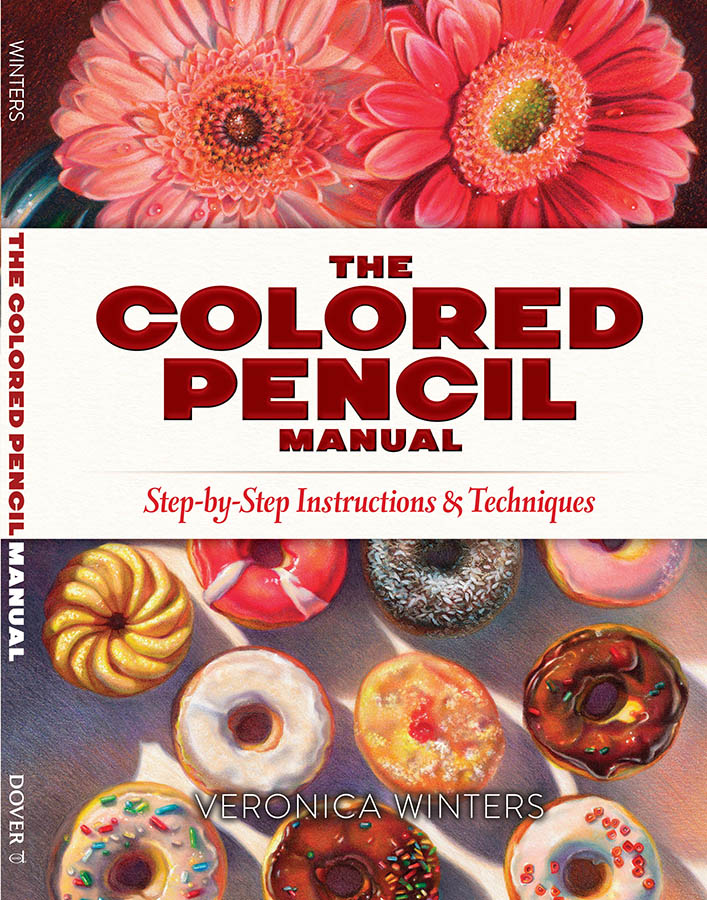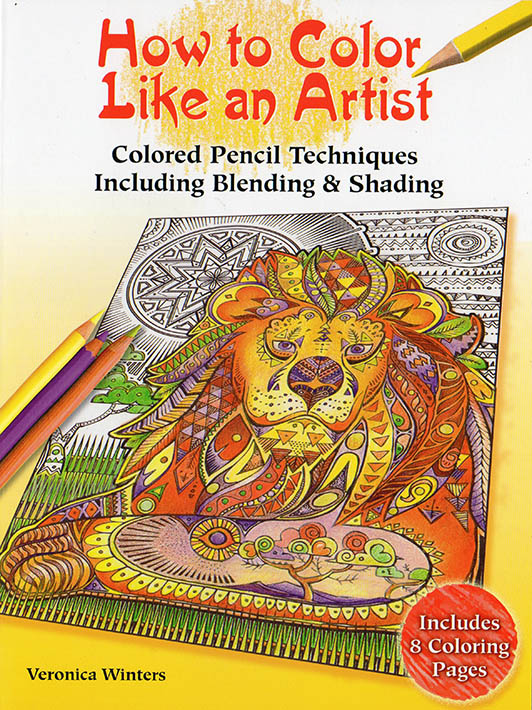This is the excerpt for your very first post.
Tag: colored pencil techniques
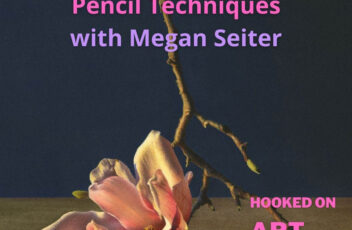
Learn art promotion and colored pencil techniques with Megan Seiter
Megan Seiter is an accomplished, contemporary hyperrealist artist working in colored pencil. A winner of many prestigious awards, Megan creates beautiful floral paintings with a twist. Using the pan pastel and watercolor she draws realistic still life paintings with amazing precision and vibrancy. In the interview she shares her colored pencil techniques, art supplies and gives us valuable tips on art marketing, presentation, networking, gallery representation, and so on. You don’t want to miss this episode!
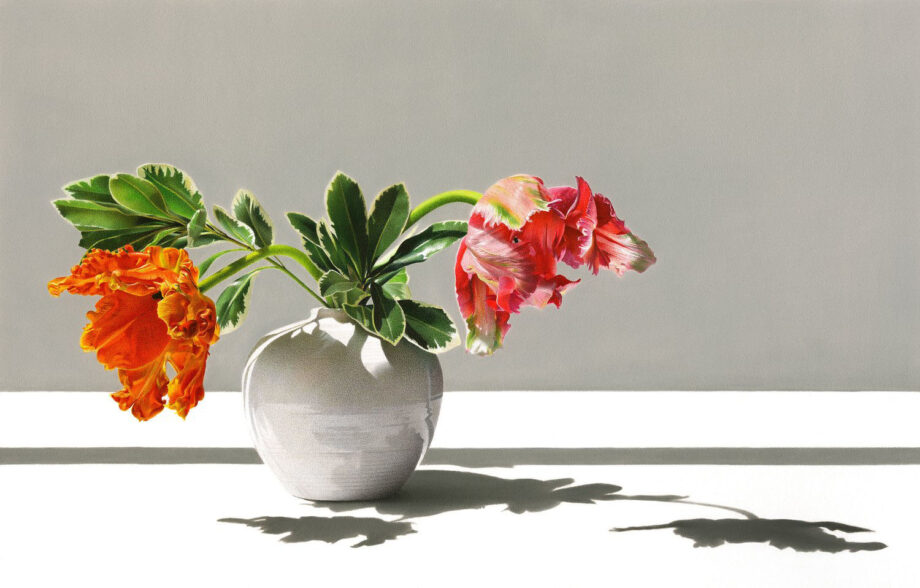
Megan Seiter website: https://www.meganseiter.com/
To watch on YouTube: https://youtu.be/53_ObOt26F8
Subscribe & rate this podcast on Spotify and Apple | Show your support for the podcast: here | Host: Veronica Winters, MFA | veronicasart.com
Podcast: Play in new window | Download
How to use color harmony in colored pencil drawing
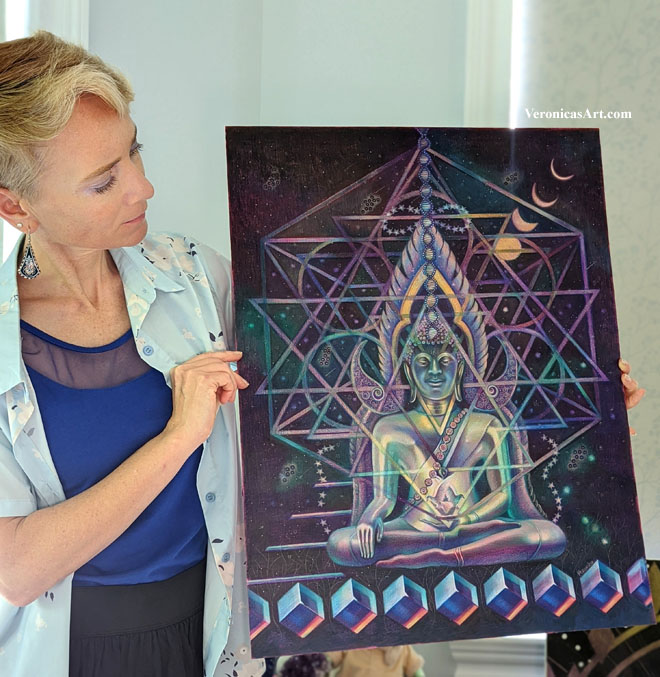
When you begin realistic drawing in colored pencil, artistic aim is to copy what you see in front of you or in your reference. Beginners in colored pencil drawing pay attention to small things like details and textures, and they’re important. However they become truly important only when the basic drawing is in place. If you begin shading one spot and forget about the rest of your composition, you might end up having the colored pencil drawing that has no consistency or unity in color harmony and composition. In this article I’d like to share a few strategies I often employ using color harmony to create mood and atmosphere in colored pencil drawing. Let me give you some ideas how to use color harmony in colored pencil drawing so you can discover your own unique approach to drawing.
Another extensive article on colored pencil portrait drawing and the use of values and color: https://veronicasart.com/realistic-colored-pencil-portrait-drawing-guide/
On YouTube: https://youtu.be/kFdssDSWL3c
Color wheel for colored pencil drawing
While color wheel isn’t everything for colorful pencil drawing, you do need to know these basic definitions and color triads.
Definitions:
- Hue – means color. Red, green, yellow, etc.
- Value – means how light or dark the shading is.
- Chroma – is the color’s strength or color intensity. Colors can be super intense or muted.
- Value – the lightness or darkness of a color.
- Color Intensity – the saturation or purity of a color.
- Neutralized color – the color with less intensity that’s either grayed down or mixed with its complement.
- Local color – the natural color of an object as it appears in daylight (green of the cucumber or blue of the blueberries). Art students see only local colors in objects rather than the colors of light and reflections.
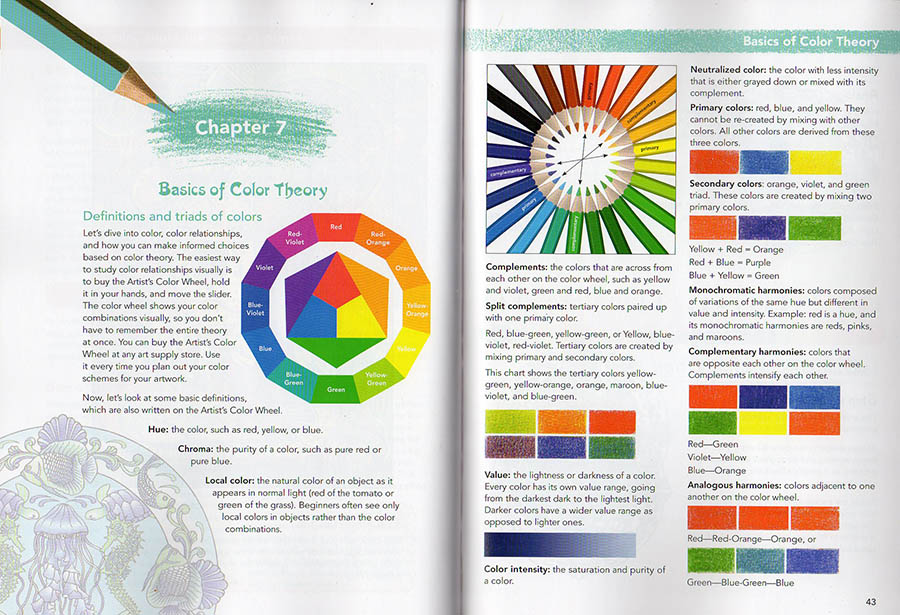
I know it’s difficult to remember all the definitions and I strongly recommend buying a color wheel because it’s visual. You can rotate the dial to see complementary colors, triads, etc. I still use it every time I design my colored pencil drawings. You can buy it at any art supply store or on Amazon.
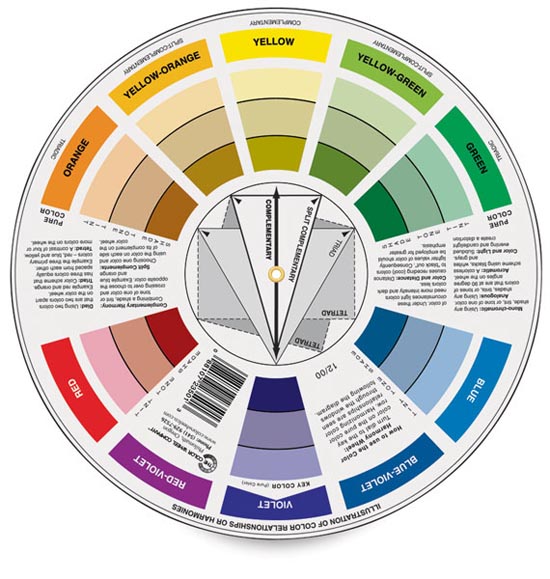
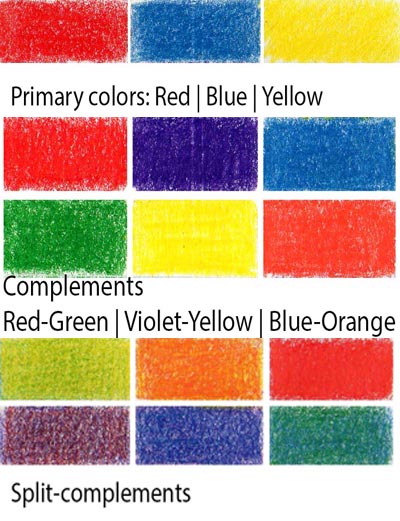
- primary colors are red, blue, yellow. If you put all three primary colors (making them equal in intensity) your colored pencil drawing will be screaming with too much color.
- secondary colors are orange, violet and green. They’re mixed with two primary hues.
- complementary colors in colored pencil drawing – are opposite each other on the color wheel. Complements intensify each other. You don’t want to have all the complements in one drawing for that reason. Red-Green, Violet-Yellow, Blue-Orange.
- analogous colors in colored pencil drawing – are hues adjacent to one another on the color wheel.


- triadic colors in colored pencil drawing –

- split complementary colors in colored pencil drawing – are the colors on either side of a color’s complement. For instance, if your primary color is blue, your split-complementary colors would be yellow-orange and red-orange. Violet’s complimentary color is yellow, and its split-complementary colors are yellow-green and yellow-orange. Blue-purple and red-purple are split complementary colors. Red and green are opposite each other on the color wheel, so red-orange and blue-green are split complementary colors. Split-complementary colors seem to be less color-intense.
- tetradic colors in colored pencil drawing – are a color scheme that uses four colors that are equally spaced around the color wheel. The four colors are made up of two sets of complementary colors, which are also known as double complementary colors. To be honest, I don’t think this color scheme is very useful although you can try it of course. I think it’s too many bright colors competing for attention unless you use as single dominant color in this color scheme.
- monochromatic color harmonies- colors composed of variations of the same hue but different in color intensity and value. Red is a hue. Its monochromatic variant is pink and maroon.

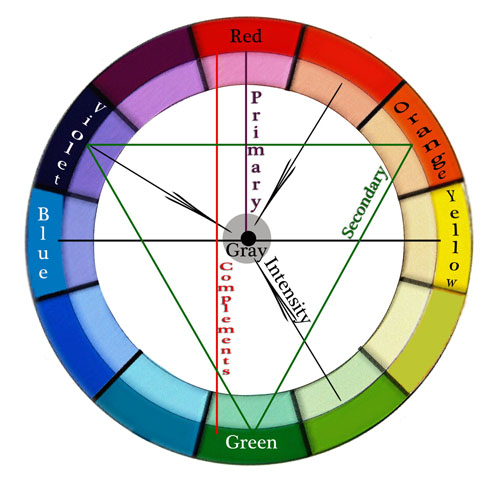
Color Intensity – the saturation or purity of a color. Neutral colors are mostly browns but
Neutralized color – is any color with less intensity that’s either grayed down or mixed with its complement.
Colored pencils don’t mix to grey unlike oil, acrylic and watercolor paint. Therefore you need to use grey colored pencils to neutralize the color so that there are 1-3 dominant colors in the picture, and the rest are neutralized. By using the grey colors you create selective focus as well as beautiful, subtle color variations and texture. In the closeup drawing below you can see grayed down fabric. I shaded with some bright hues first and then added light greys over them.
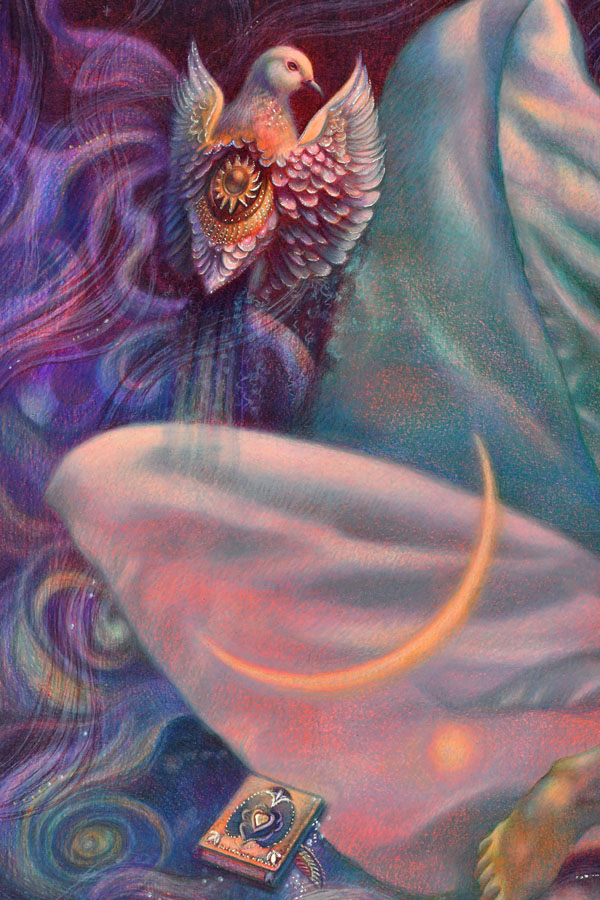
How to use color harmony to create mood and atmosphere in colored pencil drawing
I’d like to share 5 drawing tips on using color harmony to make your colored pencil drawings more realistic.
1. Consider overall color harmony design in your colored pencil drawing
Decide on the overall color theme of your colored pencil drawing. Is it light or dark? Is it monochromatic or in full color? How do you decide? Look at your main reference to see the dominant color. Make that particular color your main focus in colored pencil shading. Everything else should be less color intense to support the dominant color. The color harmony you decide on may not be unique to you but you make it unique by choosing the unusual point of view, stroke or subject. Your choice of a dominant color(s) and contrast determines the mood in the drawing. For example, light blues and pinks look serene, while deep reds and blacks make us feel very differently.
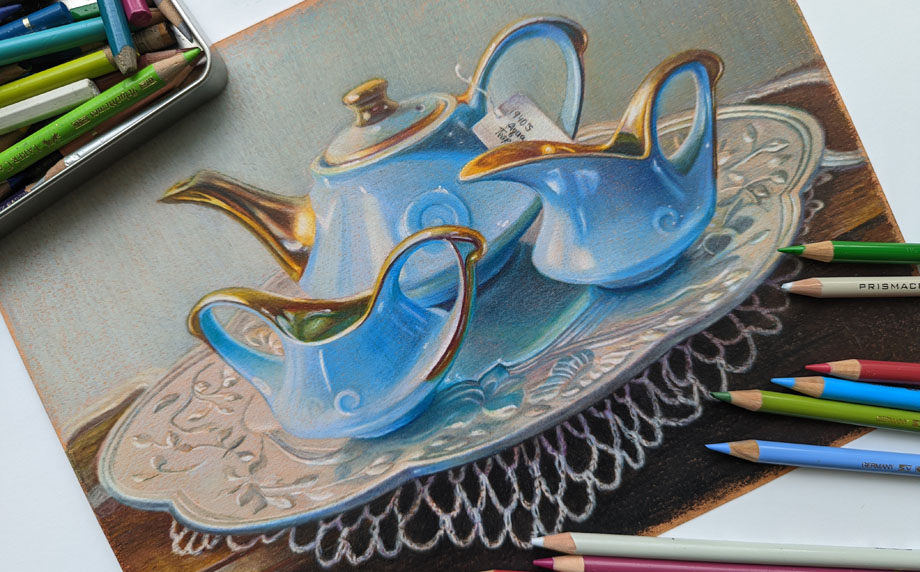
2. Test your colors to decide on the best color harmony
Once you decide on your leading or main colors for your drawing, look at your colored pencils to pick the colors from that color family.
Test your colored pencils on your drawing paper to have consistent color harmony and shading. If you see lots of blue in your reference, test all your blues to see which ones look similar to your picture. Start testing these colors right next to your reference and you’ll notice that some colors are totally off and don’t look right as your main hue. If you have a big box of colored pencils, you have many similar colors. You don’t need to use them all in one drawing because you can adjust your pencil pressure drawing in one blue to get a range of blue tones that’s similar to a number of various colored pencils.
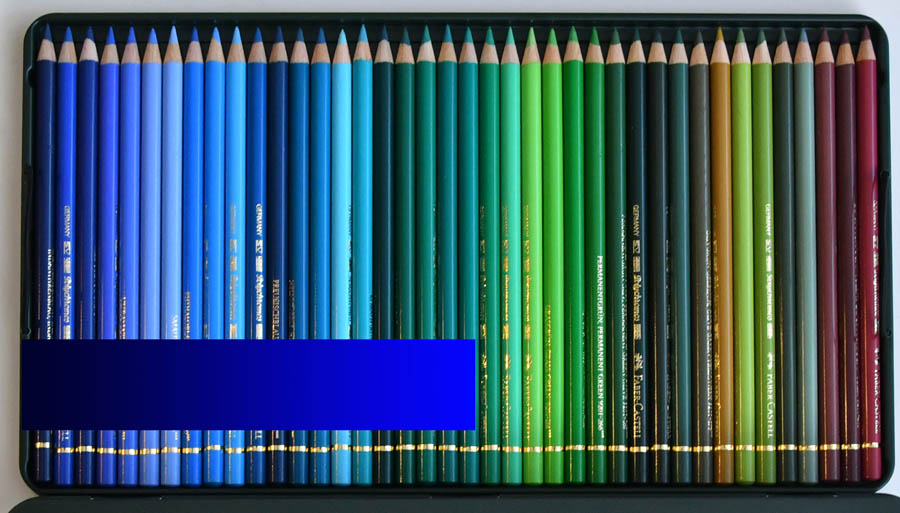
3. Keep it simple to create consistent color harmony
Shade all shadows in one color first. Students love to jump around the picture, using all possible colored pencils to draw the portrait. Instead, pick one color to shade all your shadows first. Colored pencil shading in one color is key to create volume in portrait drawing.
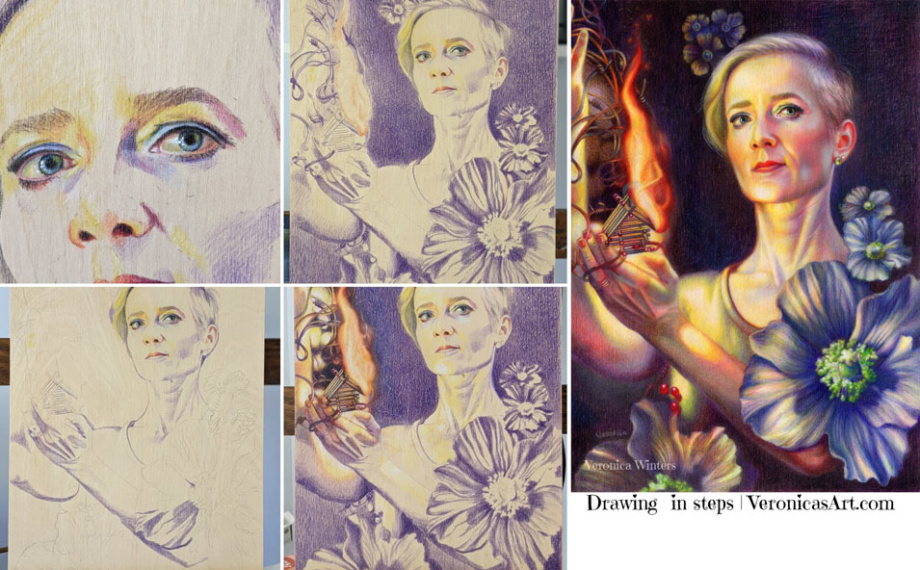
You can make personal colored pencil drawings by focusing on a familiar subject that has unique story line or idea. For example, we all know how the human heart looks like but by designing my own composition and color scheme, I make my colored pencil drawing look different from everyone else’s.
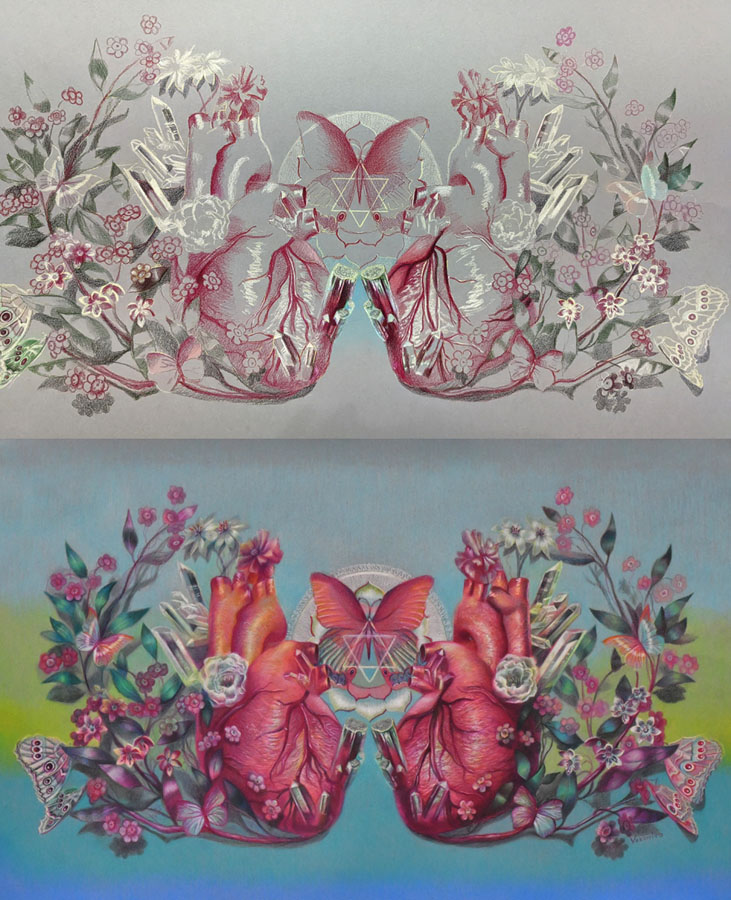
4. Add more tested colors to develop contrast in your color harmony
Most colors are warm and cool. This includes reds, greens, blues and even greys. Some are neutral like browns. You must consider how light or dark they’re. You can’t create a very dark shadow using light pink. You can’t shade around the highlight with a dark blue ( because dark blue is too dark for shading in the light).
Build contrast by having a range of tones in your colored pencil drawing going from very light colors to very dark ones. Of course, not all references call for it but keep it as a guideline for your art and colored pencil shading.

5. Look at your colored pencil drawing from a distance!
You lose all the details by looking at your art from the distance. You do see the inconsistencies in color, awkward shapes, weak shadows and highlights, or undefined edges.
If you consider all 5 rules you will be able to draw a photorealistic colored pencil drawing that has unity in color.
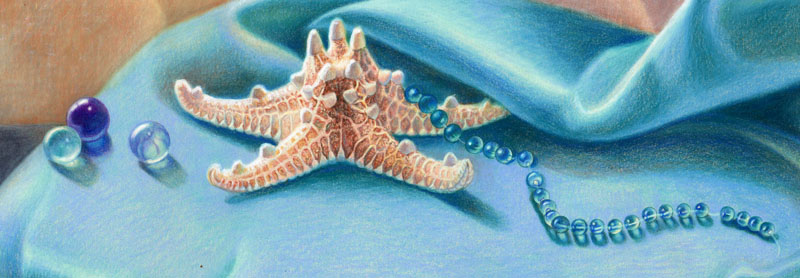
On using color harmony to create unique and personal colored pencil drawings
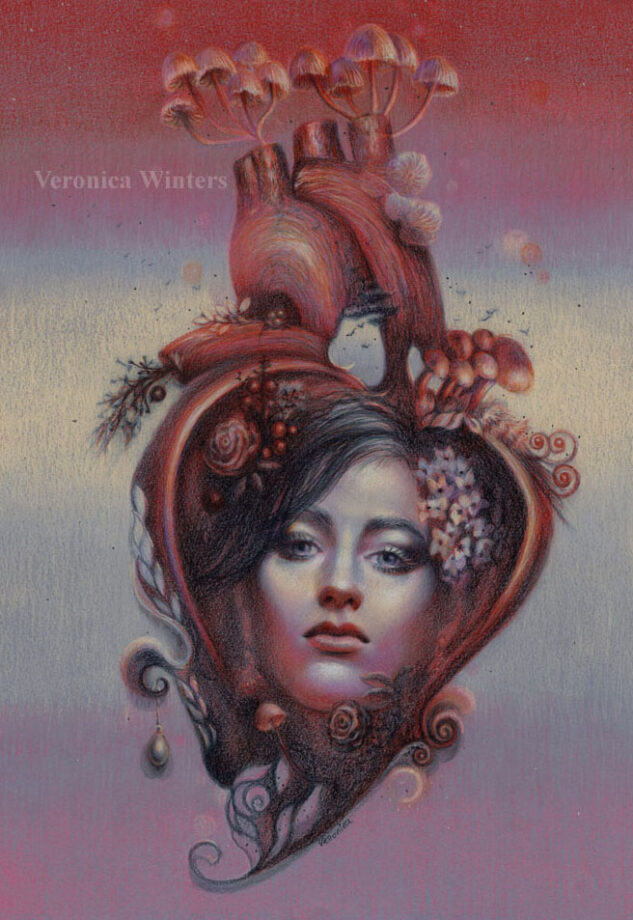
I’d like to share my approach to using color harmony to create unique and personal colored pencil drawings. I think it may be useful for advanced artists interested in colored pencil art.
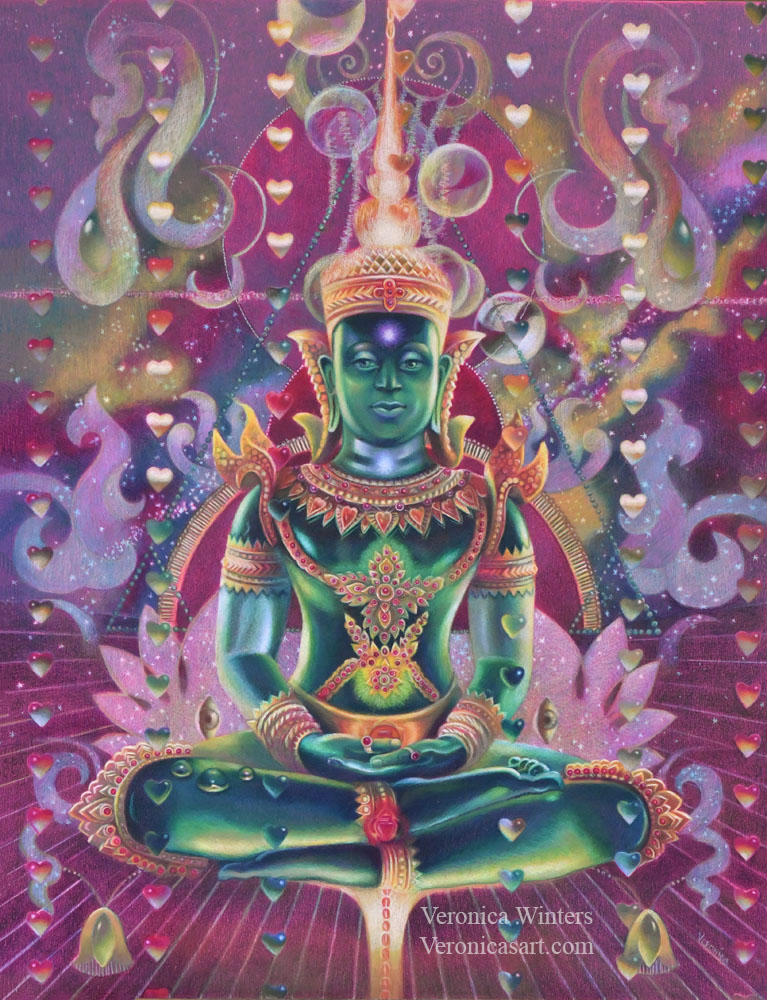
#1 Start with a good idea
Have a good idea in mind what colored pencil drawing you want to create. The idea is a visual story in color, subject or light. It doesn’t have to be the figure. It could be one object displayed in a unique light, rotation or point of view in artist drawing. This is the artistic vision and interpretation of a “boring” object that becomes fun to look at because of your unique interpretation of it. You can train yourself to see the world more creatively by improving your photography, reading, looking at art masterpieces and contemporary art.
I have a folder where I save art to learn from done by other artists. I study unique color choices, composition and subject. Sometimes, the subject isn’t new but the approach to drawing it is totally unique.

My idea starts from my imagination, reading, travel, emotions and thoughts. One day I imagined a seated figure with light passing through his body. I also imagined a rain of hearts above the figure. I made notes of this idea on my phone…I wanted to depict energy, chakras and the colors of the Universe in this colored pencil drawing of Buddha. I came home and started thinking of my references to illustrate this concept.
#2 Pick high-quality references for realistic colored pencil drawing
At first I wanted to paint a real person but I had no references of the pose. So I browsed pictures from my Thailand trip folder. I saw so many beautiful Buddhas and palaces there…And this green Buddha was made of semitransparent stone that looked like glass.
You need to pay attention where your references come from. Sometimes you can’t enter competitions drawing from someone else’s photo. Other times, you don’t have an emotional connection to the picture which is not yours. Or you need to get a photo release that takes time and effort. Personally I try to use my references but when it’s impossible to do, I go to Pixabay to find inspiration and you can too! Pictures are of high-quality and free for commercial use. The only problem with them is that they’re Photoshoped heavily. You must see if you have enough information to draw from as most filters remove warm/cool contrast from pictures.
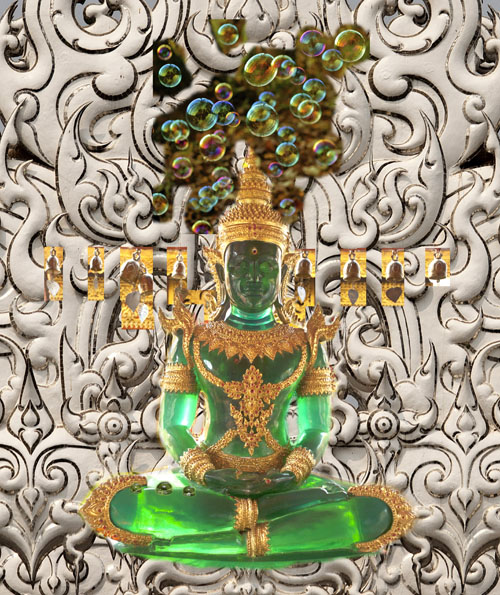
Picking the right references is not enough. They need to “connect” with each other in light and color temperature.
I always design my images around the main subject. I place it first and put smaller shapes around it. In this example, the largest shape is Buddha’s image and my design revolves around the figure. I used the ruler to make straight lines and place the hearts. I cut a heart-shaped template to have a consistent shape in my colored pencil drawing. I use Photoshop to plan the design as much as possible by layering and moving elements around the main figure to arrive at a perfect composition.
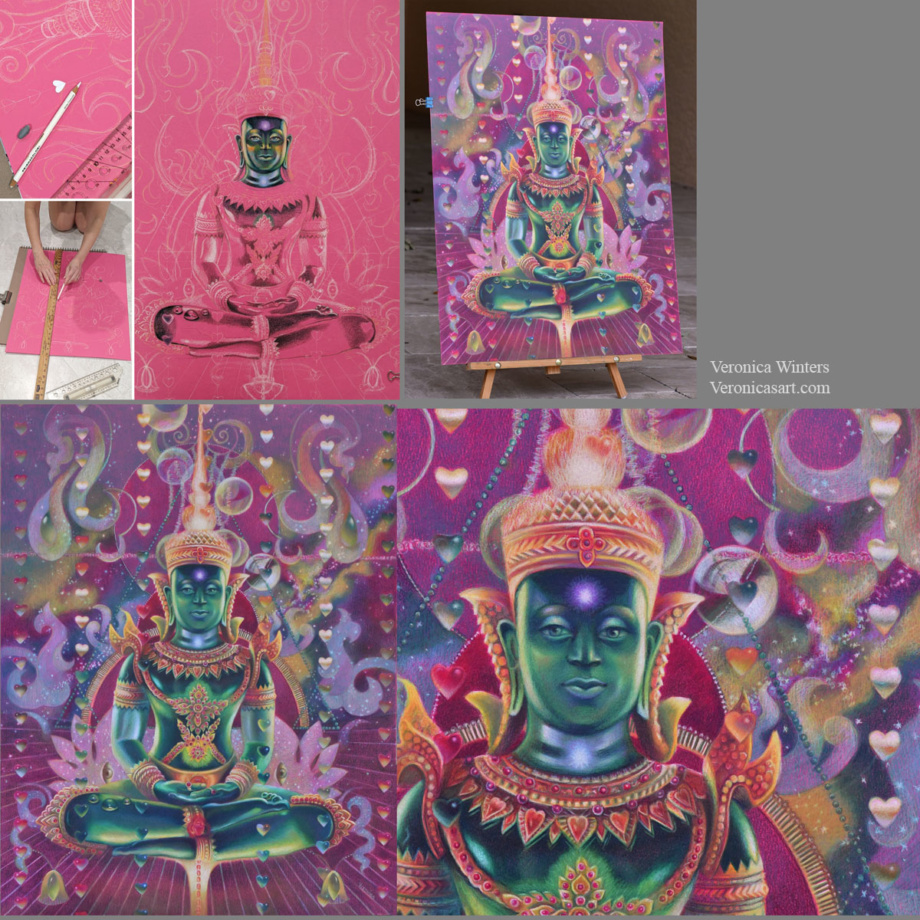
#3 Decide on your color harmony in colored pencil drawing
This drawing has quite sophisticated color scheme. My color harmony is a combination of cool red, green and cool, bluish white.
My tip is to focus on picking 1-2 main colors in your color harmony. It doesn’t mean that you use just two colored pencils for that. It means that you pick the basic scheme, say, ‘yellow-purple’ and design your colored pencil drawing in these colors. The rest of them should be grayed down or become less prominent to support the main hues.
#4 Pick the right toned paper for your specific color harmony
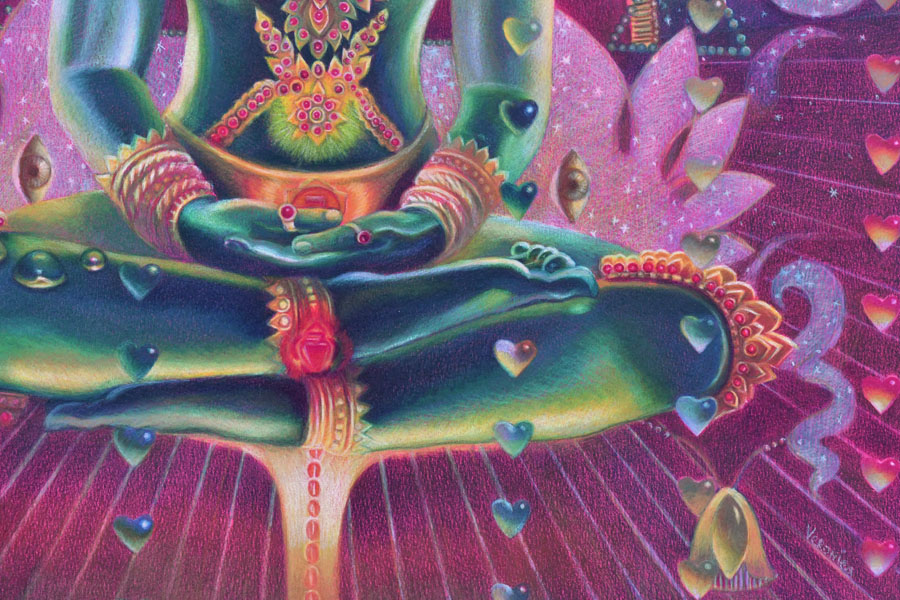
I love drawing on Canson Colorline paper because it comes in a variety of bright colors. The texture is not overwhelming and colored pencils become very vibrant drawing on this paper. (I’m linking to this paper on Amazon but I find that DickBlick has better choices).
Once you picked you main color scheme, say ‘yellow-purple’, look at the color of your drawing paper. In general, don’t draw on yellow paper if your main color is ‘yellow’. Don’t draw on a purple drawing paper if your main color is ‘purple’. Pick the opposite color of paper (like green or orange) and test the colored pencils on it. Test a few colored pencils on it to see how either vibrant or dull they’re. Some colors may disappear on colored paper and others would be super bright.
#5 Have consistent shading in your colored pencil drawing
Begin shading the shadows first using one color. Don’t jump around the picture with many colors. Pick one color and shade all the darks with it. Mark the highlights with white colored pencil (or reserve the space for your highlights if you draw on white paper). Lastly, shade the middle tones connecting the darks with the lights.
Shade with the softest colored pencils, filling in large areas. If you start working with harder colored pencils like Polychromos, it might be frustrating to fill in large space. I save a lot of time and hustle for myself by drawing with the softest pencils like Prismacolor Premier and Luminance or Pablos, and then switching to harder pencils like Polychromos to work on the details in my colored pencil drawing.
Have fun creating your super vibrant colored pencil drawings with beautiful and unique color harmonies!
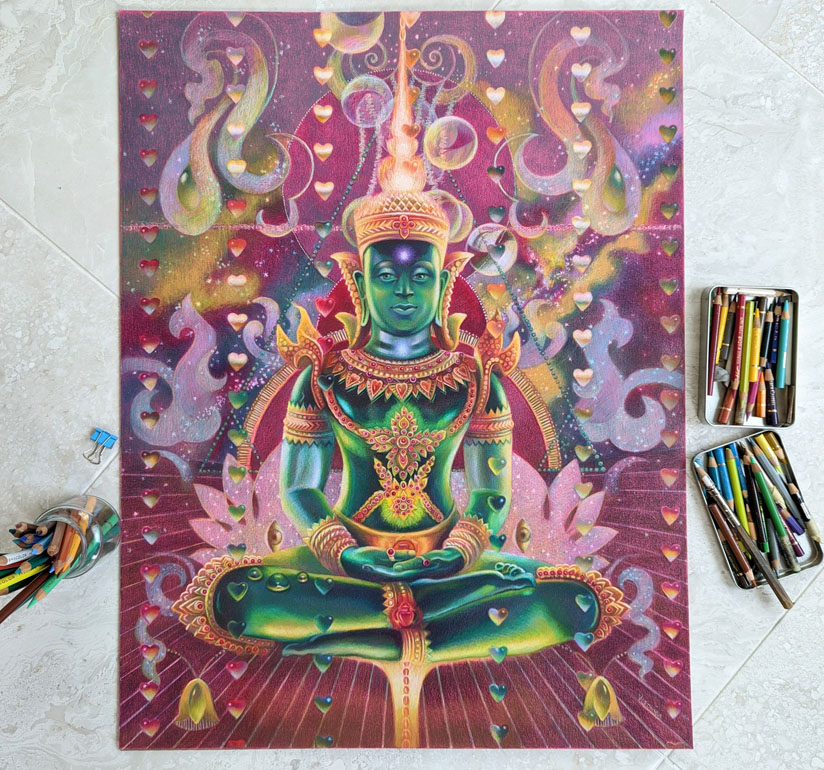
You can learn a lot more about color and color harmonies by taking my video course where I explain the properties of color and how you can design your images around color. I share my secret picking a perfect color scheme for my colored pencil drawings every time.
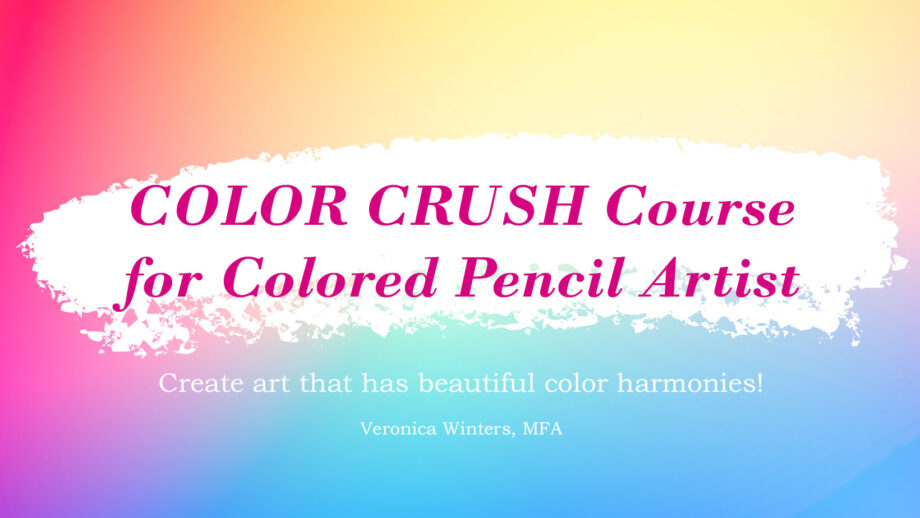
https://veronica-winters-art-school.teachable.com/p/color-crush-course-for-colored-pencil-artist-by-veronica-winters
Colored pencil drawing on Ampersand pastelbord
This board could be an alternative to drawing on colored paper but you must consider the disadvantages working on it in colored pencil.
I like to experiment with different surfaces drawing in colored pencil, searching for the most archival support for my art. Since most people find the colored pencil work inferior to oil painting and even pastel painting, finding the right, archival surface takes the fear away from your clients who wish to buy your artwork otherwise.
This slightly sanded, colored pastelbord by Amersand is similar to the 800 grit Uart paper, which is great for soft pastel painting. Just like the Uart paper, the pastelbord has similar advantages and disadvantages to using it in colored pencil drawing.
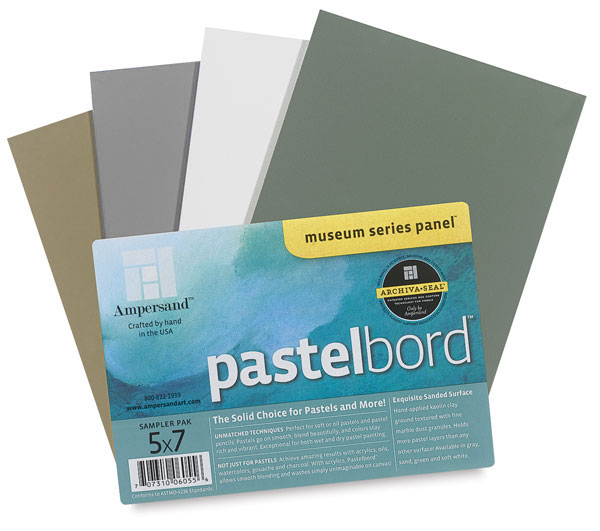
Advantages:
- Ampersand offers a nice variety of colors: sand, dark green, white, gray, and other neutral colors. It takes much less time to shade on colored surface rather than on white.
- Artworks look vivid drawn on this board.
- This archival surface is durable. It doesn’t bend or crumble, stays flat at all times.
- It offers easy display without glass. Just make sure you fix your art beforehand with 3 layers of final fixative. Now you have neither glass reflections nor scare to transport the art!
- The Ampersand pastelbords come in standard sizes that makes it super easy to frame them!
Disadvantages:
- Colored pencil shading on pastelbord is limited. It accepts few layers of pigment.
- It “eats” my colored pencils. If you buy expensive, lightfast pencils, they don’t last long drawing on this surface, and you’d have to replenish them quite often.
- It’s best to use harder pencils on these boards. I use Pablos to fill in all the detail.
- The boards cost more than the average drawing paper, of course.
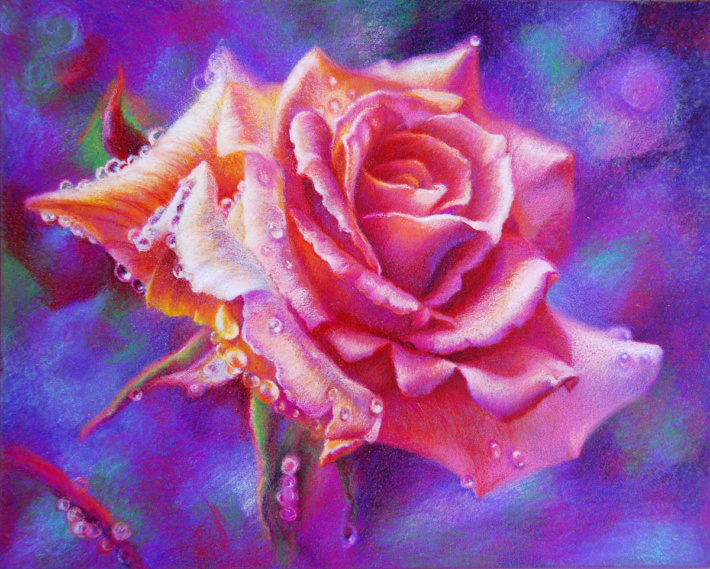
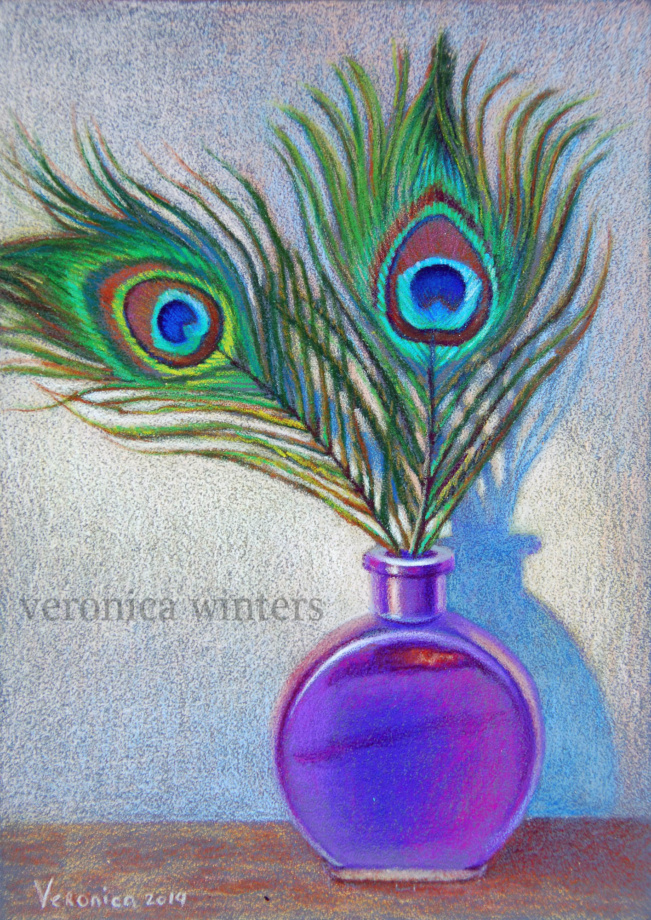
Art Supplies:
Colored Pencils:
- Prismacolor 36: https://amzn.to/3PdrdvY
- Pablo 30: https://amzn.to/3c018Cg
- Polychromos: https://amzn.to/3yoTxF1
- Luminance: https://amzn.to/3P7lkBf
- Caran D’Ache full blender: https://amzn.to/3RkCBrO
Drawing paper:
- Bristol Vellum white paper: https://amzn.to/3nJxeVN
- Canson colorline toned paper: https://amzn.to/3yLd9EO You can buy a wide selection of paper at Dick Blick Art Supplies
- Colourfix primer: https://amzn.to/3WLDdbx
Spray fixative for drawings:
- Sennelier: final fixative https://amzn.to/3yqLOq8
- Grumbacher: working fixative https://amzn.to/3bL7k0X
- DON’T buy the krylon spray!
Other art supplies:
- Transfer paper: white https://amzn.to/3Ittcu7
- black https://amzn.to/3OSTnN5
- Gamsol: https://amzn.to/3yP8nGr
Tombow mono eraser: https://amzn.to/3yOVmMT
I’m an Amazon affiliate. You can find these brands at other art supply sites as well.
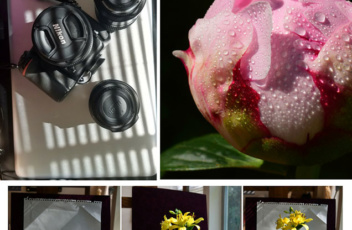
How to take great pictures for colored pencil drawing and painting
If artists paint in figurative realism style, most rely on photography these days. Model fees, time constraints, lighting and studio conditions – all add up in a puzzle we have to organize and manage, if we paint from life. While painting from life is a must for realist artists to get the skill going, perfecting photography is also a necessary skill. Because colored pencil drawing is such a slow medium to work in, almost all artists rely on their references to create art as opposed to drawing from life. Sometimes it takes weeks to complete one colored pencil drawing, and we have to rely on our photo reference to capture story, composition, design, color, and details. That’s why great photography becomes key to artistic success. Let’s master it!
How to take great pictures suitable for colored pencil drawing and painting
It took me years to understand how to see the light turning the form and how to pick pictures, capturing that light. I used to play with pictures from fashion magazines that looked incredibly beautiful, yet they were missing something I couldn’t quite figure out what. Some were OK for black-and-white drawing but none of them were good for oil painting. Why?
All magazine pictures are Photoshoped heavily, getting rid of important information necessary for artists to capture the form realistically. First, the Photoshop filters and presets get rid of warm/cool balance in skin tones, objects and even backgrounds that we normally see in nature. Second, copyright is a big deal, and we can’t use such images for our art to create the originals. Thirdly, a lot of times the “connection” between the subject and artist is missing. We have no emotional attachment to the photo that’s not ours that results in unfinished or poorly executed art.
Photo equipment:
My greatest investment into my studio equipment is my camera Nikon D500 with the interchangeable lenses. The quality of lenses is even more important than the the body itself. The higher the quality, the better the outcome. Over the years I bought several lenses for different tasks.
- Nikon 105 mm- micro lens for extreme close up photography
- Nikon Nikkor 85 mm – for portrait photography (that gives no distortion)
- Sigma 12-24 mm – for interior photography (that has a wide angle with no distortion)
- Nikon Nikkor 18-200 mm zoom lens – for general photography ( while it’s my heavy duty use lens, it gives the most distortion and requires extra work in Photoshop to even out the perspective, etc. Zoom lens have the most distortion especially noticeable in cityscape photography).
I also have an inexpensive Westcott reflector kit with multiple colored surfaces (silver, gold, white) that I use for portrait photography at times. I use the reflector to bounce the natural light back onto my model or object that removes harsh shadows or adds more light into the shadows.
You can also consider buying a backdrop equipment that I don’t need personally because I shoot models in natural environment, and when I do still life photography I make my own light box set up that you’ll see in the article below.
Besides having excellent equipment you also need to have a good eye to take great pictures, which you develop by studying the art of others and practicing your photography skills.
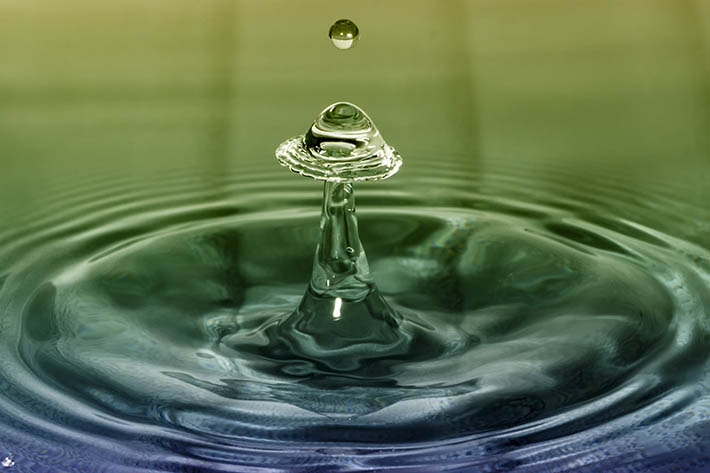
Advantages of Mastering Photography:
- It develops your originality and vision.
- It forces you to extrapolate and focus on what’s important in busy environments.
- It teaches you to see how light shapes the form
- The artist is the sole designer and creator of artwork beginning from the very first step of photography.
- It’s a forgiving medium, giving you many chances to practice at all times. You become attuned to cropping and balancing techniques that artists traditionally use in their paintings.
Disadvantages of Using Photography:
- It often flattens out the form to such a degree that you have a hard time re-creating the volume. That’s why it is best to start taking pictures with one directional light source that gives you definite lights and shadows.
- Camera makes its choice. Even the best cameras don’t capture what you see as an artist, which involves emotion. By working from a picture, artists analyze the subject rather than respond to it freely.
- There is a lot of distortion in the images depending on the lens and camera you use that is obvious in cityscape photography or in pictures of geometric objects. The same distortion is present in pictures of people or fruit, or whatever subject you have, but our eye doesn’t catch those distortions as quickly as we notice those in linear and geometric forms. Those “unseen” distortions will travel to a student’s drawing when the artist transfers the outlines rather than learns to sketch freehand from his reference.
- You may have problems with exposure. Use the HDR (high dynamic range) function on your phone to level out the exposure. HDR combines two or three pictures into one automatically, giving you a single balanced shot. HDR function is very handy when the sky looks too bright or the background is so light that it makes your subject appear too dark. • You can take good pictures with your phone, although the quality won’t be the same as shooting with a DSLR (digital single lens reflex) camera. If you shoot with your phone, zoom in on your object as closely as you can. That will blur the background, giving your subject a boost in color and texture.
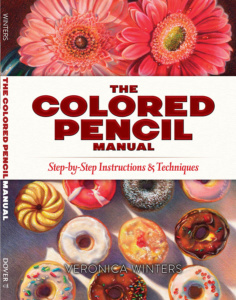
Subjects

First of all, decide what you favorite subjects are, and isolate them from busy environments. Here are some ideas for your photography. Close-ups of textured subjects—these can be the most fun, unpredictable subjects for your photography and art.
They can be reflective surfaces and reflections, fabric patterns and lace, rusted door locks, wood grain, colorful feathers, candy, sliced fruit, marbles, flowers, kitchen utensils or tools, and even mechanical parts of clocks. Other popular subjects are glass; portraiture; animals, birds, and pets; food; florals; seashells and sea life; trees and landscapes.
Properties of light
Your goal of shooting in the “right lighting conditions” is to beautify your subject and to bring the best out in it. Ask yourself what attracts you to this object. It could be a specific texture, transparency, color, or an abstract pattern of light and shade that you see. You need to figure out what you love about your subject and how you can highlight its most attractive qualities in a specific light. If your subject looks boring in a picture, chances are that the lighting conditions were boring at the time it was shot.
Light temperature:

The light can be either warm or cool. In the beginning it may be difficult to spot the difference, but if you ask yourself if it is yellowish or bluish, it makes more sense. Fluorescent lights tend to be cooler, while the tungsten lights are warmer. In nature, you see a beautiful golden light twenty minutes before the sunset. The light temperature affects how you see the colors and how they unify everything in the image. You also use the light temperature to understand the color on your subject: if the light is cool, it gives cool lights and warm shadows. If the light is warm, it gives you warm lights and cooler shadows.
Quality of light:
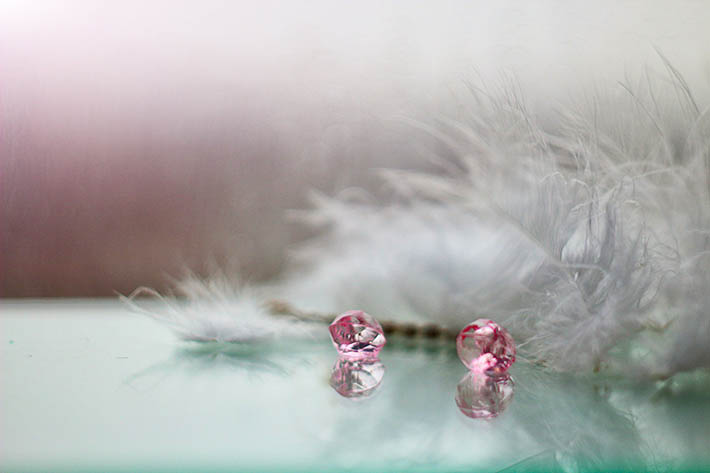
Natural light is the most beautiful light we have as artists. While the soft, diffused light may give the artist beautiful, soft skin tones in portrait photography or a dream-like mist in a landscape, this light is difficult to master for a beginner who is shooting pictures of glass, fruit, or flowers. The glass loses its sparkle and reflections, the fruit doesn’t have the volume or shadows, and flowers appear quite bleak. That’s because the diffused light gives you very soft, almost unnoticeable shadows and highlights, which, in turn, are difficult to reproduce in art for a student. Whatever the light temperature is, the goal is to avoid getting monotonous images that often happen in diffused light situations when you have an overcast sky.
Light direction and shadows:
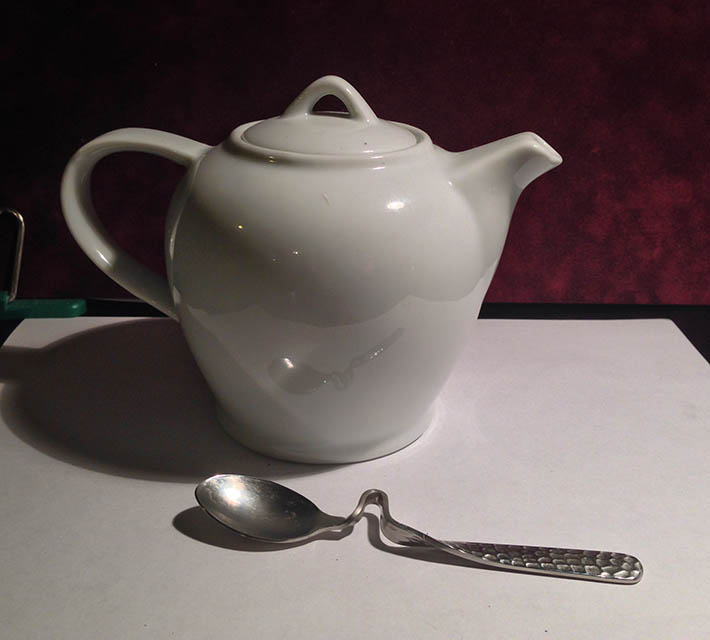
The most effective way to study the light on a form is to have a singular, strong directional light source set up at 45 degrees, which is often called Rembrandt lighting. This light direction creates beautiful highlights and shadows that will add dimension to your objects.
If you go to an atelier school of classical painting, you’ll see students draw from plaster casts and still lifes set under a single directional light that doesn’t change direction for the entire drawing process. Such setups are vital to an artist’s understanding of how to turn the form. So when you take pictures inside, find and focus on one primary light source, like a table lamp, and consider its strength. Look at your subject and find definite highlights and shadows on and under it because it will give you this 3-dimensional quality you want to re-create in your drawing.
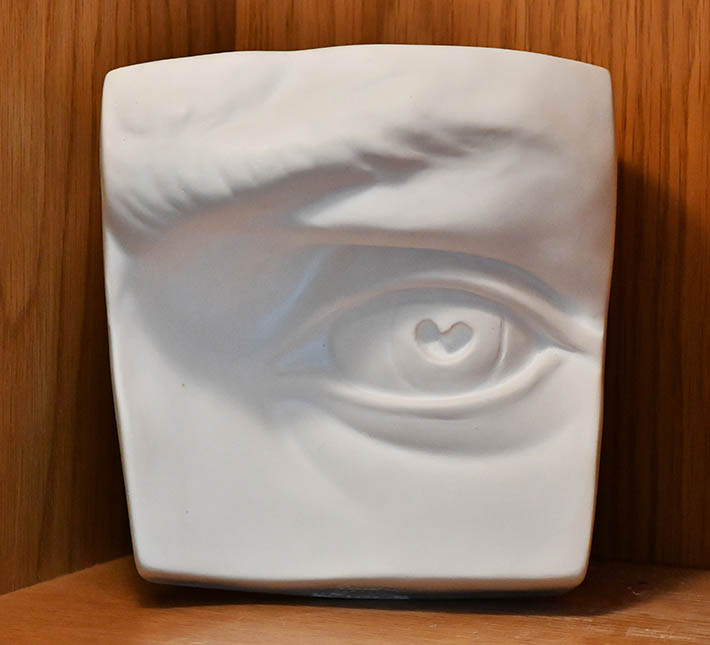
In my video course I teach how to take your colored pencil drawing to the next level including set up and photography. Watch a video preview here:
Depth of field:
Shallow depth of field allows you to capture your object in a sharp focus, blurring the rest of the image. A soft background supports the focal point rather than competing with it. When you have a high depth of field set at f16 on your camera, everything is in focus, and oftentimes the image will look too busy and indistinguishable from other elements in the background where everything competes with each other. Always think what you’d like to focus on, then make it your priority by zooming in or fixing the depth of field.
Zoom in, keep it simple & use negative space as a design element:
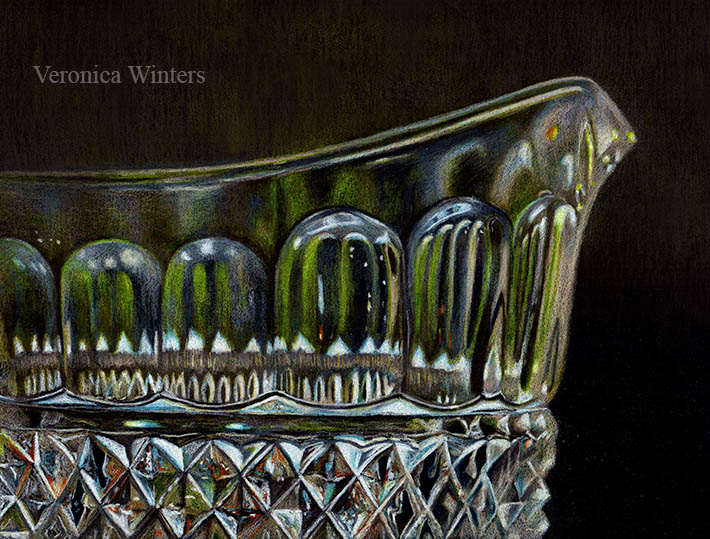
Background affects the edges and creates abstract shapes. As a beginner, stick to plain backgrounds to isolate your subject and to show contrast. After a while you can start playing with the color and complexity of your negative space as well.
Use backgrounds and boxes for staged photography:
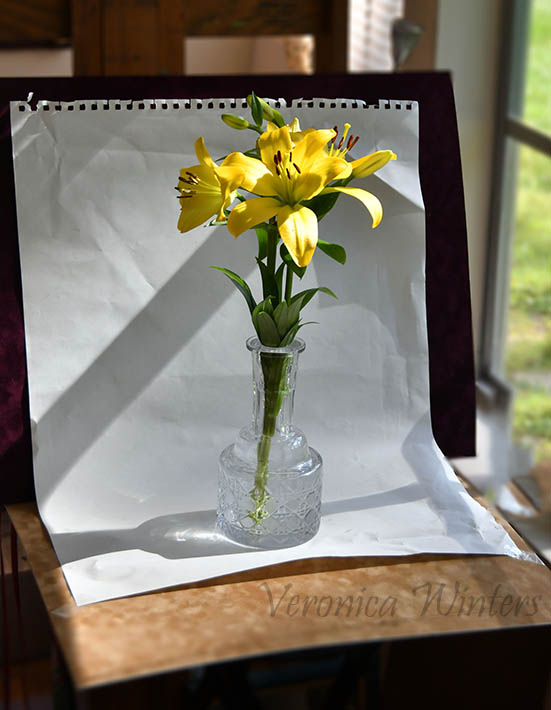
If you don’t want to buy a light box, you can make a very simple setup next to your window. Use colorful but plain matboards, fabric, or paper as your choices. The result is a single image with a beautiful, natural directional light, a shadow, and a white or color background all around it.
Avoid flash photography:
Flash destroys the natural flow of light and its shadows. It flattens out the object and gives you strange, unnatural colors. Professional photographers know how to rotate their flash unit to get the right position of the flash, but most of us don’t!
Prioritize values over color:
When a student is learning to draw and paint, it is difficult to translate hues to tones. Convert your photos into greyscale to see values. Most students end up with middle-toned drawings because of weak contrast.
Well, I hope this article helps you to shoot beautiful pictures as references for your art!
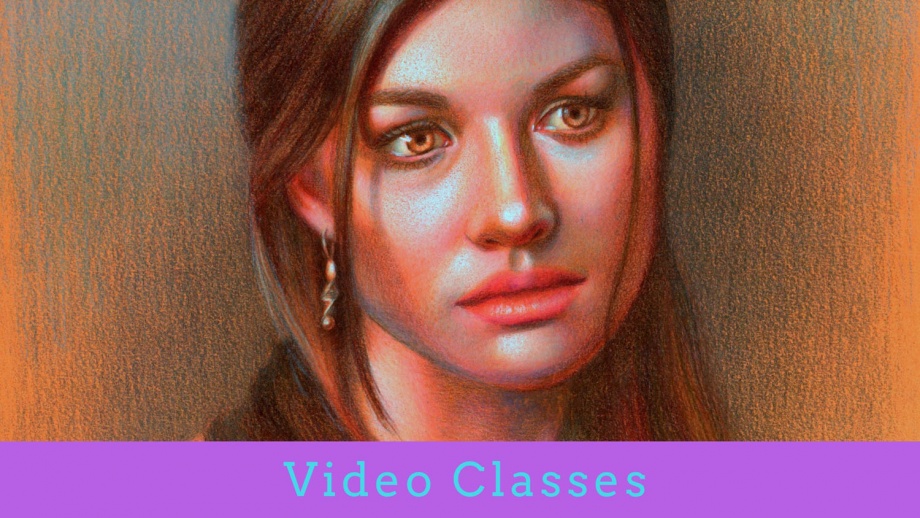
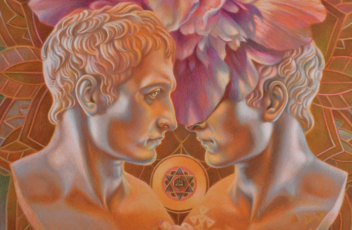
The One Colored Pencil Technique you must master to create Photorealistic Colored Pencil Drawings
Colored pencil shading techniques
If your aim is to create photorealistic colored pencil drawings, you need to master the very basic drawing concepts, which includes colored pencil shading. Whatever subject you draw in colored pencil, it’s important to control your pencil pressure to achieve realistic result.
Pencil pressure
For instance, when you press on your pencil very lightly, you won’t be able to achieve rich darks or create enough contrast in colored pencil drawing. At the same time if you’re heavy-handed, your drawing may become too muddy or overworked quickly. So it’s all about finding that perfect balance in colored pencil shading.
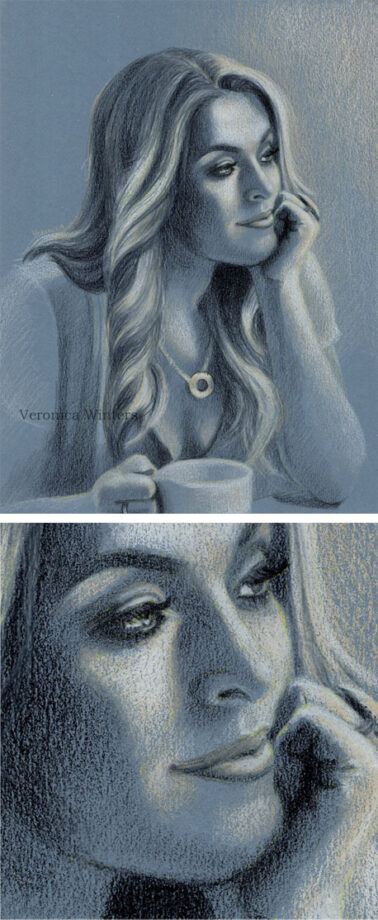
You do need to increase your pencil pressure in colored pencil drawing when:
- you try to blend some areas with light pencils shading over the dark layers
- you blend the areas around the highlights
- you want to build up contrast in progression
- or when you work on textured paper and have to do lots of filling of a paper’s tooth.
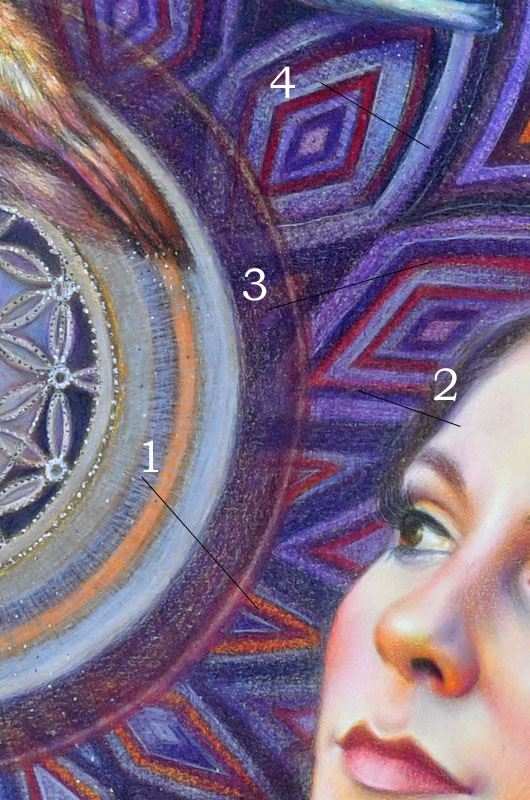
#1 I shaded with white colored pencil over the dark area using a unique stroke to create the texture I wanted. While some dark is showing through, I applied the white colored pencil with medium pencil pressure.
#2 I did a lot of shading with colored pencils on the light side of her face using a very heavy pencil pressure to raise the lights as much as possible. White colored pencil sits on top of all other light colors I shaded with there.
#3 I shaded with a light pencil pressure to create that purple circle so that some previous layers still show through it.
#4 I used a very light grey colored pencil to shade over the purple with heavy pencil pressure. It lightened up and blended the area.
Check out available video courses here: https://veronica-winters-art-school.teachable.com/
Colored pencil techniques: colored pencil shading in white and off-white colors
When you work on your colored pencil shading using heavy pencil pressure, the area becomes very waxy and so filled with the pigment that you can’t layer more color over it. That’s the desired outcome. However, if you feel like you want to add even more color to that area, spray it lightly with a fixative. Wait for it to dry and shade over it again.
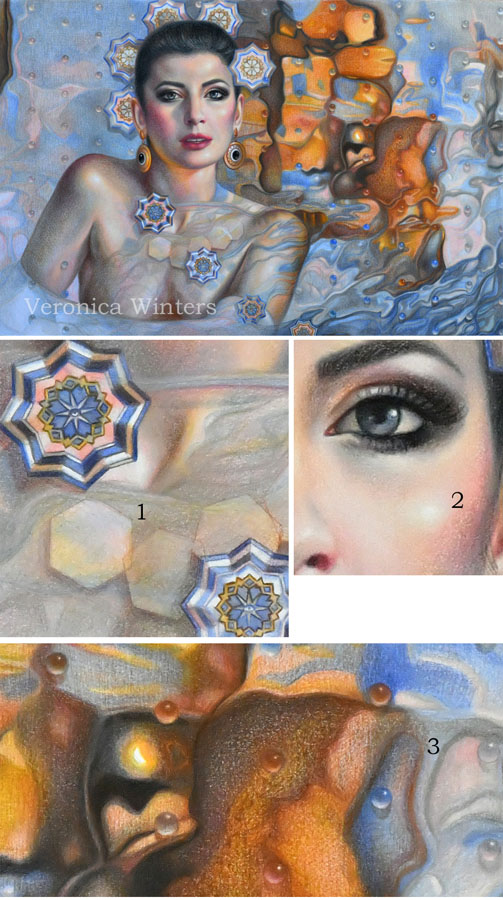
#1 I used white colored pencil and medium pencil pressure to lighten up the geometric shape. It also blended it.
#2 I used a very soft white colored pencil (Luminance or Prismacolor Premier or Pablo) to shade around the highlight leaving the highlight itself uncolored. If your colored pencil is hard this kind of blending is difficult and incomplete.
#3 I used soft, light grey colored pencil and a very heavy pencil pressure to blend the area shading with colored pencils.
I hope that this article helps you in your creative colored pencil drawing and you also find some new colored pencil drawing ideas. Controlling your pencil pressure shading with colored pencils is a must. So next time you draw, pay attention how you press on your colored pencils and observe what results you’re getting. If you’d like to learn more about colored pencil drawing, check out these art books or watch my free videos on YouTube. You may find your answers there. 🙂
Art supplies on Amazon
- Drawing pad, bristol vellum
- Kneaded eraser
- koh -i-noor drawing paper, colored pencil
- Tombow mono eraser
- Drawing fixative
- Sennelier fixative for charcoal and pencil has a super fine spray mist, matte, high-quality
- Gamvar varnish for oil paintings, satin
- Brush for varnishing oil paintings
- Color Wheel
- Canson Colorline drawing paper is available in many colors and various thickness. You might find better choices at art supply online retailers
- Molotow metallic marker, gold
- How to color like an artist, coloring book for children and adults
- The colored pencil manual, art instruction book
If you’d like to connect with me:
4 best colored pencil shading techniques
Learn how to create depth and dimension in your colored pencil drawings with these top four colored pencil shading techniques. In this article you’ll discover the most useful shading techniques that you can apply to any subject you draw. I also share some necessary tools that can help you create colorful pencil drawings.
Colored pencil shading techniques in art help create the illusion of depth, volume, and form in a two-dimensional artwork.
Before you begin drawing, place your paper on a hard and smooth surface. You can use the backing from your drawing pad. Don't draw on soft surfaces under your paper because your drawings will lack definition. It's much easier to create tight shading and sharp edges drawing on paper that has a field sketch board underneath it. They come in different sizes under many brands.
#1 Crosshatching in colored pencil drawing
Crosshatching in art definition:
Crosshatching is the most useful colored pencil shading technique that’s used to create a variety of effects in colored pencil drawings including volume creation and blending. Hatching involves creating parallel lines or strokes to indicate shading. The lines can be closely spaced or widely spaced, depending on the desired effect. By varying the density and direction of the lines, different values and textures can be achieved.
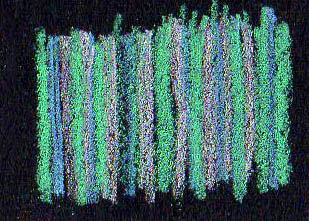
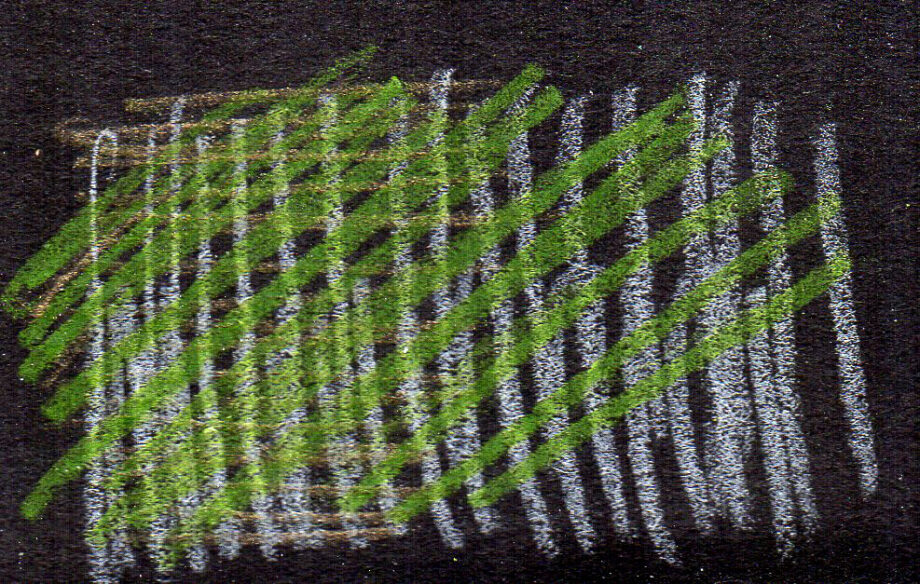
Cross-hatching is similar to hatching, but it involves layering sets of parallel lines in different directions. By overlapping the lines, darker and more complex shading with colored pencils can be achieved, creating depth with colored pencils. When I crosshatch the lines, I rotate my paper often to create tight shading with depth and volume. If you shade every object in one direction, you’ll make it look flat lacking volume. Crosshatching is the most useful shading technique for beginners and advanced artists.
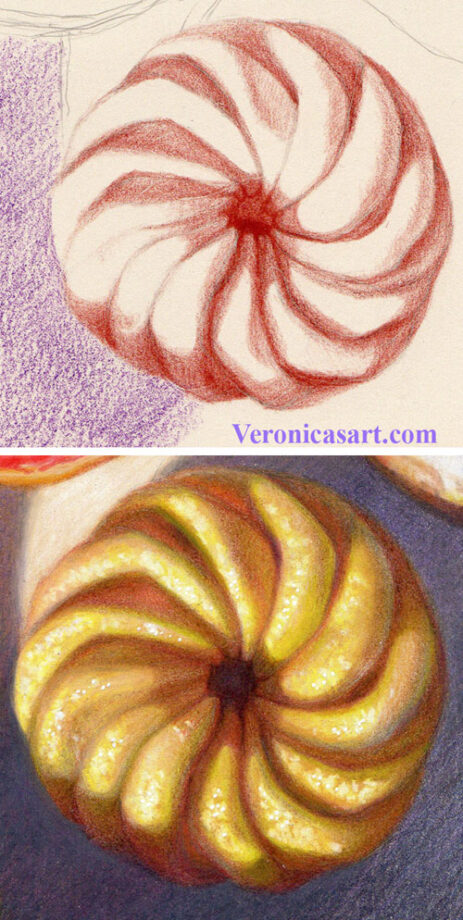
#2 Colored pencil shading with tiny circles
I often use shading with tiny circles to blend colored pencils, to soften the edges around the highlights, to make transitions between the tones, and to add colorful dimension to my art. This meticulous method of shading with tiny circles allows for precise control in color application. Because we see no visible lines, shading with tiny circles allows artists to create subtle variations in light and shadow, adding dimension to colored pencil drawings.
Pencil pressure is important using this shading technique. The more pencil pressure you use, the more blended the surface will be. Usually, art students look for special tools and blending techniques for colored pencils, but most blending can be done with simple shading with tiny circles, drawing on Bristol Vellum paper!
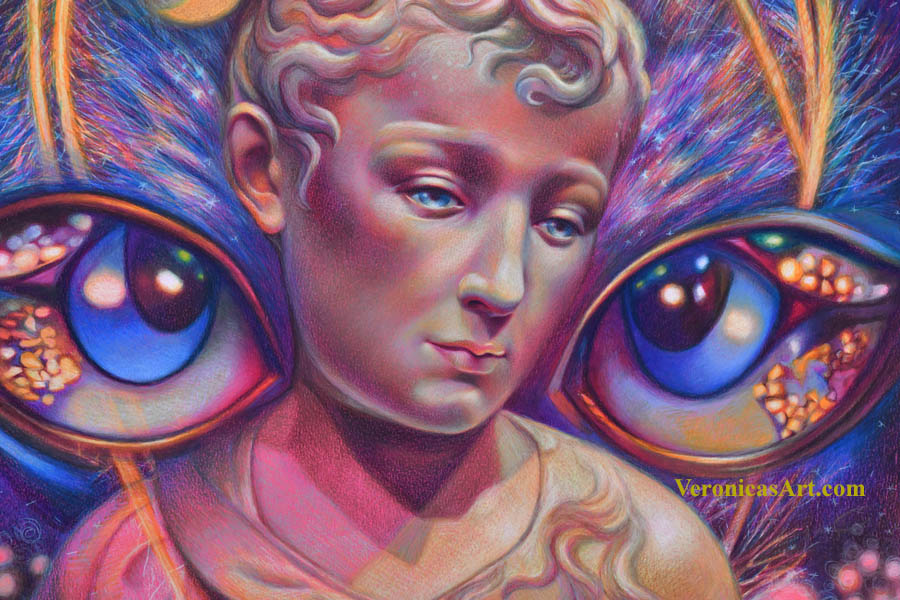
#3 Creating contrast with strong and soft edges in colored pencil drawing
Creating depth with colored pencils involves artistic control of edges. Art students shade everything the same way. Therefore, art lacks contrast and definition. I make a creative decision what I want to have in focus and out of focus. This is where the edges come in. To define the edge you must use a very sharp point of colored pencil. Re-define and outline the sharpest edges during your entire shading process because they tend to disappear during shading with colored pencils. Step back from your drawing to see if they pop or not. I usually place sharp edges in my focal point.
Not everything must have a strong edge. Some edges must remain soft and muted as we see them in real life. Therefore, I intentionally blend, soften or crosshatch some of the edges to keep them out of focus. It’s one of the most useful colored pencil shading techniques.
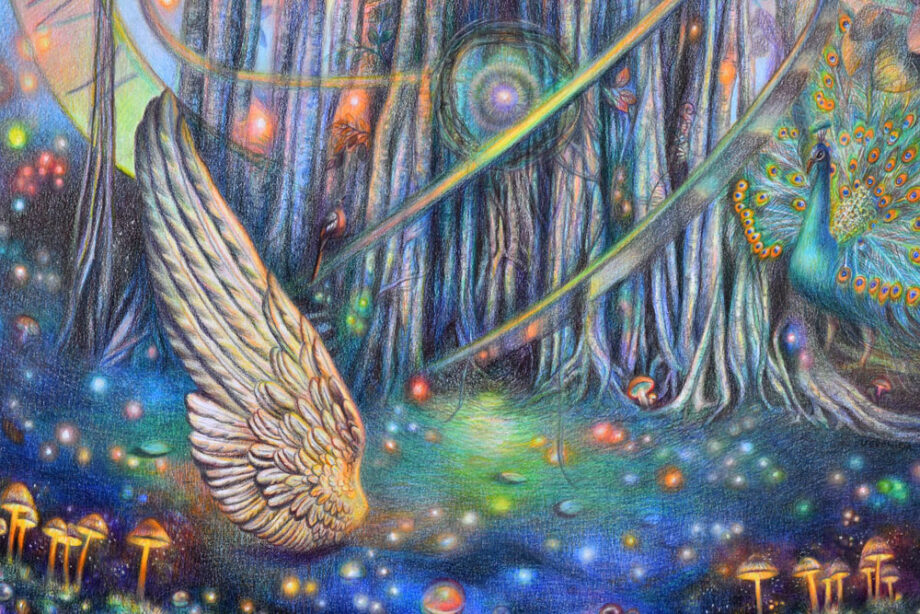
#4 Shading with greys to blend the colored pencils
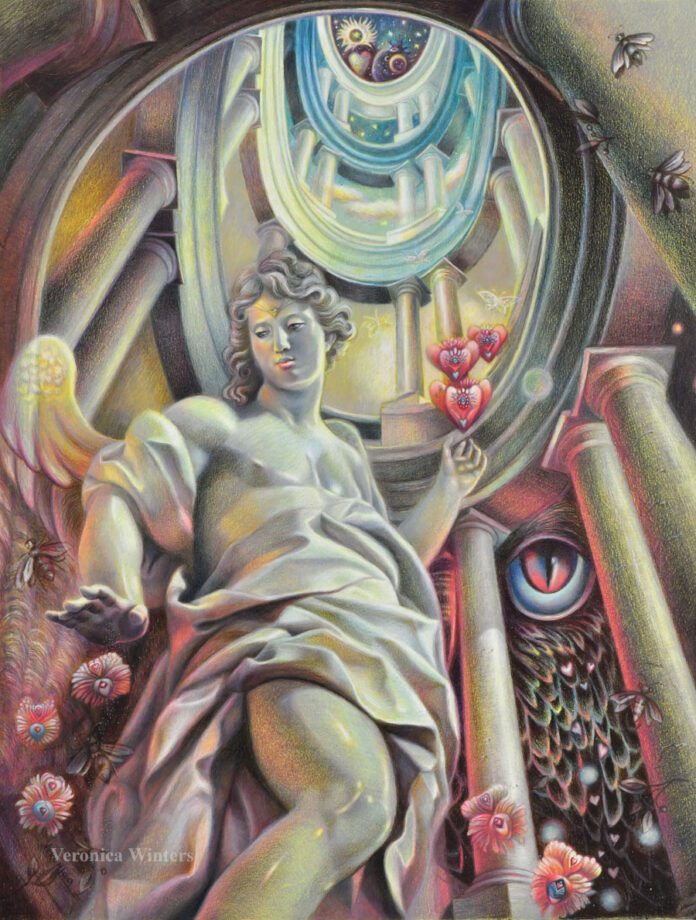
I love adding dimension to colored pencil drawings by shading with grey colored pencils over the previously applied color layer. It does two things. This shading technique does awesome blending without the use of solvents or time-consuming blending with pencil blenders. Second, this shading technique adds new dimension to color in art. By making some areas less bright, I’m able to control and bring forward major colors that are part of my overall composition and design. This is one of my favorite shading techniques for portraits because I can create depth with colored pencils, shading over local colors.

Normally I don’t use the stippling technique because it’s too time-consuming but if you have a subject calling for it, by all means use it. All four shading techniques can be used in colored pencil drawing of any subject – landscape, still life, portrait, etc.
If you’d like to learn more about colored pencil techniques, check out the video courses here: https://veronica-winters-art-school.teachable.com/
Happy drawing!
Art supplies:
- Drawing pad, bristol vellum
- Kneaded eraser
- koh -i-noor drawing paper, colored pencil
- Tombow mono eraser
- Drawing fixative
- Sennelier fixative for charcoal and pencil has a super fine spray mist, matte, high-quality
- Gamvar varnish for oil paintings, satin
- Brush for varnishing oil paintings
- Color Wheel
- Canson Colorline drawing paper is available in many colors and various thickness. You might find better choices at art supply online retailers
- Molotow metallic marker, gold
- How to color like an artist, coloring book for children and adults
- The colored pencil manual, art instruction book
Pros and cons drawing on wood in colored pencil
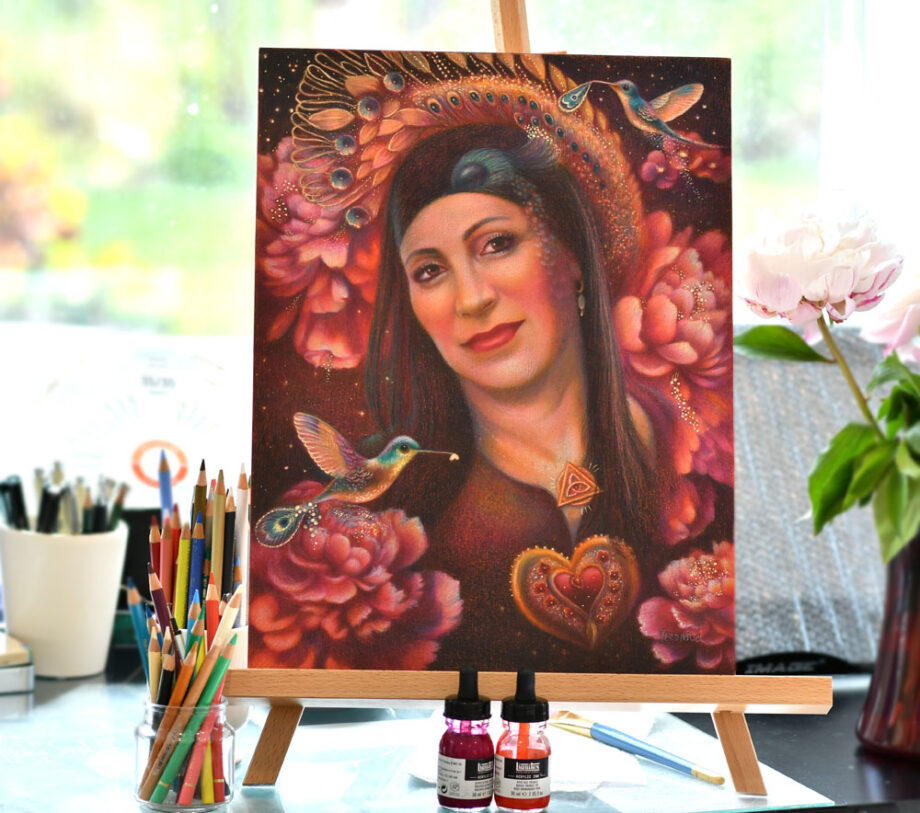
In this article, I’d like to share my experience doing colorful pencil drawing on wood. I list both advantages and disadvantages working on wood.
The advantages of colored pencil drawing on wood
- The panels are very durable and stable. They resist warping.
- The panel has a 1-inch depth, which is good for wall display.
- Wood panels prevent warping.
- The panels look like paintings that aid professional presentation and make people more excited to purchase art. Drawings on wood don’t need a mat.
- Because the wood surface is so stable it accepts many materials and techniques in addition to the colored pencils. For example, I tested it adding acrylic inks to its surface. I also added Fine Tec iridescent colors with a tiny bit of water, various markers, acrylics, resin, glass, diamond dust, glitter. The possibilities are endless!
- The wood panels accept layers of color when primed with the right primer for drawing that I list below.
- You can play with the negative space of the wood panel by not coloring the entire surface, rather allowing it to show in art because it has it’s own pattern and color.
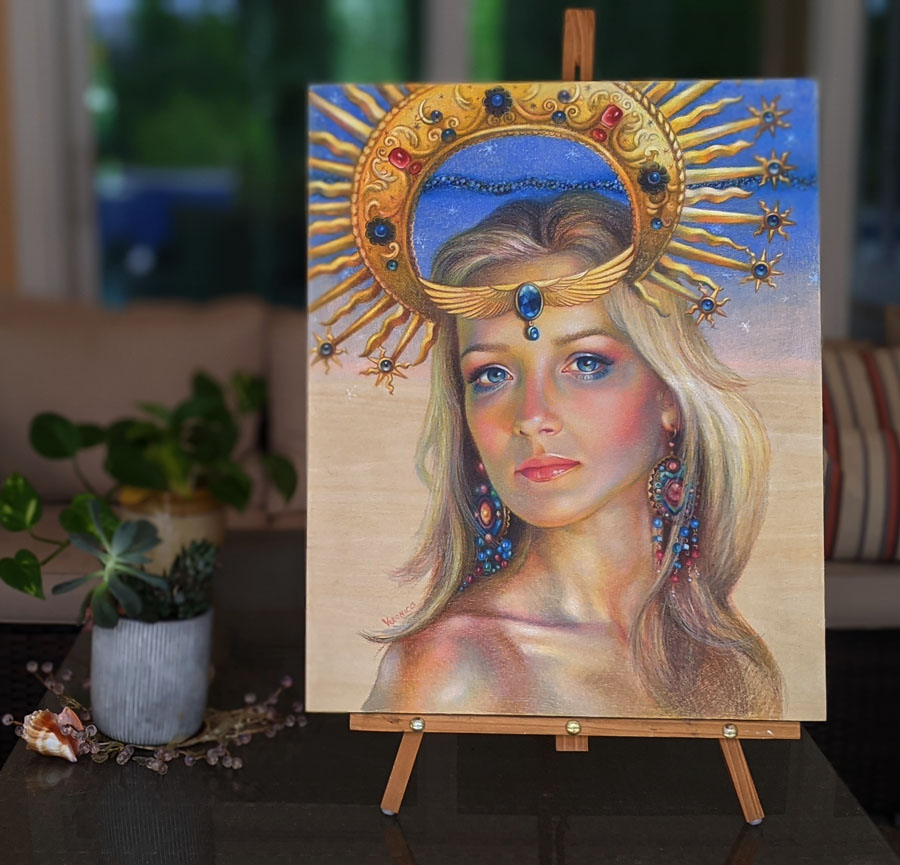
Drawbacks in colored pencil drawing on wood
- It’s much harder to draw on wood panels in comparison to drawing on bristol vellum paper! It can be frustrating to fill in the surface.
- The surface tends to “eat” the colored pencils.
- Hard colored pencils may slide off of the surface.
I highly recommend buying a very small panel to test all the materials and techniques on it first.
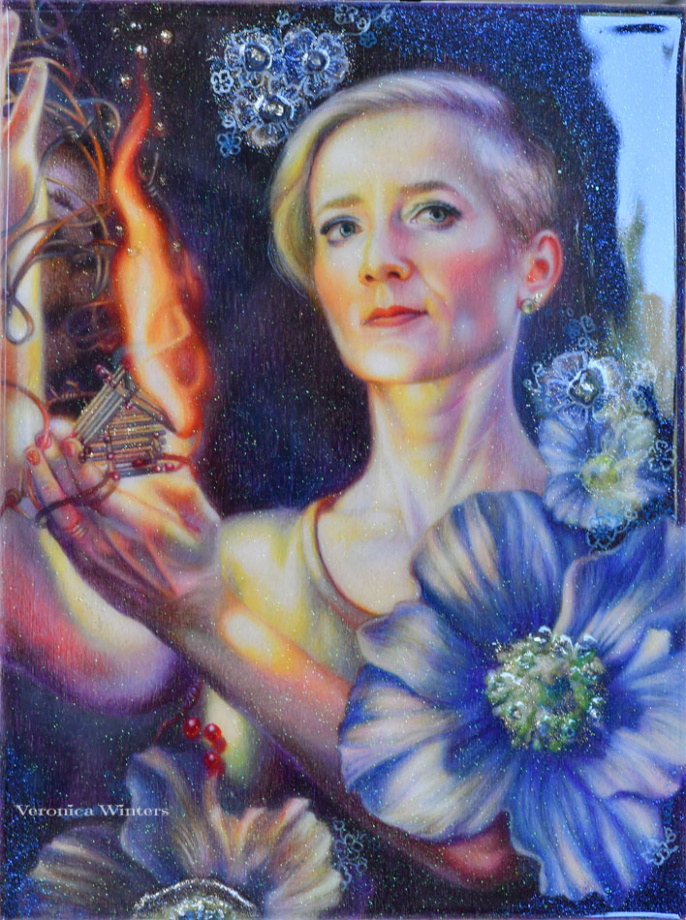
Art supplies list for colored pencil drawing on wood
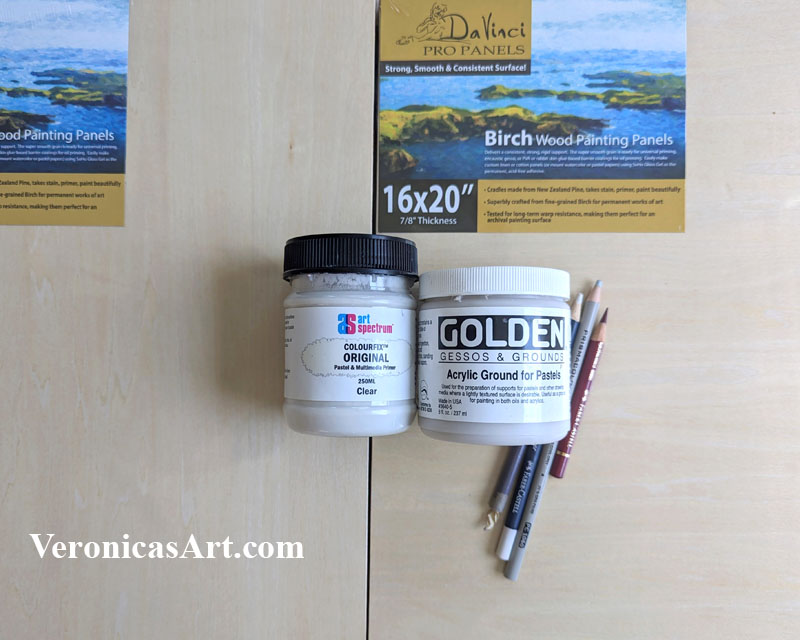
Wood Panels
Obviously, we can find many brands of wood panels suitable for colored pencil drawing. I happen to use Da Vinci Pro panels because they are sturdy and have a 1-inch depth that makes them look like paintings. I usually buy my art supplies at JerrysArtarama although some of them are available on Amazon.
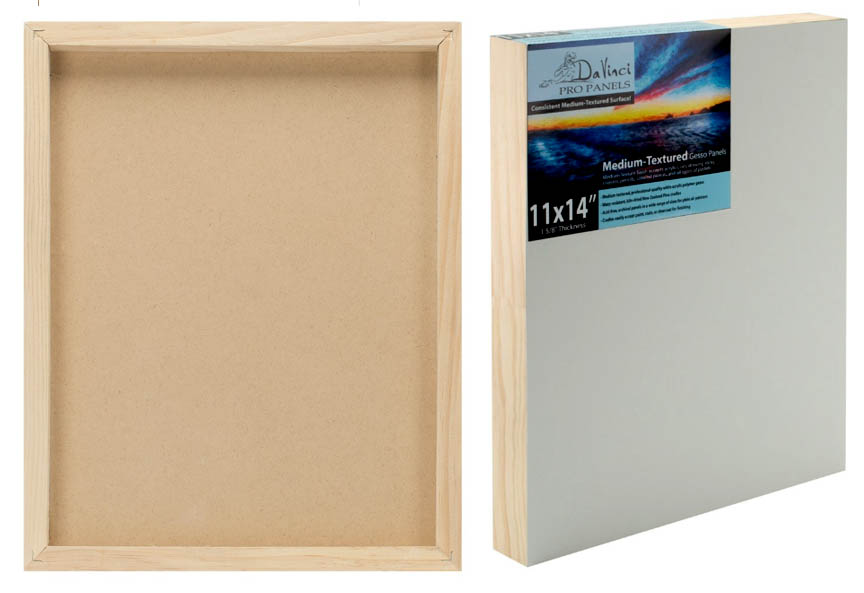
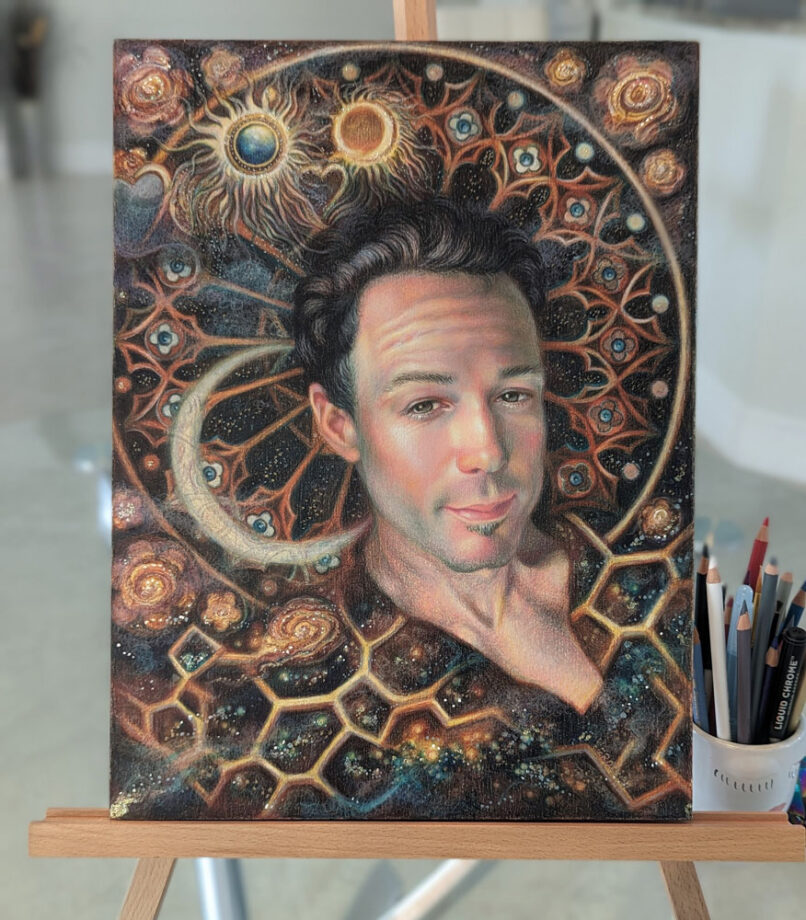
Art Primers for colored pencil drawing on wood
I did some colored pencil drawing on wood with and without a primer. I prefer using the primer to have that extra tooth in the surface to grab the colored pencils. Primers seal the surface to prepare it for drawing in colored pencil.
There are several primers that you can test to use to cover wood panels, panels and paper. All of them are quite similar but give a slightly different grip or tooth to the surface to apply the colored pencil to.
- I like Colourfix Primer because it comes in several colors!! You can tint the surface with this primer and draw like you draw on toned paper. https://amzn.to/3WKbwjm Colourfix Primer Clear 250Ml, Brand: Art Spectrum.
- Golden Acrylic Primer for Pastels has more texture than the Colourfix but is also used for surface prep. You can find it here: https://amzn.to/43DNbzC.
- Finally, there’s another ground with superfine texture for drawing –Golden Silverpoint/Drawing Ground. You can buy it here: https://amzn.to/3MSqbq1

You need to test them first to see which one will work for your colored pencil drawing. You might not like all of them.
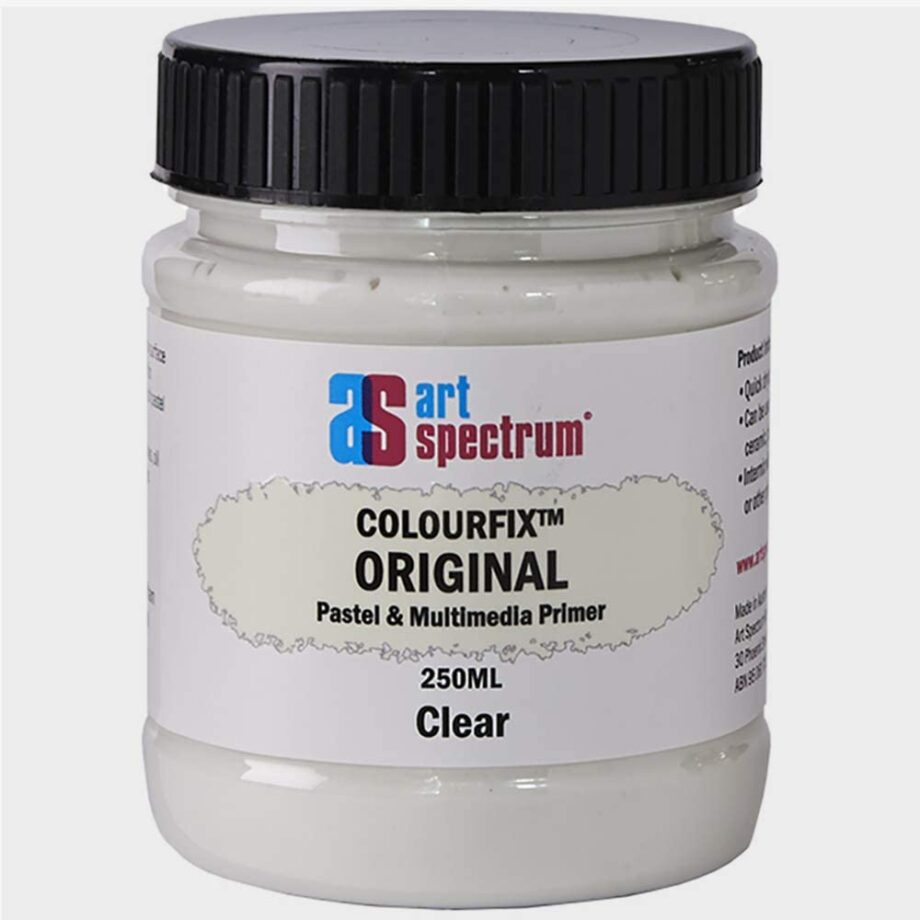
Art Fixatives for colored pencil drawing
There’re numerous brands of fixatives for drawing. I recommend listening to the video with a technical cosnultant Ed Brickler to understand the differences and to figure out which ones will work for you. I’m including some of the best ones below.
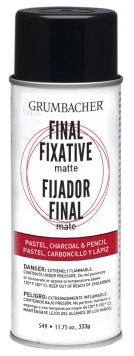
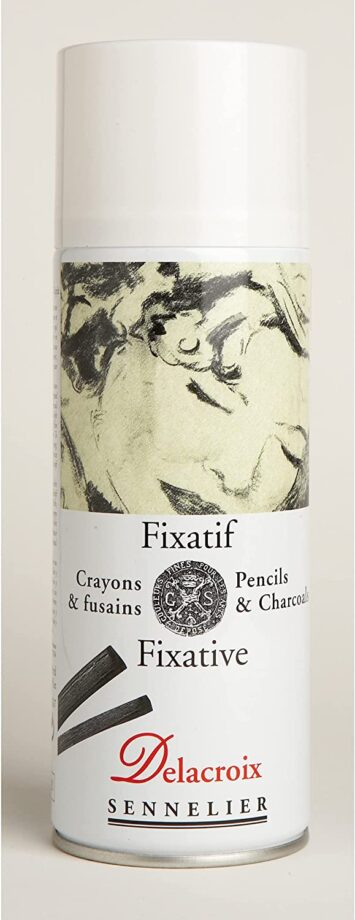
Sennelier Delacroix Fixative https://amzn.to/3MT4WUO is also an excellent spray for pencils that has a super fine mist. Both sprays are hazardous and must be sprayed in a very well ventilated space or outdoors with low humidity levels.
One of safe fixatives is Spectrafix.
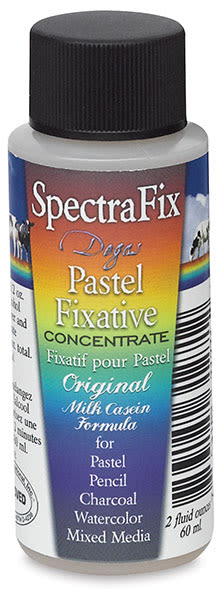
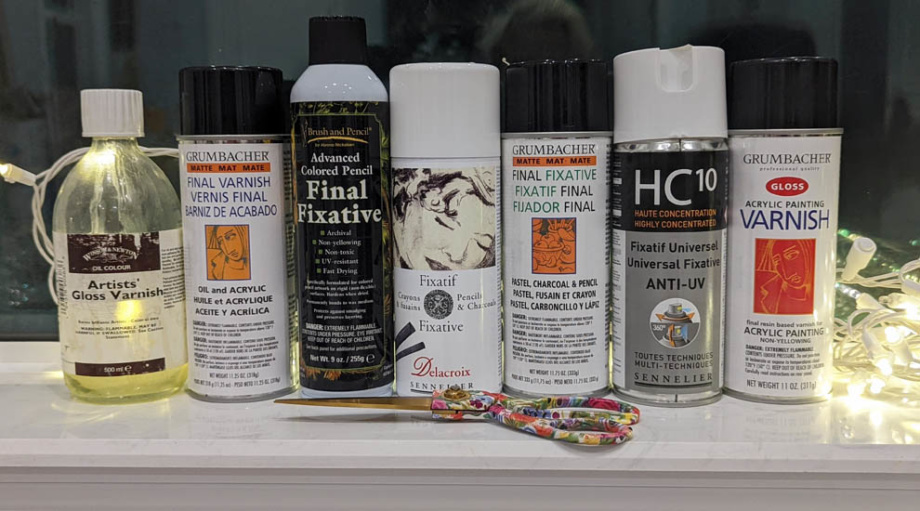
How to frame colored pencil drawings on wood
This is a tough one! The panel has a 1-inch depth, which is good to prevent warping and it also aids professional presentation but it makes it quite difficult to find a proper frame for it. So you have to search for “canvas-depth frames” that would compliment your drawings. Regular frames won’t have enough depth to cover the panel’s sides.
You still must use a non-glare plexiglass to protect the drawing from UV-light and moisture.
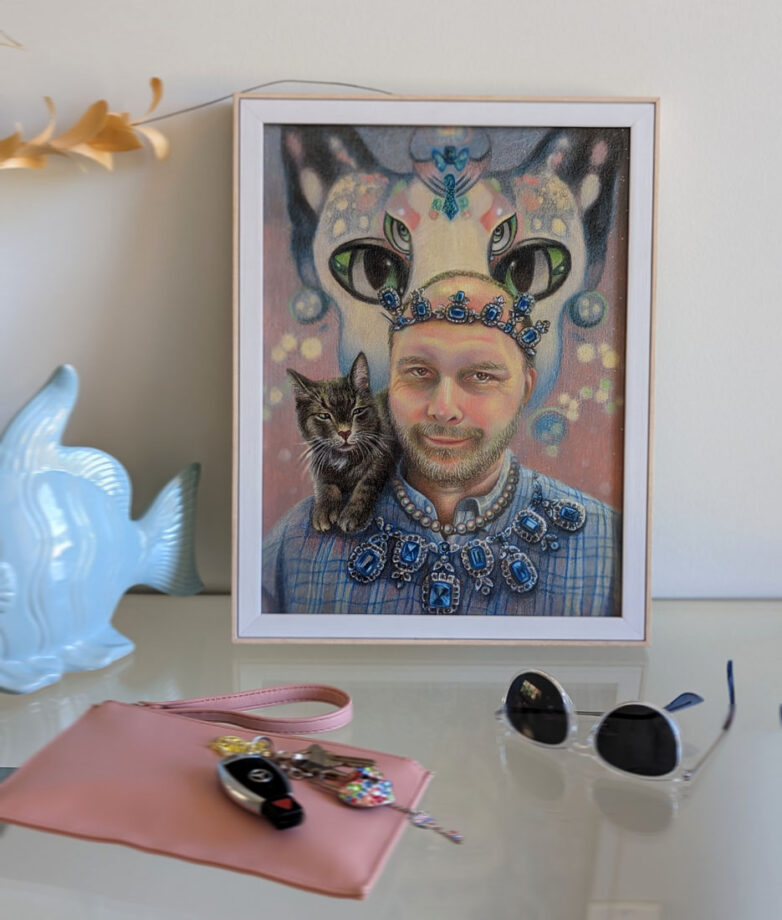
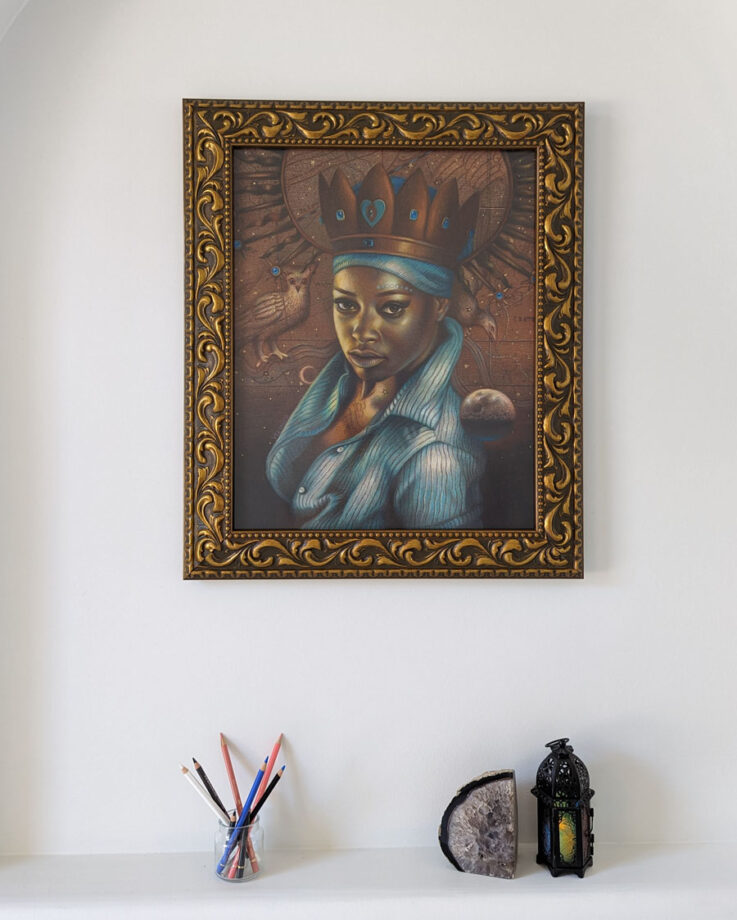
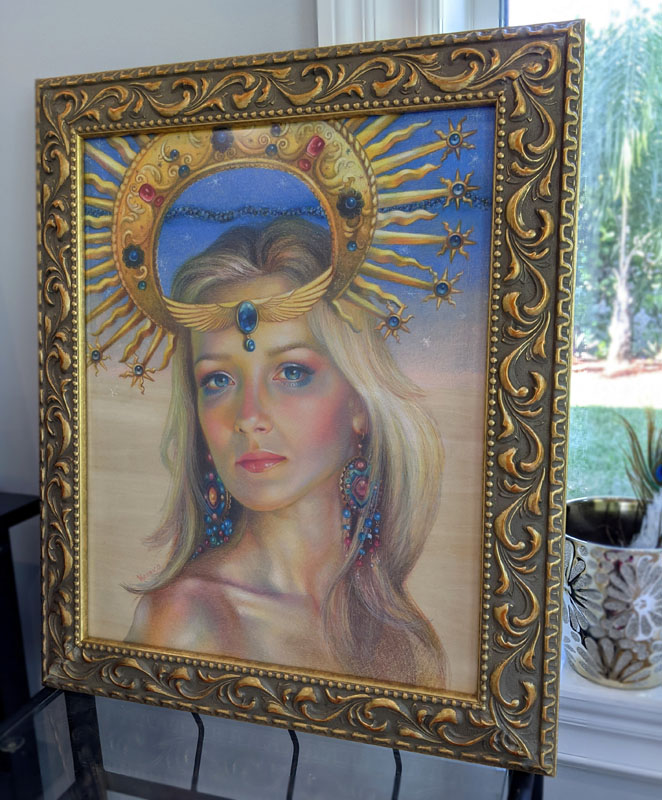
To read about framing of colored pencil drawings, go here: https://veronicasart.com/how-to-frame-art-on-paper-and-on-canvas/
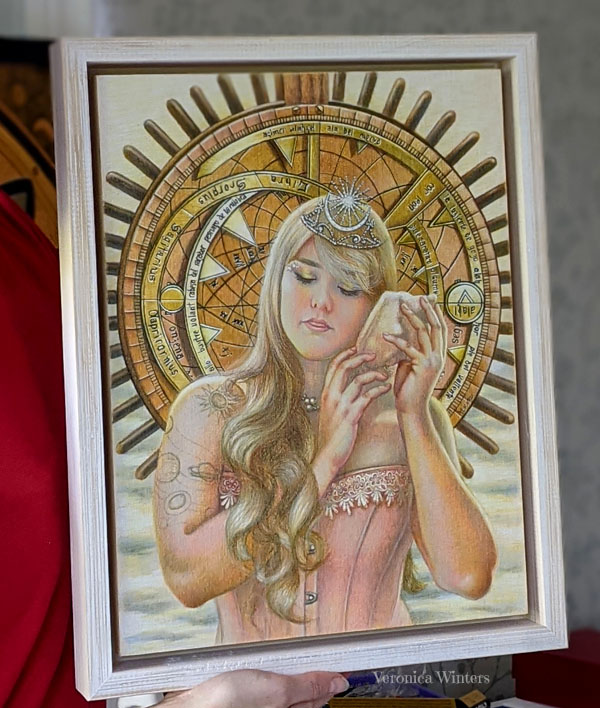
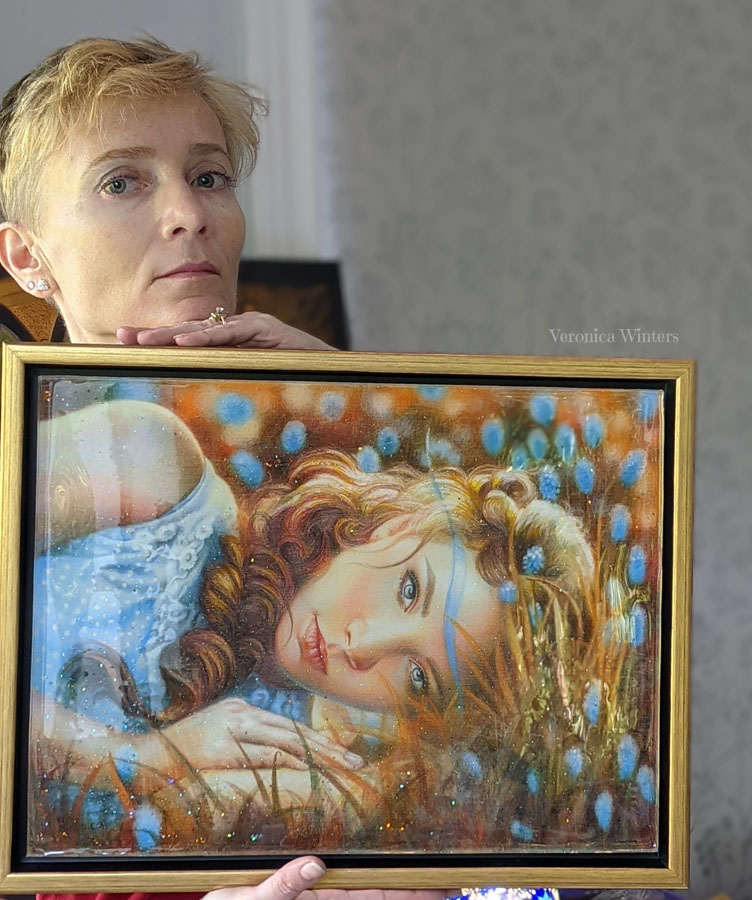
If you’d like to learn more about colored pencil drawing, take one of my video classes here: https://veronica-winters-art-school.teachable.com/
Art supplies:
- Drawing pad, bristol vellum
- Kneaded eraser
- koh -i-noor drawing paper, colored pencil
- Tombow mono eraser
- Drawing fixative
- Sennelier fixative for charcoal and pencil has a super fine spray mist, matte, high-quality
- Gamvar varnish for oil paintings, satin
- Brush for varnishing oil paintings
- Color Wheel
- Canson Colorline drawing paper is available in many colors and various thickness. You might find better choices at art supply online retailers
- Molotow metallic marker, gold
- How to color like an artist, coloring book for children and adults
- The colored pencil manual, art instruction book
Contact:
How to draw fur in colored pencil: the secret tool you need to succeed
When it comes to drawing realistic fur with colored pencils, there are a variety of techniques you can use to create texture, pattern, color, and shading that mimics the look of real animal fur. Whether you’re drawing long fur or fluffy fur, a cat tail, dog tail, or any other type of animal tail, there are a few key things to keep in mind. When it comes to creating realistic animal drawings, the texture of the fur can make or break the artwork. Colored pencils are a great medium to use when drawing fur, as they allow for precise and detailed strokes that can mimic the look of individual strands of hair. In this article, I’ll focus on drawing tips, ideas, techniques and a simple tool for drawing realistic fur with colored pencils on white paper. (I usually draw on colored paper and the colored pencil technique is different for that).
How to draw fur with colored pencil
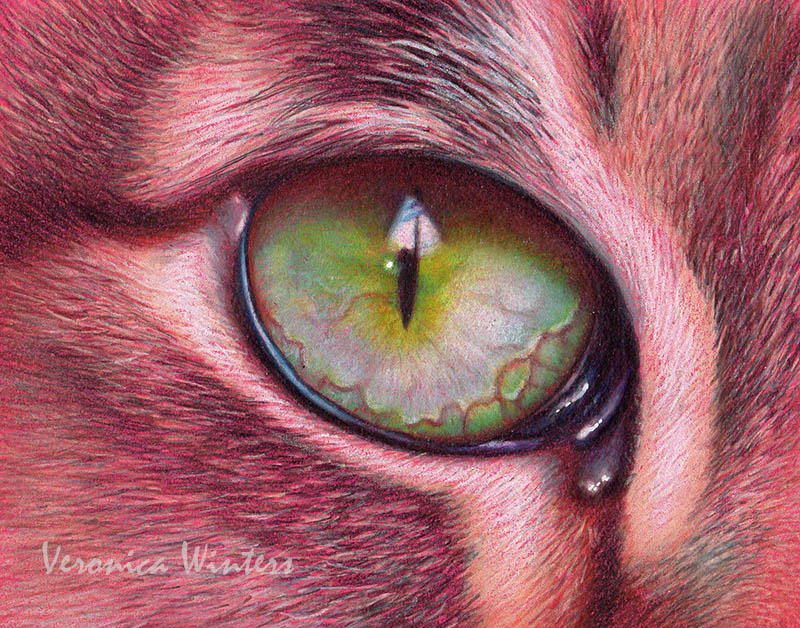
#1 Start with a good reference photo
Before you begin drawing, it’s important to have a good reference photo of the animal fur. Look for a photo that clearly shows the texture and pattern of the fur, as well as highlights and shadows. The more detailed the reference photo, the easier it will be to create a realistic colored pencil drawing. Take photo that has a clear division between light and shade (or highlights and shadows).
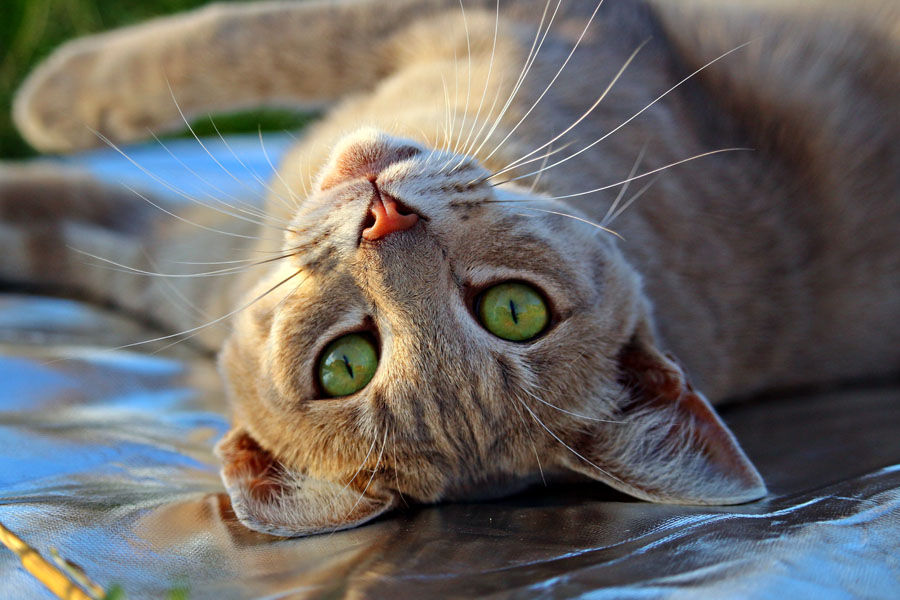
#2 Use directional strokes in colored pencil drawing of fur
One of the most important factors to consider is the texture of the fur or the direction of the hair growth. To create a natural-looking texture, it’s important to use a combination of short, directional strokes in varying lengths and pressure levels. Depending on the type of fur you’re drawing, you may need to use different stroke techniques to create the desired effect. For example, for long fur, you may need to use longer, more fluid strokes to create the appearance of length and movement, while for fluffy fur, shorter, more jagged strokes may be more effective.
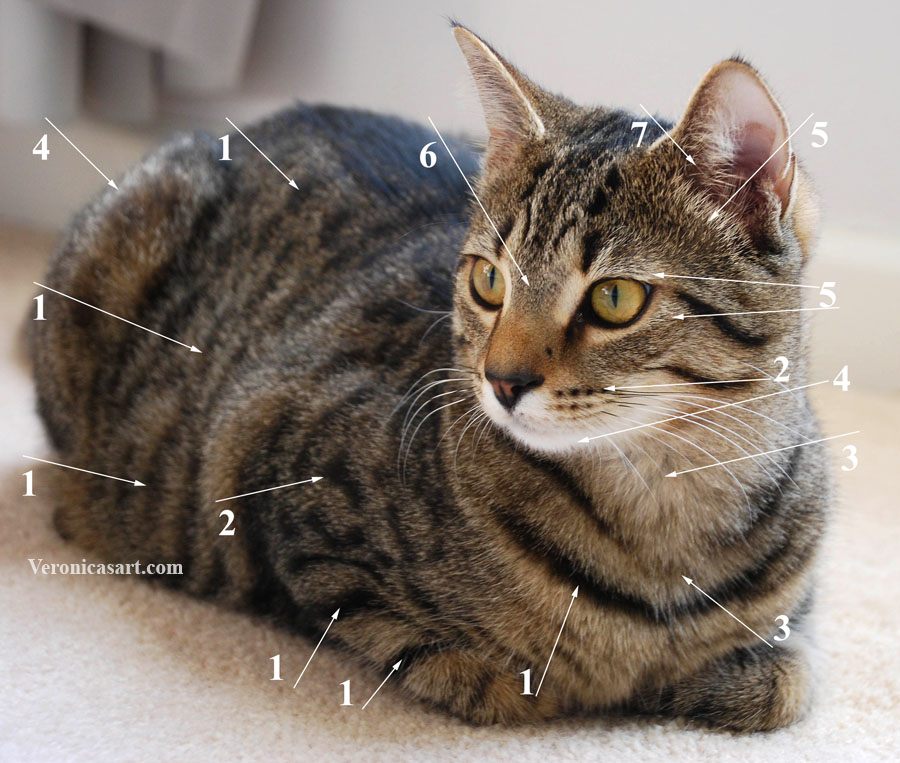
#1- These are rather wide stripes and fur’s patterns that WRAP AROUND the body. Most students draw them too flat. Observe how the animal’s fur wraps around the neck, stomach, etc.
#2 Copy the unique patterns of the fur as precise as possible.
#3 Some fur is rather long. Use multidirectional strokes to re-create it.
#4 This fur is very short but super soft with the blurry edge. Edges are important.
#5 These are rather long and sharp-edged hairs that wrap around the eye.
#6 Extremely short and multi-colored fur.
#7 Very long, directional strokes.
#3 Layering
Build up layers of color. Another important aspect in colored pencil drawing of fur is layering. Building up layers of color gradually can help you create depth and dimension. Gradual layering also helps you blend different colors together for realistic appearance. Use a light touch of colored pencil while layering colors, and build up the darker shades gradually.
Start with a light layer of the base color, and then gradually add darker shades to create depth and dimension. Use a light hand and short, light strokes to mimic the texture of fur. Use a variety of colors to create a realistic fur texture.
#4 Light direction: highlights and shadows
To create depth and dimension in your colored pencil drawing of fur, pay attention to the light direction. You must have both strong highlights and shadows to create some depth and dimension. Use darker shades in areas where the fur is more dense, and lighter shades in areas where the fur is more sparse or where highlights are present. Adding highlights can help create a three-dimensional effect and make the fur appear more lifelike.
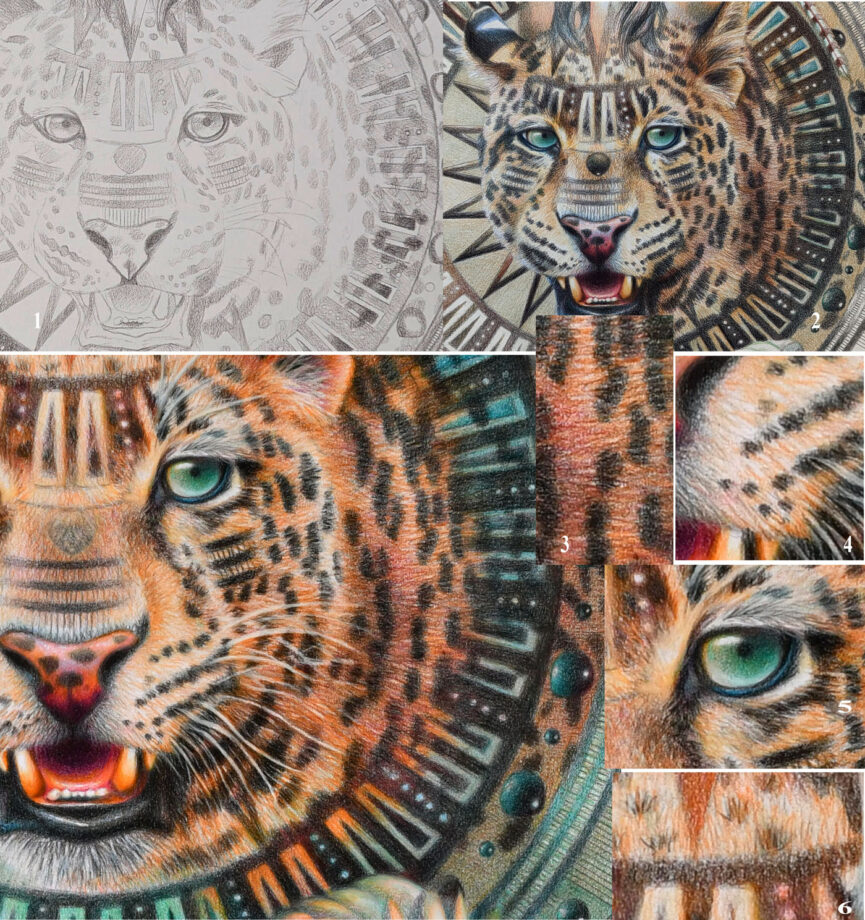
Shadows
Use darker colored pencils to create shadows in the areas where the fur is more dense. Pay attention to the direction of the light source in your reference photo to ensure that the highlights and shadows are accurate. For that I make a separate image by converting the original photo to a black-and-white one. This way I can clearly see the light direction that I must copy.
Highlights
There’re several ways to draw the highlights in colored pencil. It depends on the drawing paper’s tone as well as your own preference. In this tutorial I focus on drawing the lights of the animal’s fur on white paper. In general, using a white colored pencil to add highlights to the fur can be ineffective. It works well when you do the following trick, however.
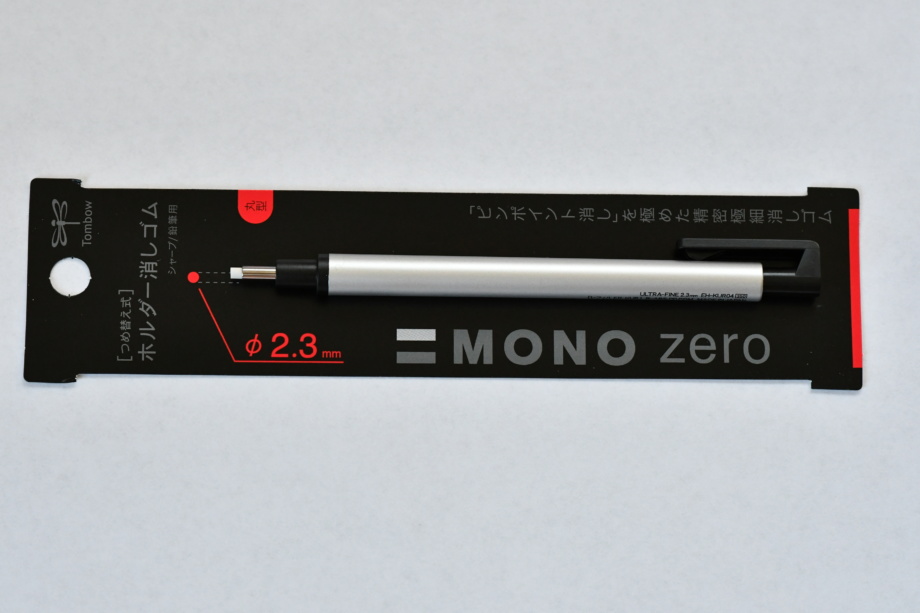
After layering the base of color, take the Tombow mono eraser and erase parts of the fur paying attention to its length, strength and direction. This becomes the foundation for texture. Then you start drawing around those “puled out whites”. Then take your drawing outside and spray it lightly with a final fixative. I recommend Sennelier or Grumbacher brands. Wait for it to dry completely!
To continue building up the texture drawing the animal fur, you can add refined lines in a very soft, white colored pencil. You can continue shading with darker colored pencils around the lights. And you can use the mono eraser once again to texturize the fur even more, shading in a slightly different direction. These are steps 3-6 in the drawing of the jaguar.
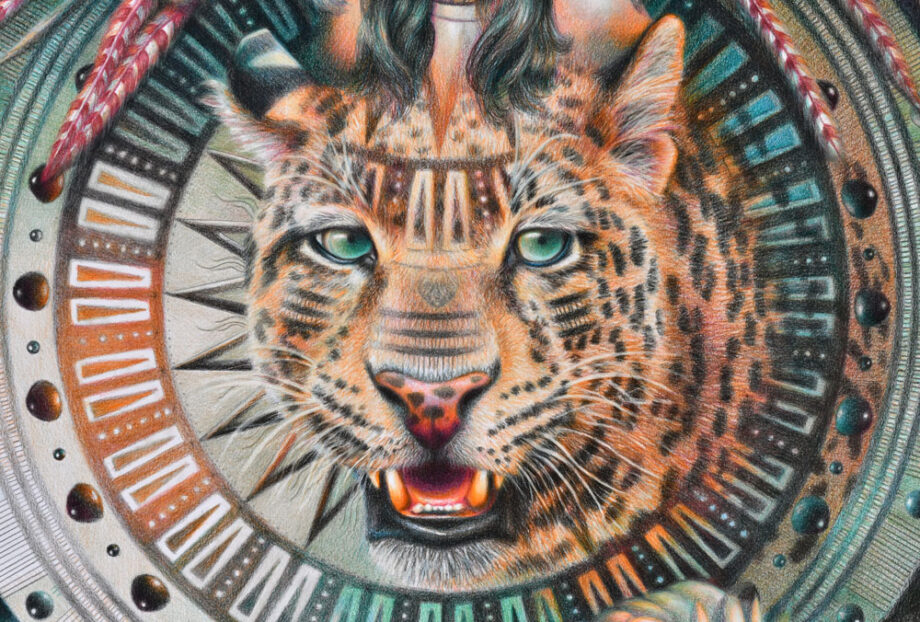
#5 Adding refined texture in colored pencil drawing
To blend or not to blend, right? I think that the colored pencil blending is the opposite of drawing fur and texture in colored pencil. You want to imitate the texture in the cat’s fur or other animal fur. Therefore, you can blend the colors some at the first step when you’re layering the base but refrain from blending the animal’s fur at the end of the drawing process in colored pencil. Never use a blending stump or a piece of tissue paper in colored pencil blending. It’s ineffective and damages the surface. Use a sharp pencil to create fine lines instead. You need to do this towards the end of your colored pencil drawing process when you have the base shading done.
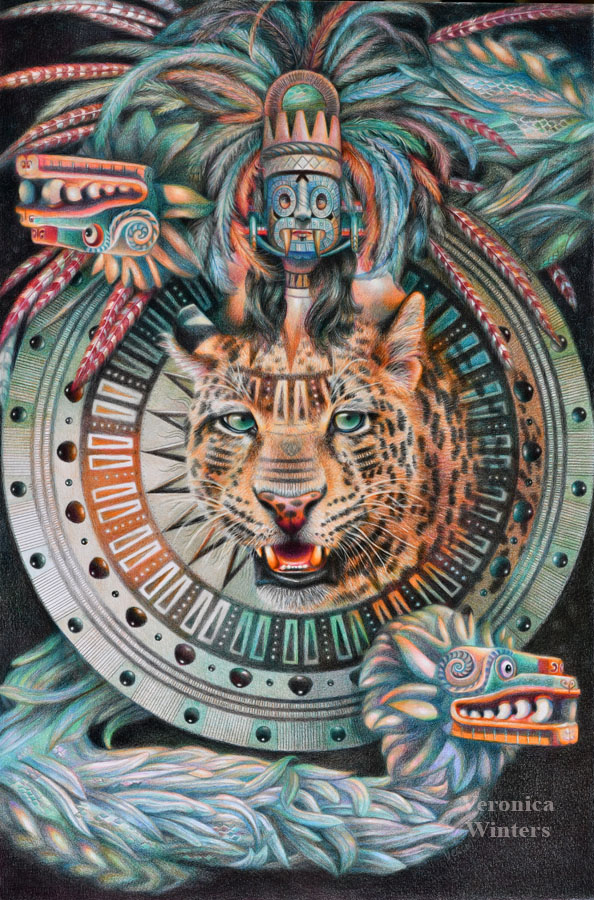
Remember, drawing realistic fur with colored pencils is a skill that takes patience and practice to develop. Don’t be discouraged if your first attempts don’t turn out exactly how you’d like. By starting with a good reference photo, building up layers of color, using directional strokes, adding highlights and shadows, and practicing regularly, you can create stunning animal drawings with lifelike fur texture. Also be open to experimenting with different techniques, and trying new things until you find the approach that works best for you. With some effort and positive attitude, you’ll be able to create stunning drawings of animal tails with lifelike fur texture, pattern, and color.
Check out the article where I show how to create fur texture and fur shading using scratchboard art. https://veronicasart.com/how-to-start-scratchboard-art-tools-techniques-tips-to-make-fur-texture/
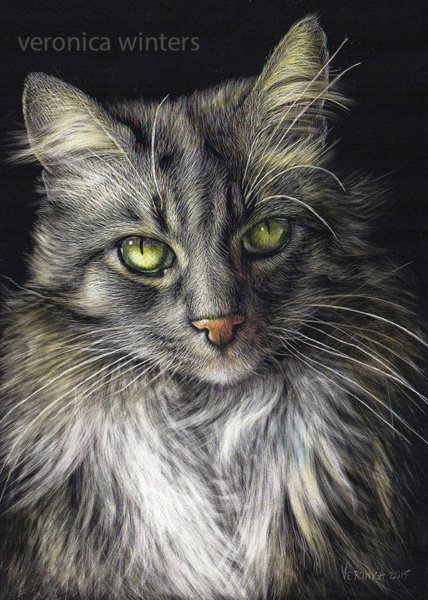
Art supplies on Amazon:
- Drawing pad, bristol vellum
- Kneaded eraser
- koh -i-noor drawing paper, colored pencil
- Tombow mono eraser
- Drawing fixative
- Sennelier fixative for charcoal and pencil has a super fine spray mist, matte, high-quality
- Gamvar varnish for oil paintings, satin
- Brush for varnishing oil paintings
- Color Wheel
- Canson Colorline drawing paper is available in many colors and various thickness. You might find better choices at art supply online retailers
- Molotow metallic marker, gold
- How to color like an artist, coloring book for children and adults
- The colored pencil manual, art instruction book
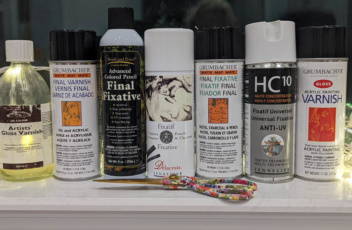
Fixatives & varnishes: what you need to know to preserve your art
Do you know how to varnish art using the varnishes and fixatives correctly? There are numerous videos on Instagram with artists varnishing their art dead wrong. They pour the liquid onto the surface and brush it all over the canvas. I saw one artist at an outdoor art event varnishing her painting in a frame with bugs flying all around her! If you really care about your art and want to preserve it, using your art materials properly is a must. Otherwise paintings may crack or discolor over time.
What’s the difference between varnishes and fixatives?
Key difference between varnishes and fixatives is that varnishes are made for oil and acrylic paintings and fixatives are manufactured for dry media or drawings.
So don’t use a varnish on your drawing! Use final fixative for pastels, pencil, charcoal, colored pencil, and other media on paper, etc. Read labels carefully to decide which fixative or varnish is appropriate for your artwork. A lot of them produce harmful vapors containing acetone and turpentine. However there are some “healthier” alternatives available on the market today. More on that later.
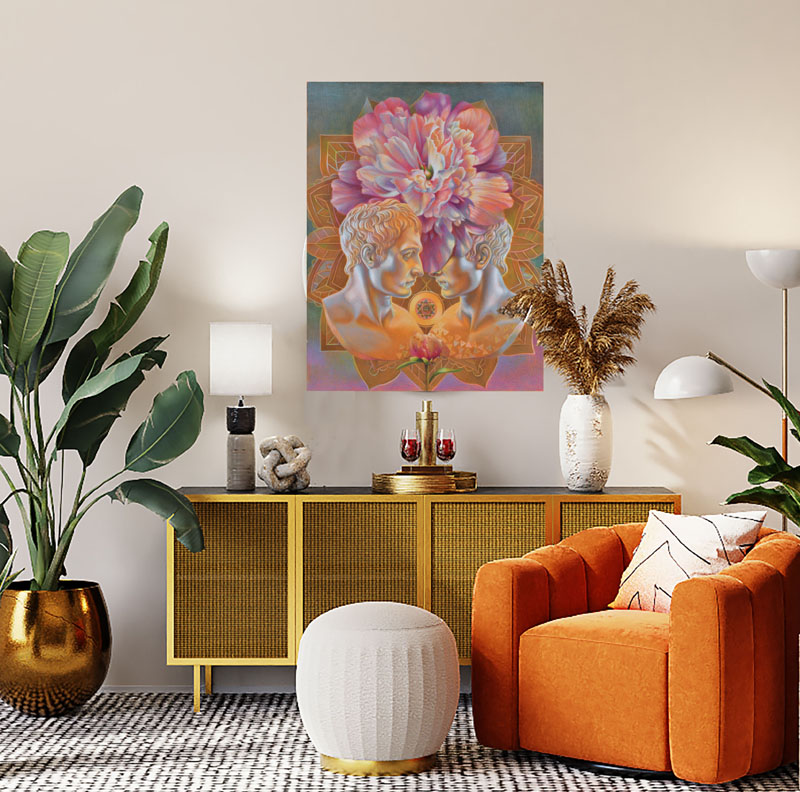
3 reasons to varnish your art
The environmental changes can produce environmental smudge on a surface of the unvarnished oil or acrylic painting that would be very difficult or even impossible to remove later on. One example is the growth of mold on the painting’s surface. Varnishes and fixatives protect your art from UV light, dust and environmental changes. Varnishes are removable, so that a painting can be cleaned and re-varnished, if necessary.
High-quality varnishes and fixatives bring all the colors out in a painting or drawing. The surface becomes nice and even. Colors seem to gain depth and saturation. Personally I love to see how my drawings and paintings transform after varnishing.
How to varnish your colored pencil drawings, pencil and charcoal drawings, pastels and other dry media art
All fixatives come in several denominations - matte, gloss, semi-gloss, etc. Personally, I prefer matte fixatives because the surface becomes nice and even and doesn't reflect the colors. If you like gloss varnishes, know that it takes a lot more fixative to saturate the paper and make it glossy evenly.
- Read directions on the label carefully. Test the spray on a separate piece of paper or magazine page first.
- Spray 15-18 inches away from your drawing, holding the can at an angle. Move quickly from left to right.
- Do short spurs and thin layers. Let each layer dry completely for at least half an hour.
- Spray in a clean and well-ventilated area or outside. Humidity level must be less than 65% in a 55-60F temperature. Otherwise, you may trap the moisture or condensation on the artwork and it would turn cloudy. Depending on the type of fixative, fumes can be hazardous. Once fumes evaporate, bring the artwork inside. I use my bathroom’s countertop to lay art flat and use the bathroom’s ventilator to get rid of the smell completely. Ed S Brickler, technical consultant from Chartpak has a dedicated space in his garage to do the varnishing.
- Workable fixative is often used to increase the texture of your paper. Colored pencils are made of wax and when the surface becomes too waxy and you can’t layer more color, you can spray it with a workable fixative to increase paper’s tooth so it accepts more layers of colored pencil. I often use a very light layer of final fixative to give me this extra layer to work on. I don’t find the workable fixative as useful as the final one.
- I strongly advice against buying cheap fixatives because they give uneven coverage and can ruin your drawings.
- If your colored pencil drawing has some bloom, fix it with a gloss spray first and then use a matte fixative over it. The gloss fixative should even out the surface and get rid of wax bloom.
How to varnish pastels & charcoal drawings
I used to draw in soft pastels before I switched to drawing in colored pencil. Main secret to drawing in pastels is to work from dark to light in layers. Purposefully draw darker in the first layer or two, fix it with a fixative. Then apply lighter layers, fixing each layer. Don’t spray the finished pastel painting heavily because the fixative will darken and change the color. Or use a very light final coat spraying it very lightly.
Drawing with charcoal is about the same. Draw in layers and fix each layer with a fixative.
Don’t spray art if you have sharpie in it. Sharpie will bleed and dissolve.
How to store drawings and art on paper
The best way to store your colored pencil drawings, pencil or charcoal drawings is to lay them flat with glassine paper covering the art. Parchment paper could work as well although the glassine paper is highly recommended and preferred by art professionals. It’s also used for shipping art to create the barrier between unframed art and packaging.
Safe alternatives to traditional fixatives
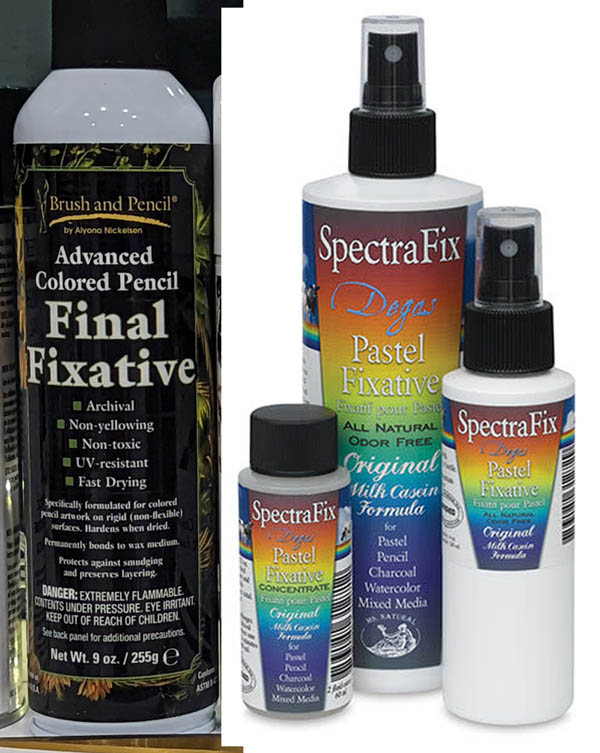
These are the two brands of final fixatives that are made differently and are non-toxic. If you know more about non-toxic fixatives, let me know! I don’t recommend using the Brush and Pencil fixative because the nozzle produces uneven spurs of fixative. It also crumbles thin paper.
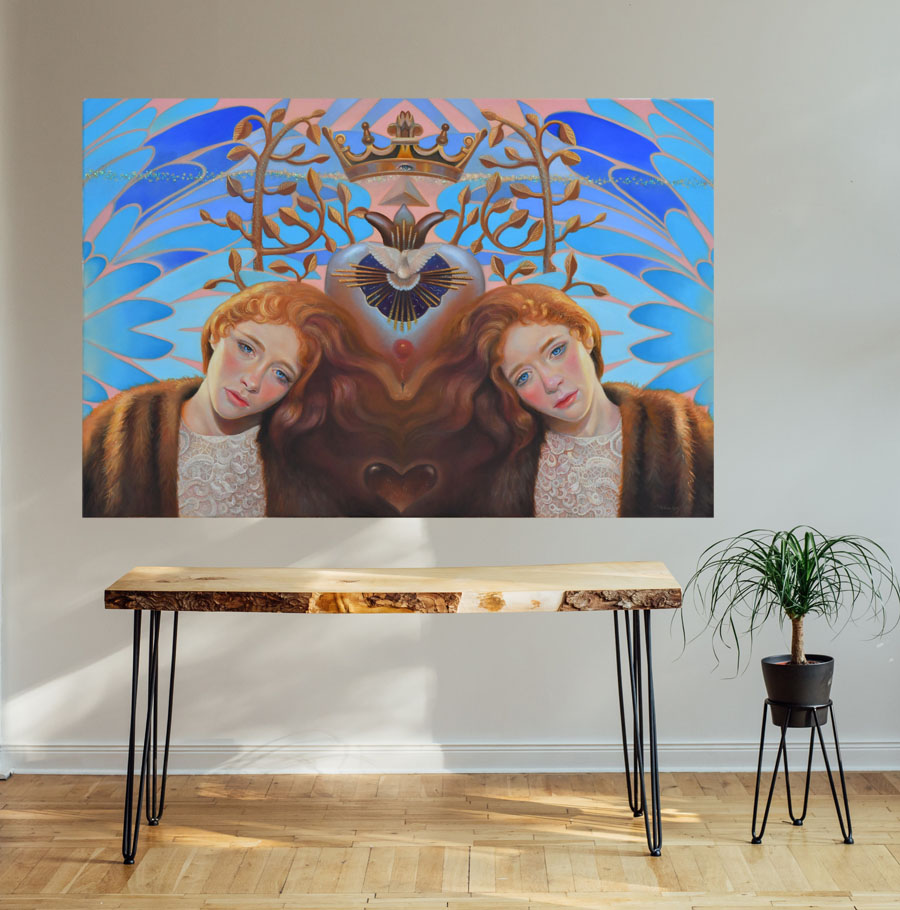
How to varnish oil paintings
Oil paintings must be varnished when the paint is dry completely. 6 months must pass before placing a final varnish over the oil painting. But because of possible environmental damage finished oil paintings can be varnished with a retouch varnish first and then varnished with the final varnish in 6+ months.
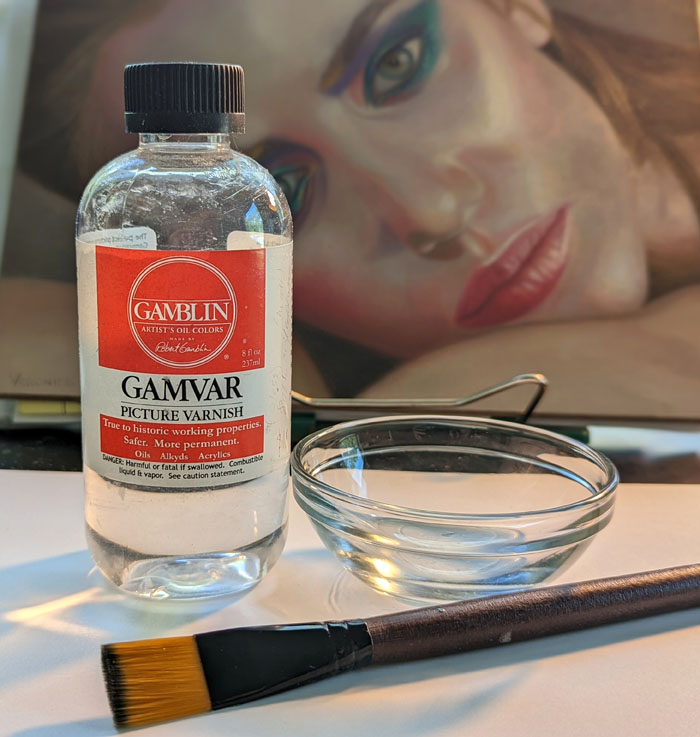
There are two types of varnishes for oil and acrylic paintings – spray varnishes and liquid varnishes. All varnishes come in several denominations – matte, gloss, semi-gloss, etc. Personally, I prefer matte varnishes because the surface becomes nice and even and doesn’t reflect the colors. If you like gloss varnishes, know that it takes a lot more varnish to even out the gloss.
Damar varnishes seem to be dated because they yellow or darken over time. So synthetic varnishes are preferred to preserve paintings from deterioration.
It's difficult to remove the varnish safely if the paint layers are super thin or the painting was varnished too early.

- Your space must be very clean. Liquid varnishes attract dust and particles like a magnet that can settle on a varnished surface. The brush should be high-quality and soft not to leave streaks.
- Pour the varnish into a small and clean glass bowl and deep the brush into it. Start brushing your painting from top left corner moving to the right and then down the painting. You need to be rather quick because the varnish starts drying almost immediately. If you feel that the surface becomes too sticky in one spot, don’t brush over it, rather let it dry. Repeat the process in your second, thin layer moving at a different angle or direction to make sure that everything is covered.
- Varnishes are self-leveling and applying them in thin layers is the best.
- If you use spray final varnishes, apply thin layers, letting each layer dry completely for up to an hour. Also, change the direction with each new layer to cover the entire painting surface evenly.
How to varnish acrylic paintings
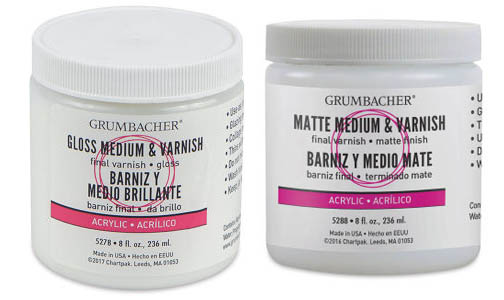
Same rules apply to varnishing acrylic paintings. However, the first thing is to use “medium & varnish” acrylic varnish. Varnish your acrylic paintings in three days with either matte or gloss final varnish over it.
If you gesso your canvases and panels with acrylic gesso or use acrylic underpainting for oil painting, allow acrylic-based gesso or paint to dry for 3 days before starting painting on the surface!
References & resources:
If you’re unsure how to use your particular varnish or fixative, go to the manufacturer’s website. Companies have their own blogs and videos showing how to use their products correctly.
This information is based on my conversation with technical consultant from Chartpak inc- Ed Brickler. You can watch our conversation in a video below. This interview is also available on my Hooked on Art podcast on Spotify & Apple.
Here is a great resource on oil painting varnishing from Gamblin: https://gamblincolors.com/oil-painting/gamvar-picture-varnish/
Amazon links to art supplies I use the most often:
- Drawing pad, bristol vellum
- Kneaded eraser
- koh -i-noor drawing paper, colored pencil
- Tombow mono eraser
- Drawing fixative
- Sennelier fixative for charcoal and pencil has a super fine spray mist, matte, high-quality
- Gamvar varnish for oil paintings, satin
- Brush for varnishing oil paintings
- Color Wheel
- Canson Colorline drawing paper is available in many colors and various thickness. You might find better choices at art supply online retailers
- Molotow metallic marker, gold
- How to color like an artist, coloring book for children and adults
- The colored pencil manual, art instruction book
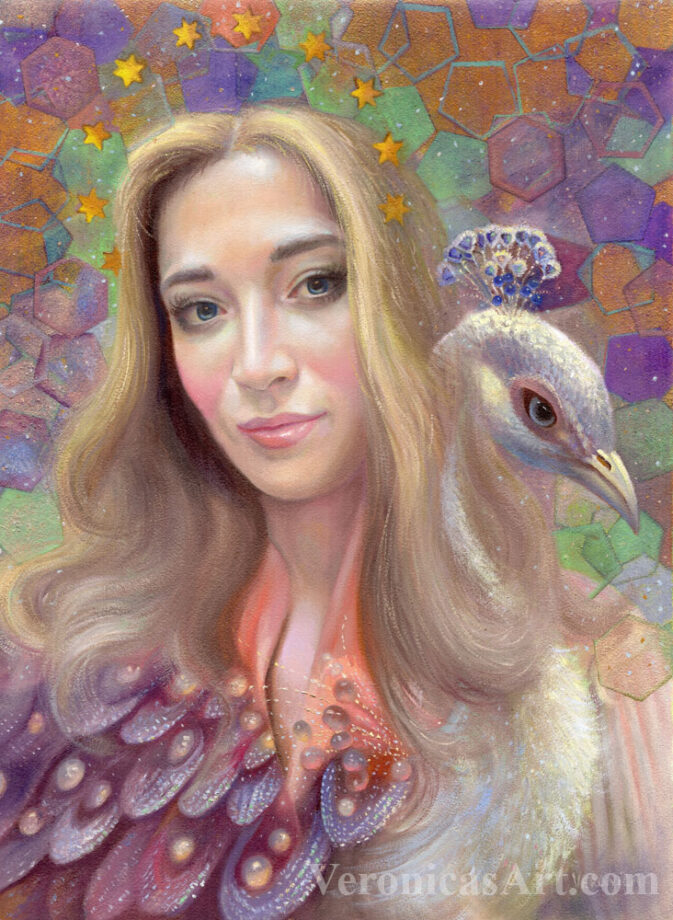
Check out visionary art for sale
5 ways to check the accuracy of your drawing to create realistic paintings
If your goal is to create realist drawings and paintings, you must master the accuracy of your outline drawing. Never neglect it and strive to perfect the drawing every single day. If you paint, you rely on your drawing skills even more to create realist art. Whenever something looks off, it means that your drawing is off. There are several easy tools realist artists use to catch their mistakes. I’m going to list the ones I use the most often.
5 tips to catch your drawing mistakes:
#1 Turn your canvas, paper or any other surface you’re using upside down.
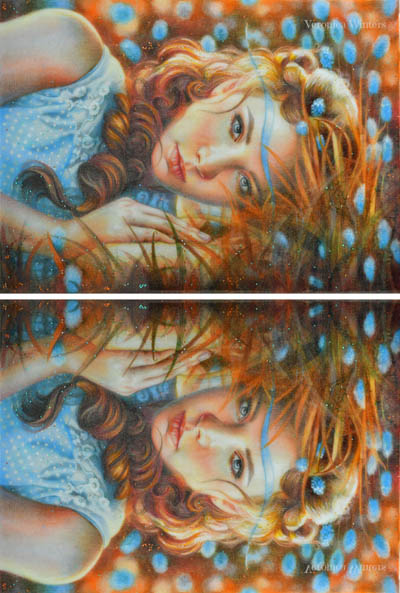
Turn it often. By turning your canvas upside down, your brain sees the mistakes instantly. I often paint upside down too because it lets me focus on shapes and see my subject differently. I keep rotating my drawing/ canvas often checking for anatomy mistakes.
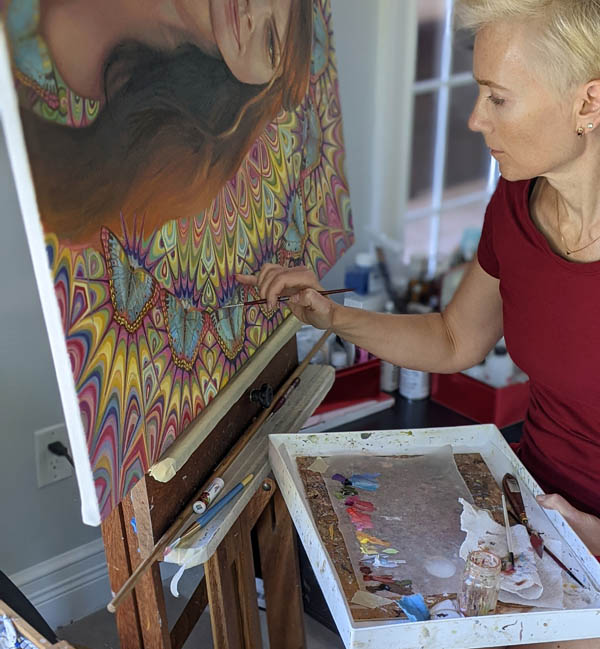
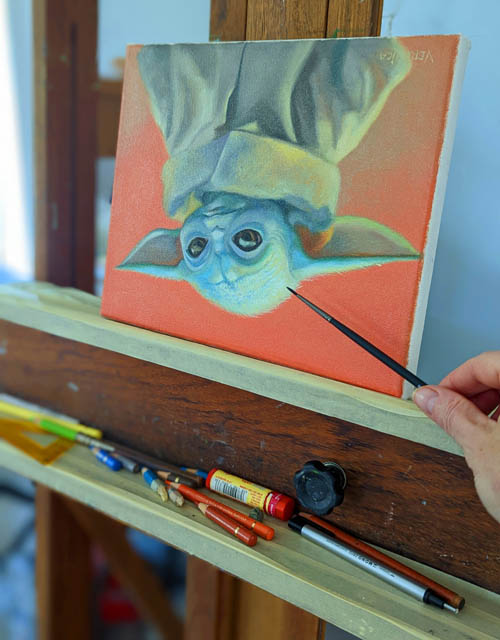
#2 If you paint digitally, flip your canvas horizontally often.
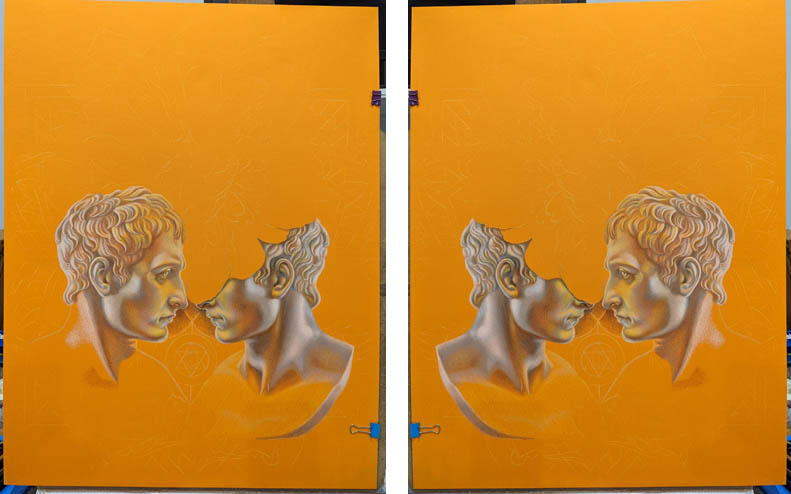
By flipping the canvas, you see all your awkward shapes. Use “Flip Layer Horizontal” function. Go back and forth working on your drawing in both modes.
#3 Check the accuracy of your drawing in a mirror.
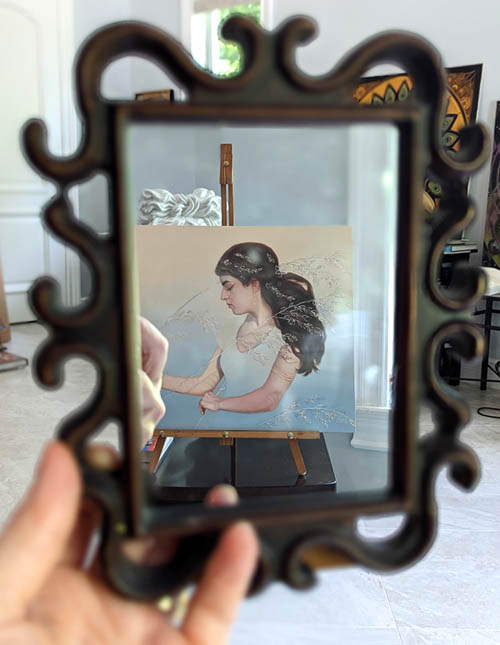
Look at your drawing in a mirror! This is the most useful tool I use to catch my mistakes. You’ll notice the crookedness of the eyebrows or unevenness of other shapes in your drawing.
#4 Step back to look at your drawing from the distance.
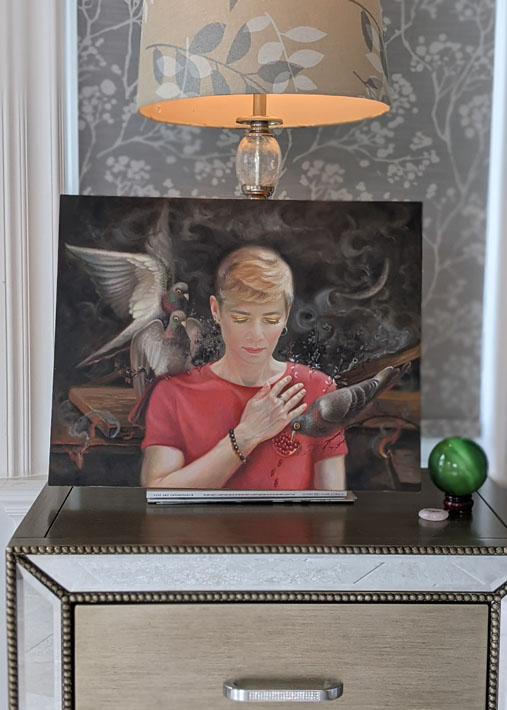
You can evaluate the relationships between big elements in your composition standing far away from your canvas, which you don’t see being up close to your painting.
#5 Take a picture of your art in progress.
Hold your camera straight and quite far from your drawing to prevent big distortion (yes, almost all cameras distort images, especially the phone cameras). Now look at your picture. At first glance you’ll see a few strange shapes in the photo. They may become less obvious after a while because our brain makes adjustments… I often use my camera at the last stage of my painting process thinking that I’m done and ready to take my final shot but then I notice a few more mistakes I didn’t catch during the painting process.
This is it! Use a combination of all of these tools to perfect your anatomy drawing or any other kind of drawing.
Check out my video art courses here: https://veronica-winters-art-school.teachable.com/
- Drawing pad, bristol vellum
- Kneaded eraser
- koh -i-noor drawing paper, colored pencil
- Tombow mono eraser
- Drawing fixative
- Sennelier fixative for charcoal and pencil has a super fine spray mist, matte, high-quality
- Gamvar varnish for oil paintings, satin
- Brush for varnishing oil paintings
- Color Wheel
- Canson Colorline drawing paper is available in many colors and various thickness. You might find better choices at art supply online retailers
- Molotow metallic marker, gold
- How to color like an artist, coloring book for children and adults
- The colored pencil manual, art instruction book
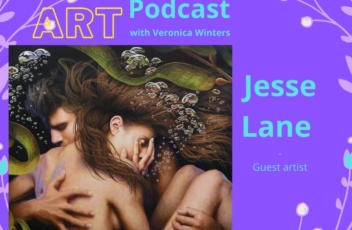
Jesse Lane, realist colored pencil artist
My guest is super talented, realist colored pencil artist Jesse Lane. His large, realist colored pencil drawings demonstrate thorough understanding of colored pencil techniques, creativity and vision. He is the recipient of many prestigious awards including The Best of Show in 2020 by the Colored Pencil Society in America.
Jesse shares his thoughts on motivation, artistic challenges, emotions, creativity and much more! Personally, Jesse strikes me as a genuine human with positive, outgoing personality that helps him fulfill his destiny and share his art with the world.
Recorded in a video format first: https://youtu.be/1i0nFiS59bQ
Website: https://www.jesselaneart.com/
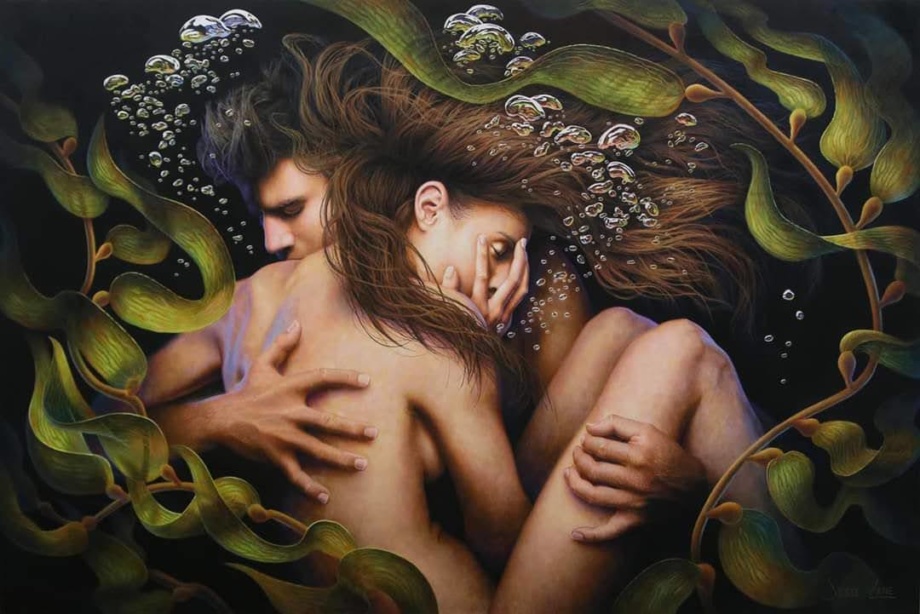
Veronica can be found at veronicasart.com
Podcast: Play in new window | Download
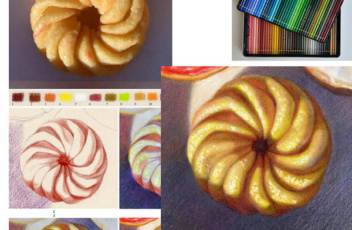
How to draw realistic textures in colored pencil
Step-by-step realistic colored pencil drawing of a donut
To learn realistic colored pencil drawing techniques, you must consider:
- drawing your subject and shapes correctly
- understanding the difference between color and value in colored pencil drawing
- making even shading
- making creative compositions
- understanding how the light turns the form
A full step by step demonstration of 10 donuts is part of my most recent art book The Colored Pencil Manual as well as my video course Complete Colored Pencil Techniques in 90 days.
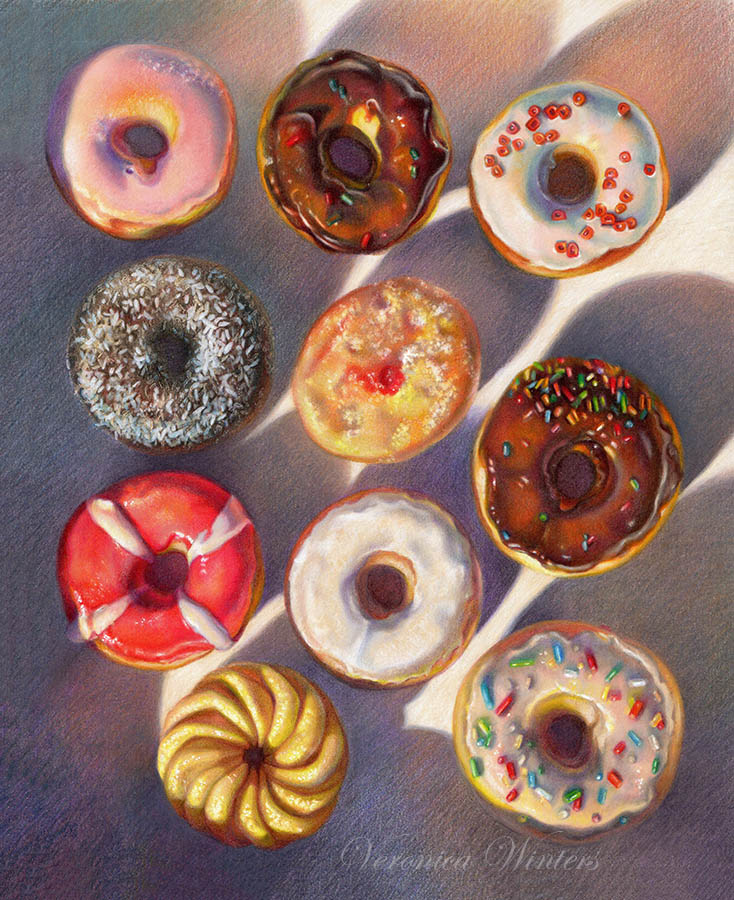
In this colored pencil drawing demonstration I don’t focus on basic drawing techniques but explain how to do shading, texture and color harmony. While I lay out the drawing sequence of every donut, the artwork is completed by filling in the background first and then layering one color at a time while working on all donuts simultaneously.
By shading the background first, I create instant contrast to work against drawing the donuts.
It took a considerable creative effort to make this arrangement of donuts for the photoshoot. I wanted to balance every texture, color, and shape in one composition.
Art supplies:
- Prismacolor Premier colored pencils unless noted;
- kneaded eraser
- tracing paper (optional)
- Grumbacher final fixative, for dry media, matte
- a large sheet of printmaking paper, light gray (it can be replaced with Stonehenge Multi pad color either pearl grey or fawn). This project was completed on a very light gray printmaking paper that often doesn’t read as such in photography. It has minimal texture and the colors tend to blend on their own without employing additional blending techniques.
- Color wheel – optional
- The Color Chart is separate for each donut. In this example some of the textures are created with varied stroke applications, and Sakura Pentouch marker.

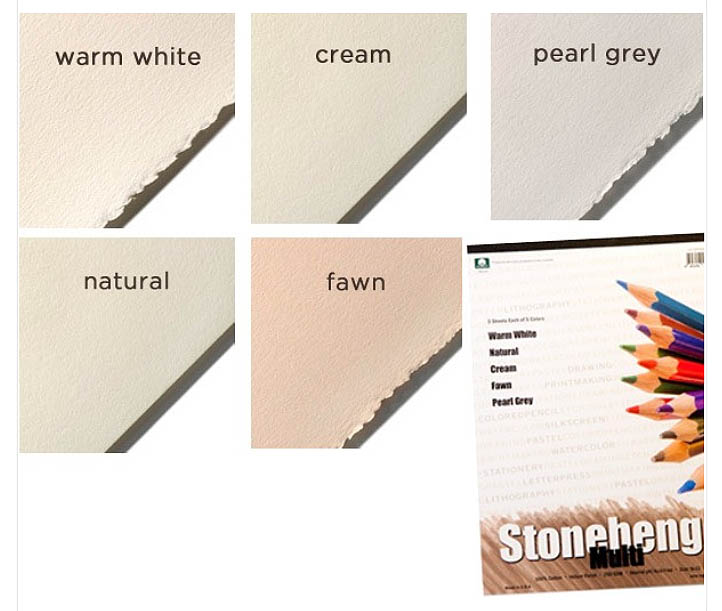
Basic colors:
Prismacolor Premier colored pencils unless noted;
1. Terra Cotta 2. Sienna Brown 3. Mineral Orange 4. (Pablo) Yellow 5. White 6. Henna 7. Artichoke 8. Chartreuse 9. Yellow Ochre 10. Yellow Orange 11. 70% Cool Grey 12. Pumpkin Orange 13. Yellow Chartreuse
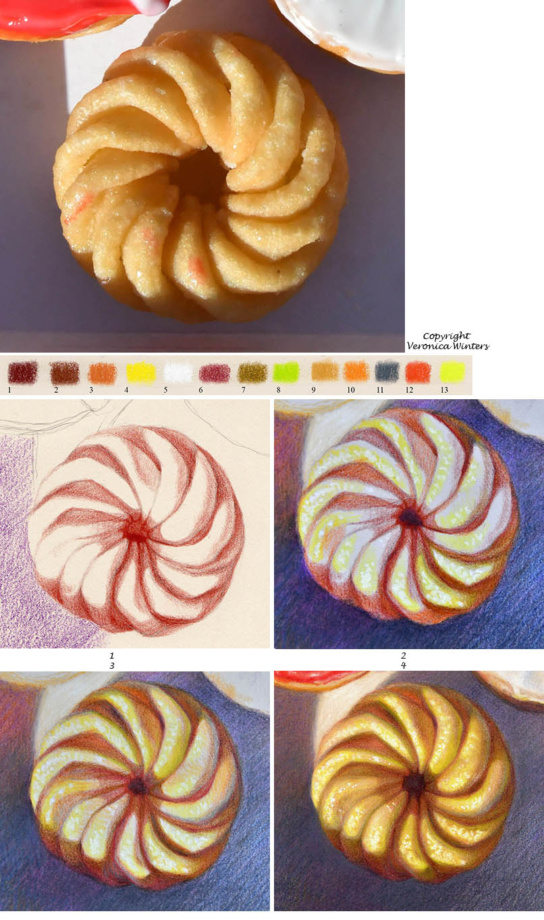
Step 1
Tap all graphite lines with the kneaded eraser. It’s a light donut and graphite will show up once you begin shading. Begin drawing out the rotation of each fold with either terra cotta or sienna brown. While the color looks reddish here, it’s actually a warm brown that the author suggests you use for shading.
Step 2
Once you place the background colors (see the last two steps for instruction), you set the contrast to begin working on the donut. With a sharp point, place random white spots and shade around them with Pablo yellow. Add mineral orange into the brown to warm up the color.
Step 3
With every new step, you keep defining the edges to preserve the correct rotation and clarity in each section. You also work in short, directional strokes on every section to create volume. For that you need to keep rotating your drawing paper as you shade, so the strokes wrap around the forms and don’t become too linear.
Define the brown edges with henna and fill them in with this color in light pressure. Add warm, light greens—chartreuse and artichoke—shading around the yellow to create value transitions between the dark (browns) and the light (white). You shade from white to yellow to chartreuse to artichoke. After that the shapes turn to orange-brown shadows (that you’ve already done).
Step 4
Once the basic pattern of light and shade is in place, you can add variations to the colors seen in the light. The artist shades with yellow ochre, yellow orange, pumpkin orange, chartreuse, and Pablo yellow. Most of the time it is simply layering the same colors over and over again until the right contrast and volume are achieved. Add 70% cool gray into the form shadow in every section.
Texture: Reinforce the texture with white for small dots in the light and add just a few tiny highlights on the left side with the Sakura PenTouch
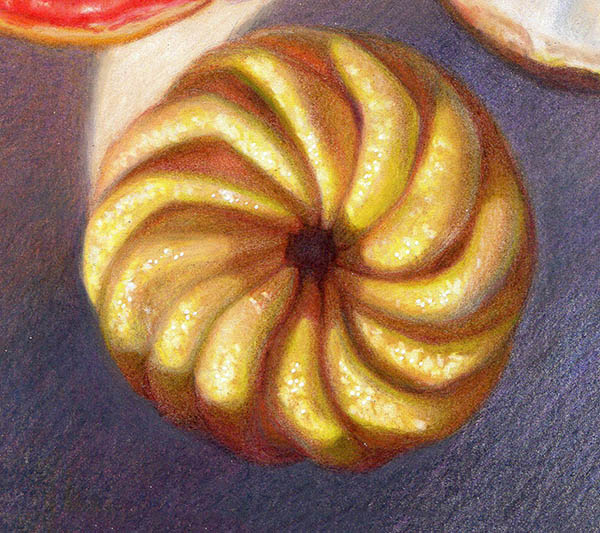
Don’t forget to use a final fixative on your colored pencil drawing. Spray it outdoors in a low-humidity environment. Wear a mask to protect yourself from harmful vapor.
Sign up to my mail list for art tips and news or visit the video courses page if you’d like to take your colored pencil drawing to the next level!
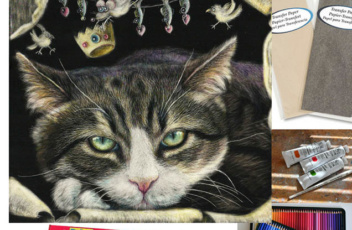
How to use graphite transfer paper to trace your outlines in drawing and painting
Most realist artists use this drawing technique to have a perfect and clean outline drawing. There are several old-fashioned ways of image transfer like the oil transfer, charcoal powder transfer, etc. I find that using graphite transfer paper is the most efficient way of transferring your designs on paper and canvas. The image looks clean and clear.
You must have perfect outlines to begin drawing realistically. When your drawing is complex, it requires sketching, erasing, and sketching again. It ruins the paper’s surface that must stay nice and clean for even shading in graphite or colored pencil. That’s why I often sketch my idea on a separate piece of paper that matches my canvas (or drawing) size to transfer these outlines onto my drawing paper. This image transfer technique was called “cartoon drawings” by the old masters. Classical painters spent weeks doing studies and drawings before transferring them onto panels and canvases.
How to use transfer paper to trace your outline drawing
You need the graphite transfer paper for precise tracing of your lineart or cartoon drawing. If your art is very complex and you wish to keep the working surface clean, use this technique for your advantage.
Graphite Transfer paper brands and features
Saral Graphite Transfer Paper
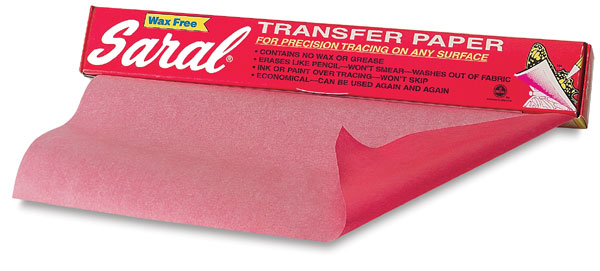
- Comes in 5 colors! Blue, yellow, graphite, white red
- Saral transfer rolls are wax-less, non-toxic, and do not contain acid. The paper allows you to transfer your design from a sketch, pattern, template or by hand to almost any surface. May be used with acetate overlays, plastics and enamel, metal, cloth, wood, fabric, ceramic, canvas, stained glass, tole paintings, architectural work, scrapbooking, watercolor, fine art, and more.
- Shows up equally well on light or dark surfaces.
- 12 inch x 12 foot roll; comes in a roll (similar to a wax paper roll).
Loew-Cornell Black and White Graphite Transfer Papers
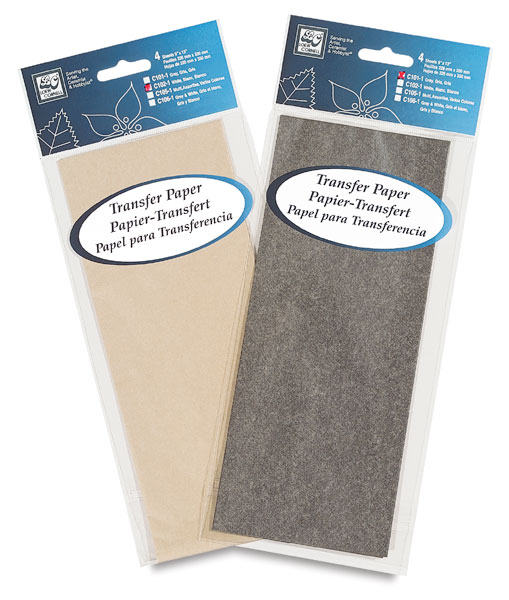
- Waxless, greaseless, smudge proof, erasable
- Doesn’t bleed through paint, and it doesn’t smear.
- Works for drawing and painting but not recommended for fabric and porous surfaces
- Ideal for large projects due to its size. You can also cut it for smaller projects.
- Reusable! I’ve been using my two sheets of graphite paper for years, and it still works fine!
- Comes in as a single, large folded sheet of paper in one package. You need to buy two packages to have different colors. Package of 4 Sheets— Each sheet measures 9″ × 13″ | Single Sheet Package — One 18″ × 36″ sheet
Royal & Langnickel® White Graphite Transfer Paper
- It doesn’t smear, having no wax or grease
- Comes in one 18 x 36 inch sheet of white graphite paper per package.
- Erases similar to a pencil and is very similar to the Loew-Cornell transfer papers.
How to use transfer paper in your art projects
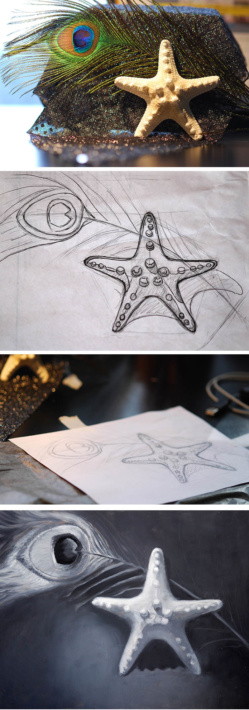
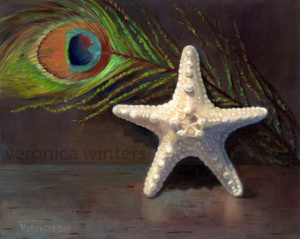
I sketch out my drawing on a sketch paper and then transfer these outlines onto drawing paper using an HB graphite pencil or a ballpoint pen. You can replace the pen or pencil with a stylus if you want to preserve your original reference sketch/photo for future projects. Check out the Soft-Grip Embossing & Stylus Set Complete by Royal & Langnickel (3 Pack) for that.
Is it cheating?
A lot of artists, especially beginners skip the sketching step, transferring the image direct from a photo onto the drawing paper. While it’s totally possible, beware that many pictures have lens distortion that’s especially noticeable in anatomy and photos with linear perspective like cityscapes. So you end up transferring the distortion into your art.
Also, you don’t learn basic drawing skills by simply transferring the image and not learning how to sketch it freehand. However, if your drawing skills are good, this drawing technique is very helpful speeding up the entire process.
Pick the right color of the transfer paper for your project
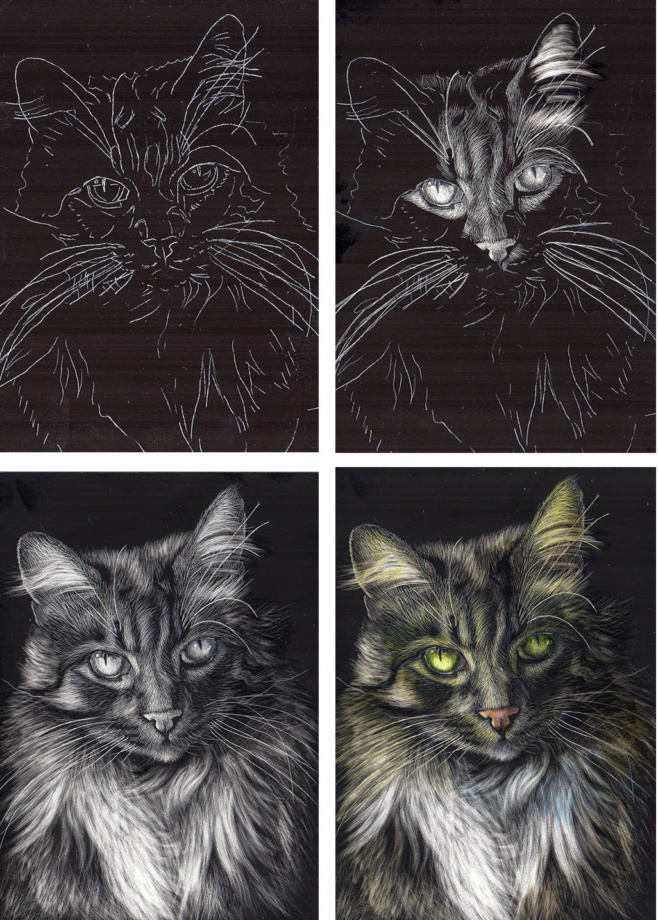
For transferring designs to both white and dark paper white transfer paper is ideal. Also, use the white or yellow transfer paper for your watercolor painting. Black transfer paper’s line doesn’t erase completely and is not suitable for watercolor painting!
Use black transfer paper with caution in your colored pencil drawing as well. I mostly use this black transfer paper for tracing my designs onto canvas/panels, and I often use white transfer paper for my colored pencil drawing, especially when I draw on colored paper because these white outlines show up well and blend with my subsequent shading. White graphite line will show up even on white paper, but you’ll have to observe your lines at a specific angle. I also love to use white graphite transfer paper to transfer my designs working on scratchboard art because the surface must be very clean!
To buy the graphite paper
- Amazon
- JerrysArtarama
- DickBlick
- Michael’s & other craft stores
If you draw in colored pencil, I invite you to watch FREE previews of some of my lessons in my course titled “Veronica Winters complete colored pencil techniques in 90 days.”
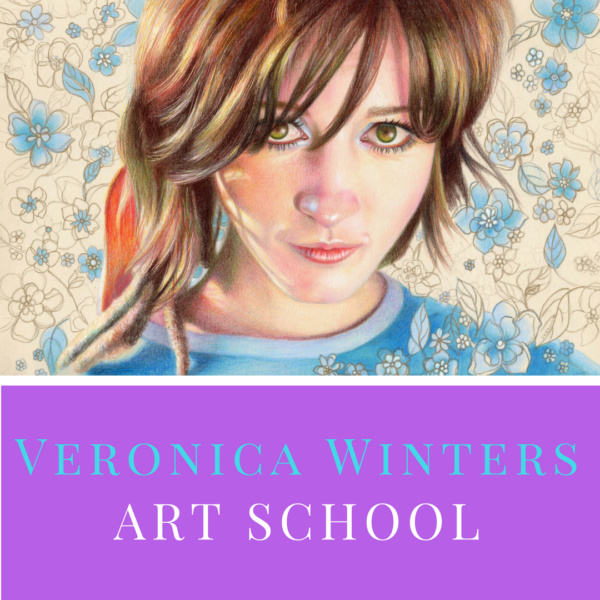
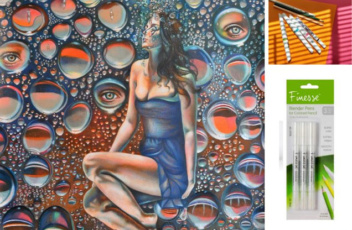
Two solvent-free colored pencil blending techniques
Most of you know that we can blend colored pencils with solvents or the colorless blender. In this article I’d like to share some other blending techniques that don’t require blending with Gamsol. While these blending techniques may not be brand new, I discovered these methods by experimenting with my colored pencil drawing.
Because blending with solvents may look harsh on drawing paper not every drawing is a good candidate for it. I think solvents help a lot when you draw on textured surface or the size of your drawing paper is very large and you want to cover and build the tones in the background. Not every artist likes blending with the solvents. So here is the alternative to that.
Colored pencil blending without the use of solvents
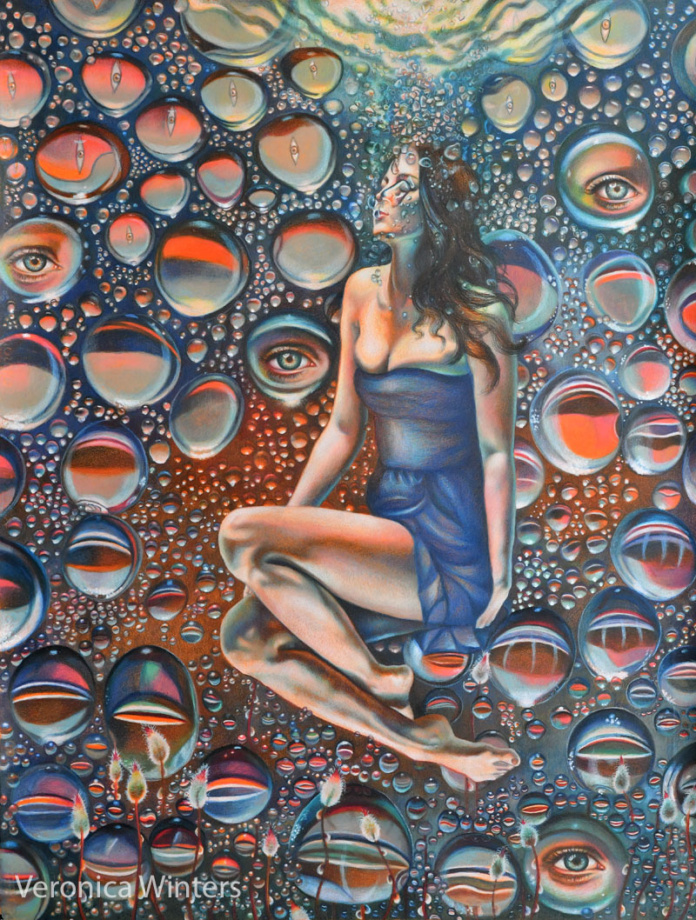
In this drawing titled “Plunge” 19×25″ I used both blending techniques discussed below.
Finesse Colored Pencil blender pen is formulated to blend wax-based colored pencils like Prismacolor Premier and Caran d’Ache Luminance. It won’t do much blending for harder pencils like Polychromos but you’ll still see some blending occurring because all colored pencils have some wax in them.
This pen is very convenient because it has two tips and you can’t spill it like solvents. It’s also non-toxic and easy to carry around or store in a colored pencil box.
I find that it dries out quite quickly however.
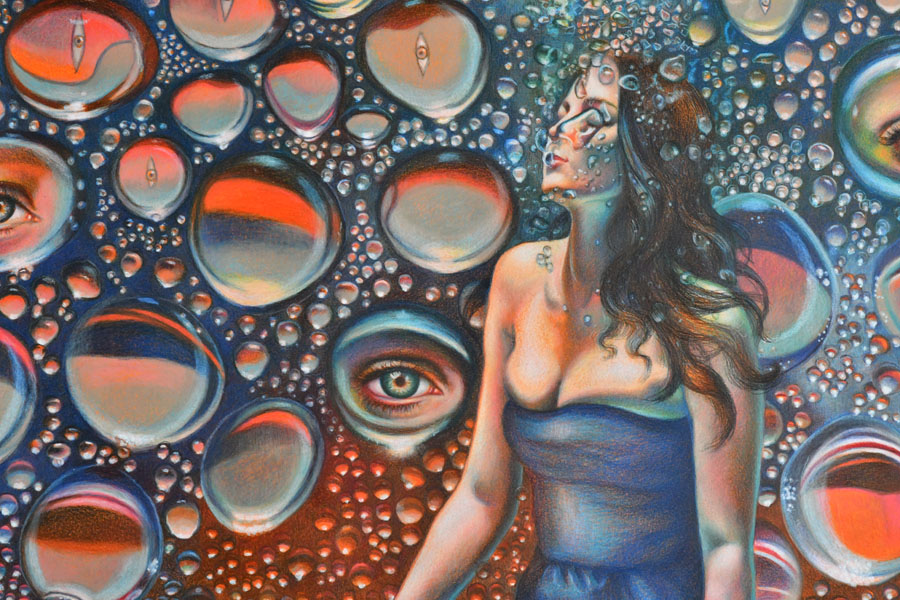
Winsor & Newton Pigment marker, white blender is a very soft white. It’s not suitable to make strong, white highlights but what I discovered working with it is more useful. Once I’ve done some colored pencil shading, I can blend everything with this marker. It does give some white tint to the surface but it also blends colored pencil well. So I use it when I want to both blend and lighten up the area. I think it could be replaced with a different brand to have the same effect but you need to always TEST your art maetrials on a separate piece of paper.
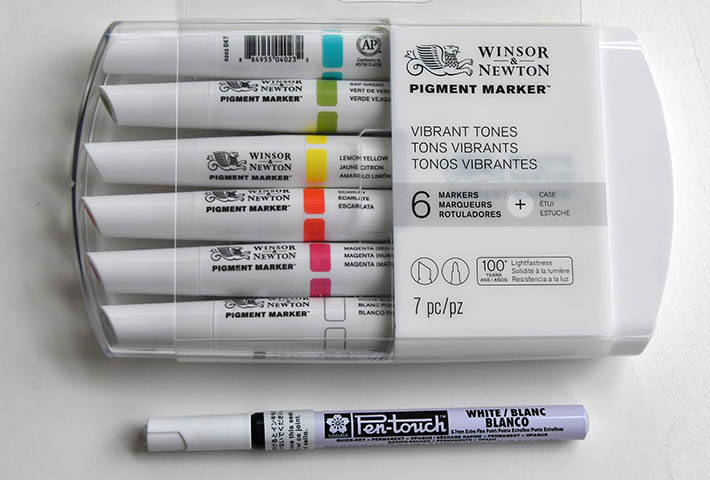
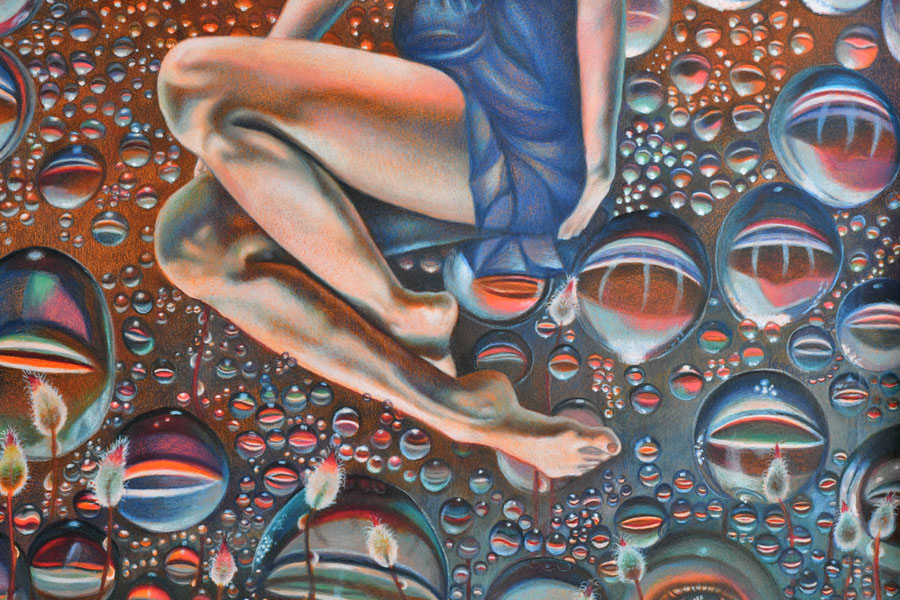
Always test your ideas on a separate piece of paper before committing to actual drawing! It’s very frustrating to ruin your colored pencil drawing testing something new right on it.
Check out all video courses here:https://veronica-winters-art-school.teachable.com/
5 great art gift ideas for women and men
Tired giving same old sweater, candle or mug for the holidays? Looking for meaningful art gifts that inspire and stay in the family for years to enjoy? Here are 5 great art gift ideas for an art enthusiast.
#1 Timeless beauty: portrait paintings
Splurge. Celebrate life with portrait paintings that bring peace and beauty home. Big or small, realistic paintings create soothing atmosphere at home and office.
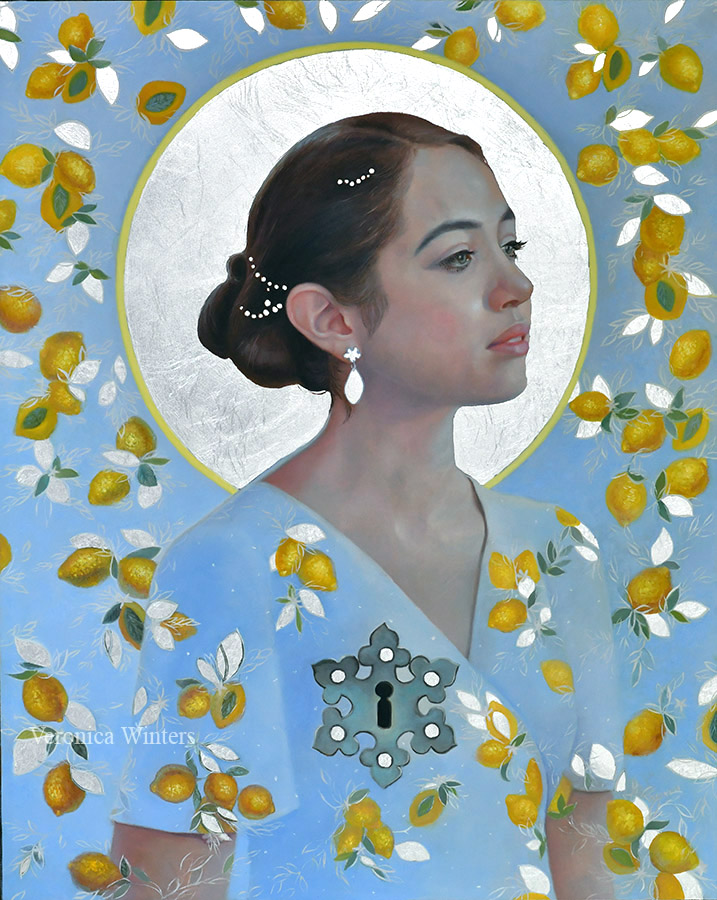
# 2 Personal touch: unique art gift ideas for women
Custom-printed tote bags
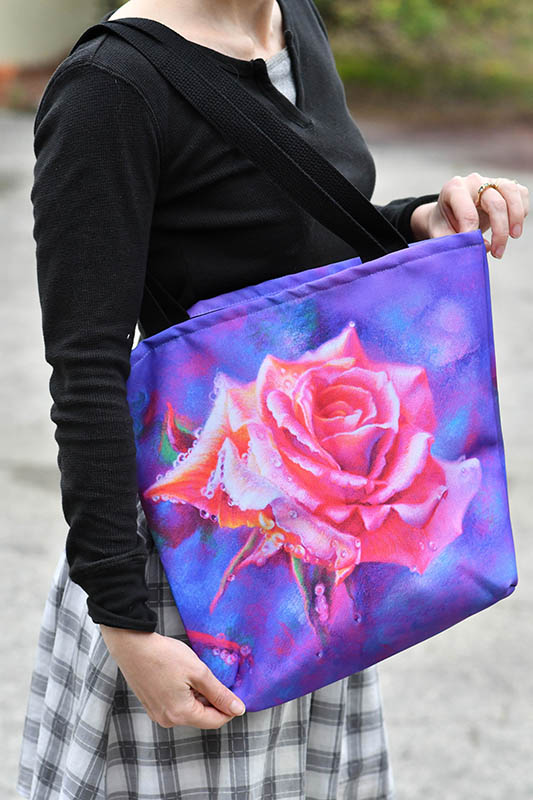
The perfect prep to start her busy day. Our custom-printed, vivid tote bags let her carry stuff to work, beach or go shopping in style. These tote bags come with unexpected benefits: strong handles and high-quality printing. No zipper. Black handles. Identical print is on both sides of the canvas bag.
Order the custom printed tote bags here.
Art Books
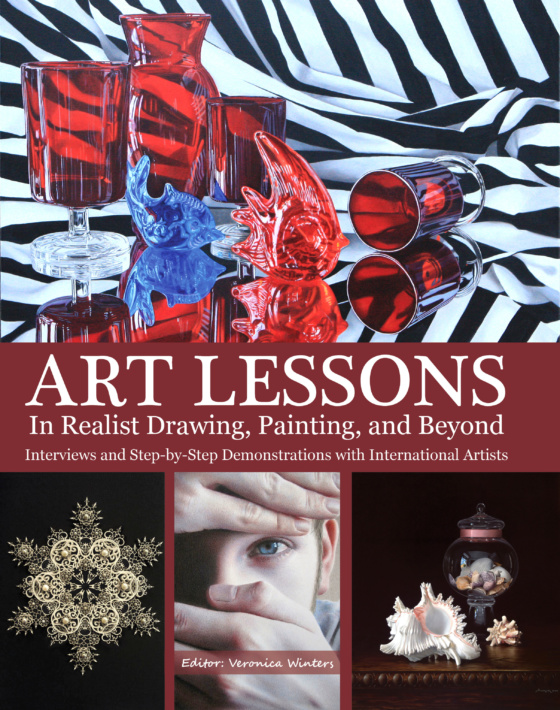
Cheers to the art book that goes wherever she or he does! “Art Lessons in realist drawing, painting, and beyond” includes interviews, pictures and demonstrations from leading contemporary realism artists. Grow your creativity and skill, making art that inspires others. You can order this book on this site or Amazon. https://veronicasart.com/product-category/art-instruction-books/
# 3 Inspiring art posters
Kiss the empty walls good-bye! Affordable art prints help decorate home and office with unique and colorful images. Every art poster is custom printed in California and delivered to your door. Head to the Art Posters section to pick your favorite!
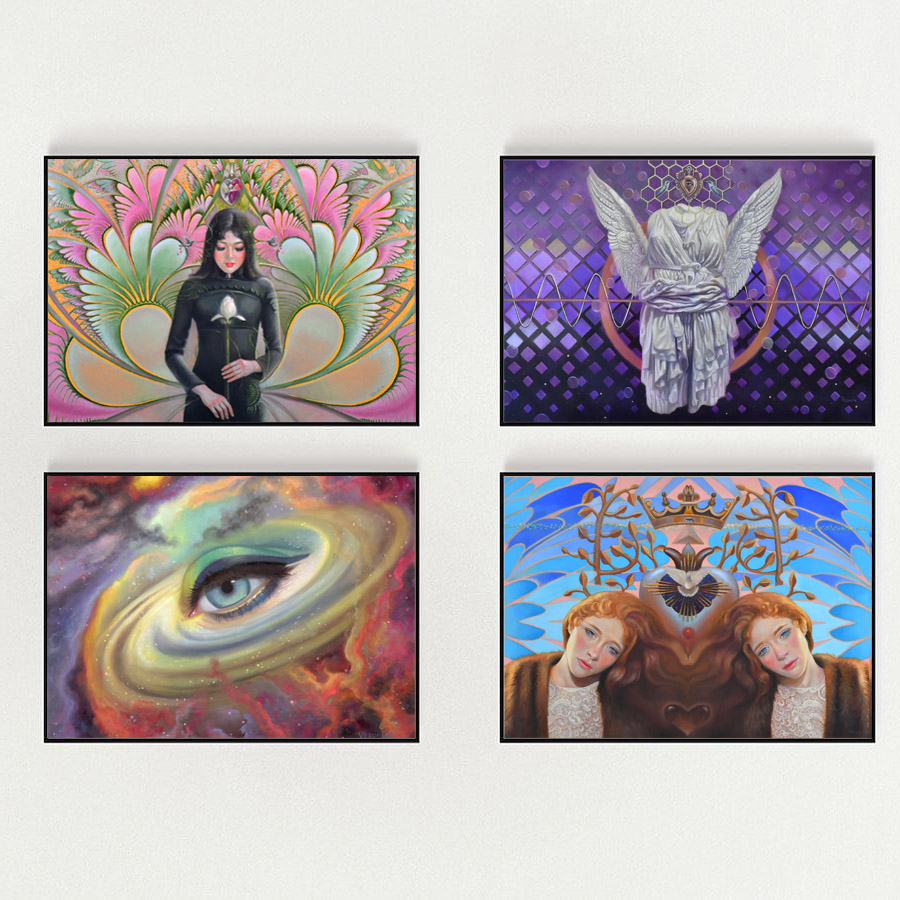
#4 Uplifting as ocean’s breeze: Seascape Necklace handmade pendants with real starfish & sea shells
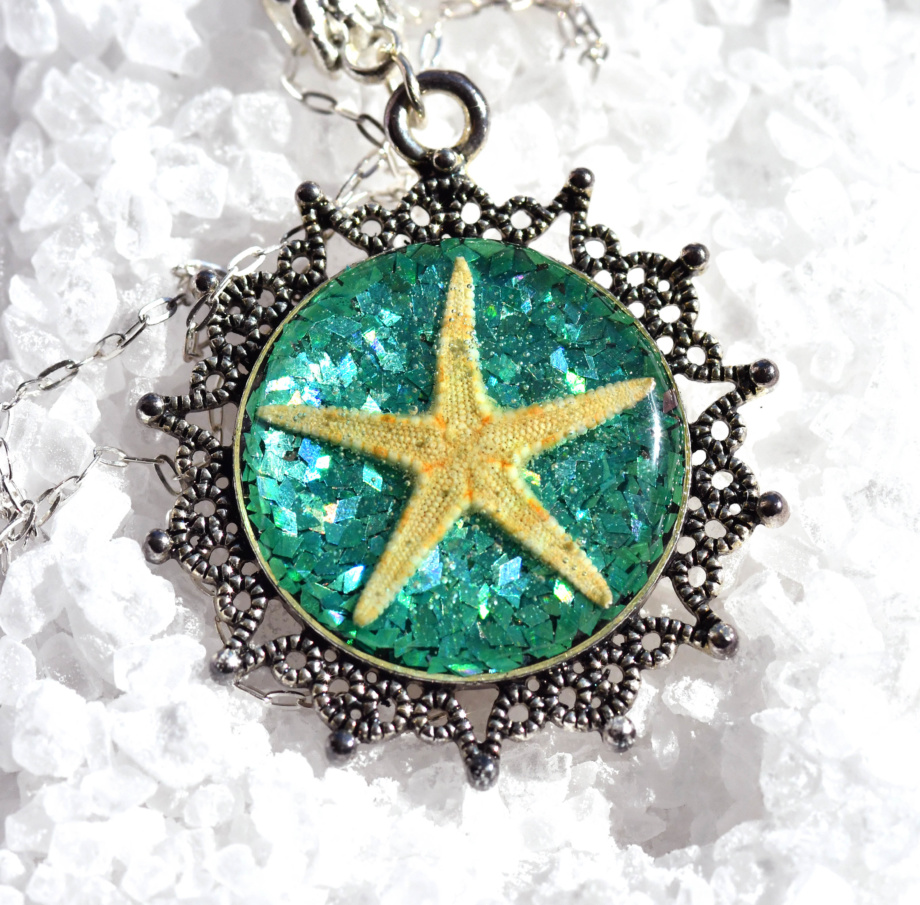
Add a bit of shimmer to her day. These handmade ocean pendants are totally one of a kind that keep fun memories near her heart! Made of resin and glitter, real starfish, sand dollars and seashells, these artful pendants come with sterling silver chains. Contact the artist for details about current selection.
# 5 For a serious beginner in colored pencil drawing: Colored Pencil Techniques Video Course
Give a gift to your mom, dad or that special person who loves to draw. This video course is perfect prep for every beginner in colored pencil drawing. For a limited time when you enroll into this course, you’ll receive promotional pricing and complementary support direct from the artist to complete your projects!
If you are serious about learning and would like to take your colored pencil drawing techniques to the next level, click here to watch a video and several preview lessons from the Veronica Winters Complete Colored Pencil Techniques video course! You’ll learn not only the basics of colored pencil drawing but also some important artistic concepts that make the Artist stand out from a crowd.
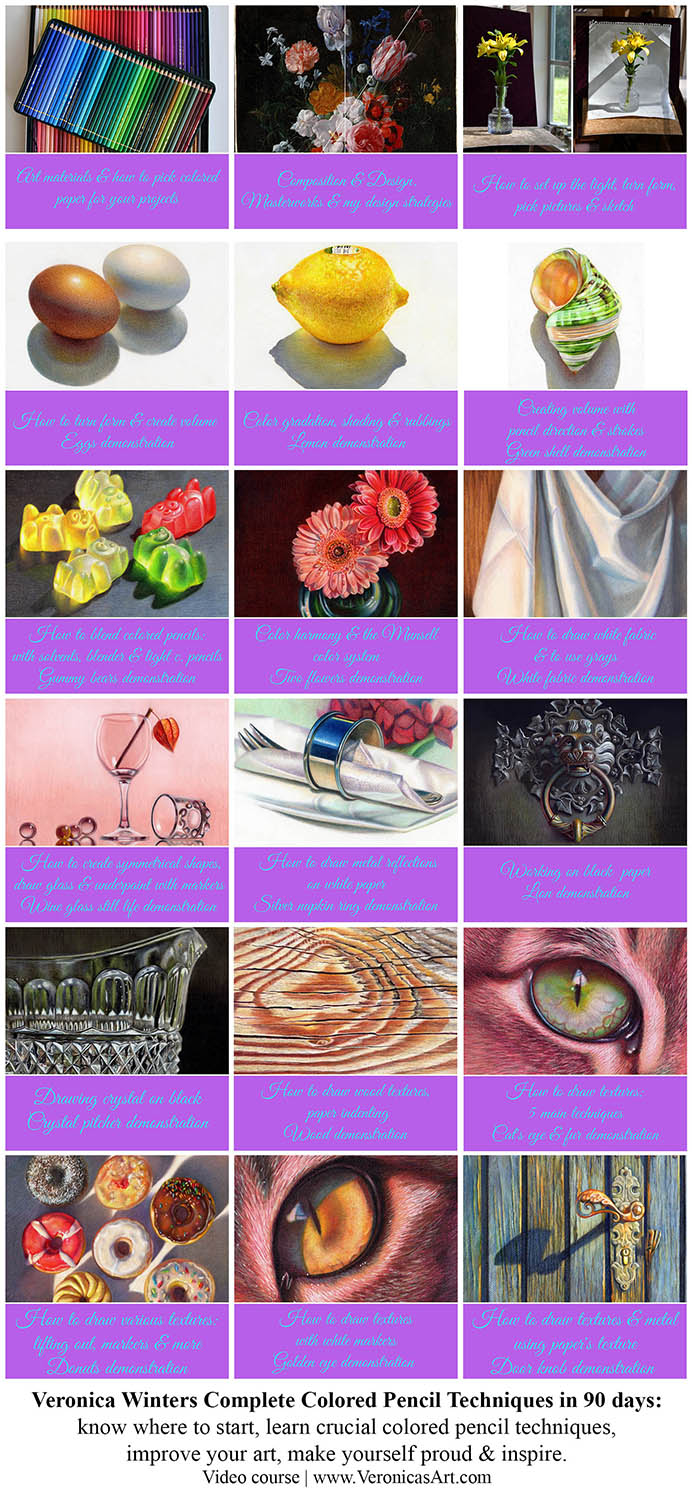
Check out visionary art for sale
Video courses
Enter ”LOVETODRAW” at checkout to get 12% off of any VIDEO COURSE.
Hurry. Limited to the first 50 students only.
Go to all video courses
Mentorship
Art student mentorship is available on a very limited basis. We meet in zoom to discuss your art, progress and any question you might have in drawing or painting. Email communication is available as well. One hour session is $65, which could be split into two half an hour sessions. To discuss your options and to set up a schedule, please email to nika@veronicasart.com . For a limited time I provide email feedback for my Colored Pencil Techniques course.
#1 Comprehensive Colored Pencils Techniques Drawing video course

Designed for beginners in colored pencil drawing, this video course consists of 18 video lessons. In this video course you study how to draw various objects in colored pencils. Each video lesson builds up in progression, focusing on a single object to draw.
- Complementary, downloadable pdf file includes line art, color swatches and materials list. For a limited time the artist provides every student with feedback via email. To check out the previews and enroll, click on the image above to follow the link.
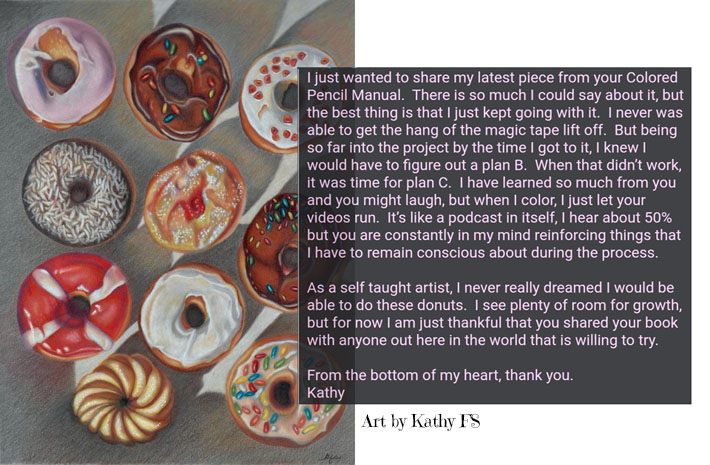
#2 COLOR CRUSH Course for Colored Pencil Artist, video course

#3 Portrait drawing: creating emotion in colored pencil, video course
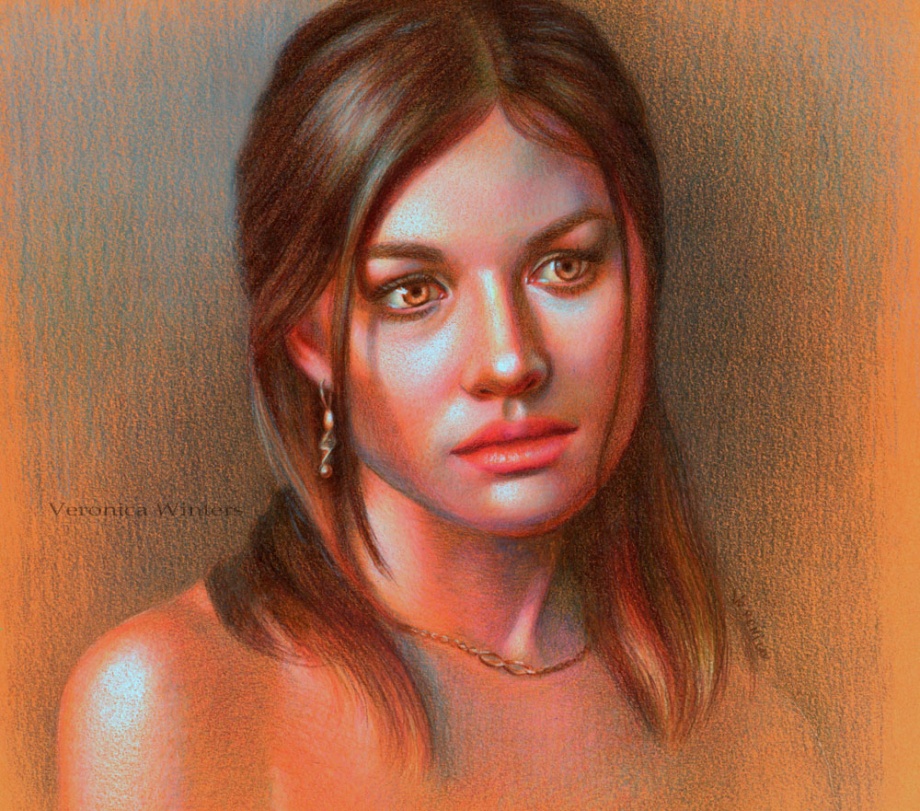
Uncover the secrets to portrait drawing in colored pencil! This unique video course builds up in progression to prepare students to see and capture light on a model, and draw portraits in colored pencil from pictures. Even if you don’t draw from the references, you still get plenty of ideas and information how to create vibrant portraits working in colored pencil.
- The projects consist of lessons- narrated video recordings where the artist draws on various surfaces and explains valuable colored pencil techniques. Some portrait drawing demonstrations include a downloadable reference.
- This course has downloadable color charts/ color list for every demonstration. Click on the image to see a complete curriculum for this class! Enroll today.
#4 Realist oil painting techniques secrets for serious beginners & beyond
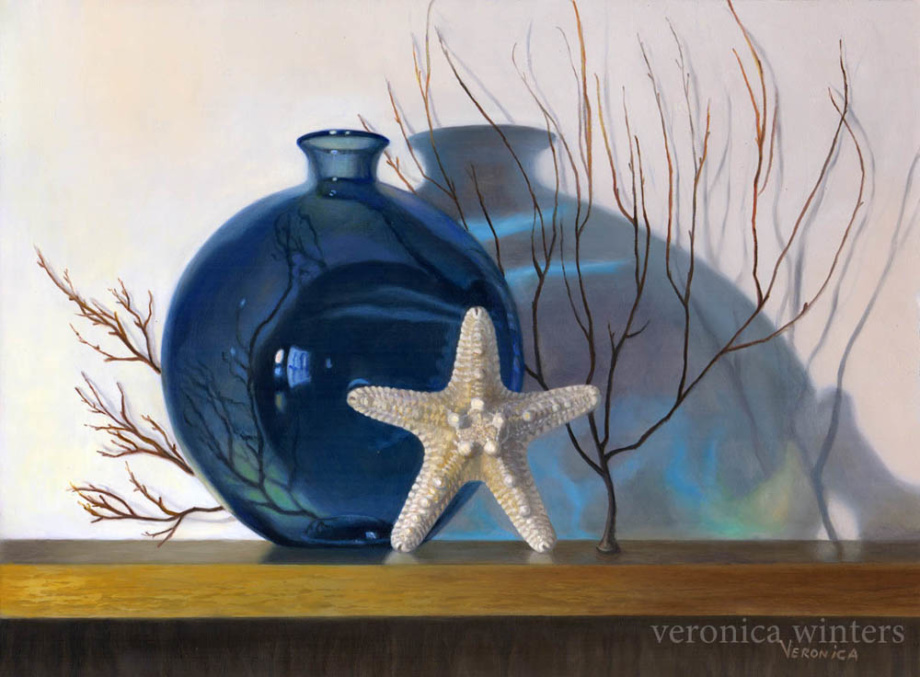
This class is available as online video course now! In this class you’ll see me paint a single still life using traditional oil painting techniques, such as:
- glazing
- grisaille (indirect painting) and
- painting in full color.
I’ll walk you through every step of the painting process that includes:
- prep drawing
- underpainting
- using grays to neutralize chroma (tube colors)
- painting in full color
- painting textures (in a shell)
- painting glass (in a blue vase)
I also include a step-by-step guide (pdf file) that complements the videos. Download it! This class is for serious beginners and more advanced students who already have good understanding of drawing in color, and wish to proceed to the next step – oil painting. This class will give you classical approach to realist painting that you can apply to your daily painting process. It took me many years of schooling and practice to learn this classical approach to painting that’s summarized in this video. Take advantage of this opportunity. Start learning today!
# 5 Step-by-step colored pencil drawing tutorials
Direct link to step-by-step demonstrations: https://veronicasart.com/product-category/step-by-step-drawing-tutorials/
Or you can purchase a buddle of all digital art books and demonstrations for one price here: https://veronica-winters-art-school.teachable.com/p/downloads-tutorials-art-books
You will benefit from these colored pencil demonstrations the most, if you’ve already had some experience in pencil drawing. These demonstrations are not made for the absolute beginners in drawing. Every step-by-step demonstration includes the art supplies list, color chart, and images in steps to complete the exercise.
- The demonstration comes as a digital pdf file that you can save to your computer and work from at your pace. A few demonstrations have drawing videos that are available for download in addition to a pdf file (sold separately).
- When you complete your payment, an automatic email is sent to your inbox. Please check your spam folder as many of my files go there! If you don’t find the e-mail with the demonstration, please e-mail me. nika@veronicasart.com Don’t worry. I’m happy to send it manually.
#6 Art Instruction books
Direct link to books https://veronicasart.com/product-category/art-instruction-books/
These art instruction books feature step-by-step drawings completed in various media, including colored pencil, graphite and even soft pastels. The advantage of buying a digital file rather than a Kindle book is that you can open and see large images on your computer screen. Also, if you have black-and-white kindle, it makes no sense buying the art book that explains how to draw in color.
Every book sells as a digital download that you can save to your computer, and open the file whenever you’re ready to work on your art in colored pencil or paint!
If you live in Europe or any other country, please order art books on Amazon in your country. I can’t ship books overseas.
Watch art instruction videos & previews:
Testimonials:
“A committed artist, author, and teacher, Veronica Winters’s illuminated artwork and attention to detail pushes her to create realistic images that breath life into everyday objects. We are honored to present lessons by Veronica in the quarterly publication of COLORED PENCIL Student”
–Sally Ford, Founder & Editor, COLORED PENCIL Magazine


I attended Veronica’s soft pastel’s class, and she was very inspiring. She gave good individual instruction, building confidence in her students by creating a non-competitive environment. Veronica’s instruction is straight-forward and she has a true desire to help you. I attended her class after decades of doing no art, she inspired me to continue my journey and I have since had my art accepted by and displayed in the Von Liebig Art Center in Naples.
–Clare Roberts
Veronica has been an instructor in our Adult Education program for several years offering a variety of drawing techniques in both classes and workshops. Her classes include teenagers and adults, beginners and more experienced artists, and she provides professional and individual instruction to each student. We feel fortunate to have Veronica teaching in our program.
–Marie L. Doll, Executive Director, Art Alliance of Central PA
The experience of learning to draw with graphite and colored pencils with Veronica as a teacher for me was like learning to grow down and up in the world of art. Expressively up, because with each drawing advice I applied more the nuances of finding the skilled way to make a drawing shine through with life, and fruitfully down because for each finished drawing while looking for her to give the ‘teacher’s final remark’ she would always add: How do you like it?
–Kristina Egumenovska, Fulbright Visiting Research Student, Department of Human Development and Family Studies, The Pennsylvania State University
In a very short time, Veronica has helped me to develop confidence in my artistic ability. Even though I am a beginner, I am progressing rapidly under her direction. She is patient and knows how to nurture a student’s natural talent, while helping the learner to stretch and grow in new areas of understanding (such as how to see and draw proper shapes and tones; working with perspective; how to see, work, and play with color). She is a fabulous artist herself, and learning from her is fun, educational, and inspirational.
–Stelli Munnis
As a teaching artist, Veronica inspires students with her own beautiful paintings and drawings, as well as with her personal attention and gentle, thought-provoking, well-planned, and thorough method of instruction.
–Stephanie Hosier, Assistant Director, Galaxy: The Arts in Education Program of Central Intermediate Unit # 10
I just wanted to say thank you for all your help so far – I’ve really been enjoying the class. This has opened up a whole new world for me. Drawing was something I always wanted to learn how to do, but I used to think you needed to be born with some sort of natural talent. I love finding things I want to draw, and I draw as often as I can at home. It’s something I definitely want to keep doing in the future.
–Brianne Hennel
I was admiring your art and your ability to bring out the full potential of colored pencils! I have to say, I am very impressed. I myself love using colored pencils- they are my favorite medium. By the way, your art work is very inspirational.
–Lauren Foley
Would you like to see your testimonial here? Shoot me an e-mail: nika@veronicasart.com 🙂
Copyright
I reserve all rights to my intellectual property. It is illegal to forward, print, electronically copy, or distribute any digital content from this website or from downloads without prior written permission. If you copy, or forward any content, in any form, or grant access to the digital products to someone else, then you’re guilty of copyright infringement and this is a violation of U.S. and international copyright laws. Violators will be prosecuted to the fullest extent of the law.
